Nikon CXP1 Digital camera with 802.11b/g transmitter User Manual 1 of 3
Nikon Corporation Digital camera with 802.11b/g transmitter 1 of 3
Nikon >
Contents
- 1. User Manual 1 of 3
- 2. User Manual 2 of 3
- 3. User Manual 3 of 3
User Manual 1 of 3
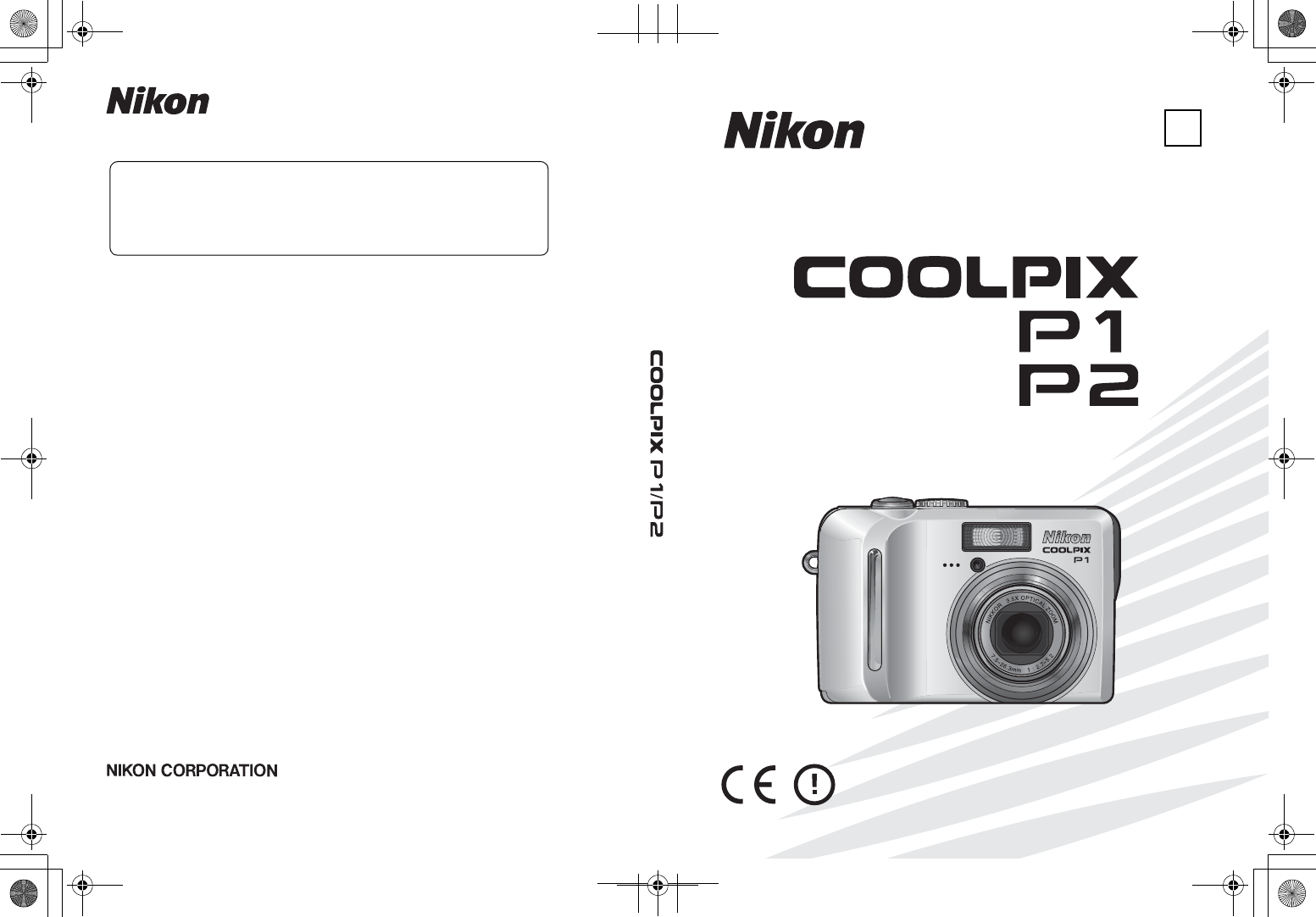
(En)
Printed in Japan
Fuji Bldg., 2-3 Marunouchi 3-chome, XXXXXXXXXXXXX
Chiyoda-ku, Tokyo 100-8331, Japan XXXXXXXX--
No reproduction in any form of this manual, in whole
or in part (except for brief quotation in critical articles
or reviews), may be made without written authoriza-
tion from NIKON CORPORATION.
The Nikon Guide to Digital Photography
with the
En
DIGITAL CAMERA
en_q3175_cover_7.fm Page 1 Thursday, June 16, 2005 11:20 AM
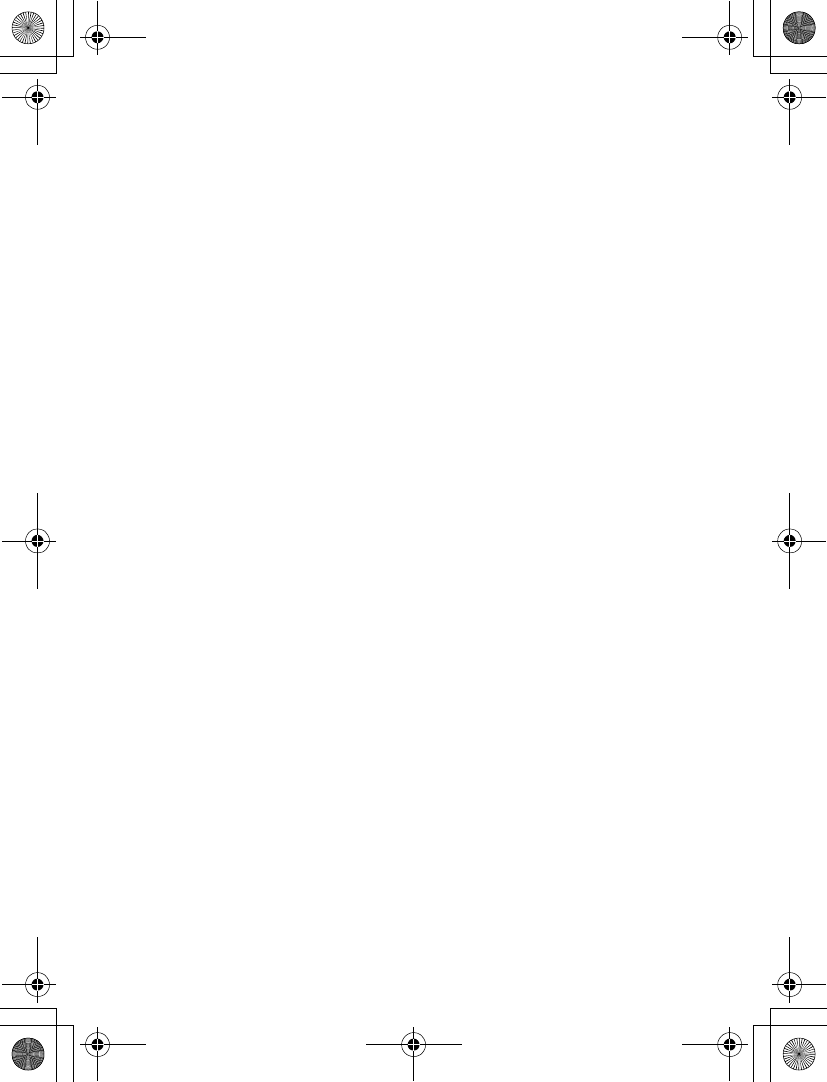
Trademark Information
Apple, the Apple logo, Macintosh, Mac OS, and QuickTime are registered trademarks of Apple
Computer, Inc. Finder is trademark of Apple Computer, Inc. Microsoft and Windows are registered
trademarks of Microsoft Corporation. Internet is a trademark of Digital Equipment Corporation.
Adobe and Acrobat are registered trademarks of Adobe Systems Inc. The SD logo is a trademark of
the SD Card Association. PictBridge is a trademark. Face-priority AF technology is provided by
Identix®. D-Lighting technology is provided by o Apical Limited. All other trade names mentioned
in this manual or the other documentation provided with your Nikon product are trademarks or reg-
istered trademarks of their respective holders.
en_q3175.book Page 1 Thursday, June 16, 2005 10:54 AM
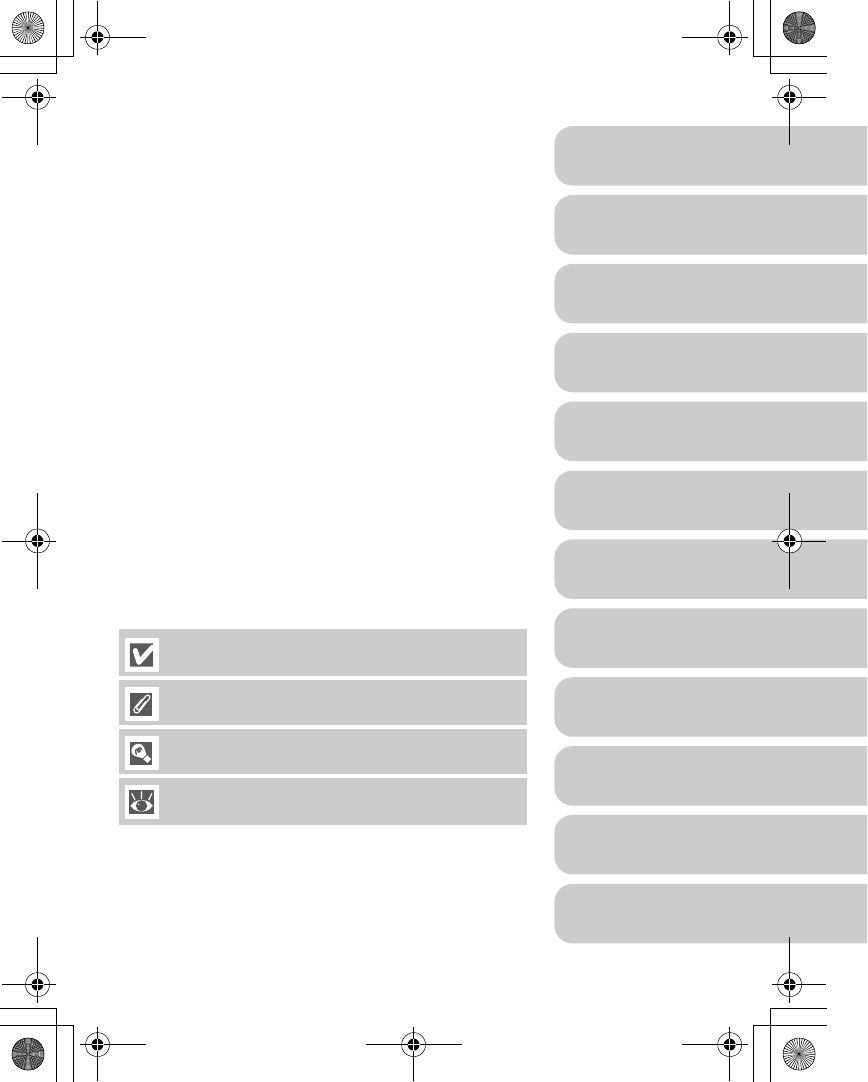
i
Thank you for your purchase of a Nikon COOLPIX P1/P2
digital camera. This manual has been written to help you
enjoy taking pictures with your Nikon digital camera.
Read this manual thoroughly before use, and keep it
handy when using the product.
Symbols Used in this Manual
To make it easier to find the information you need, the
following symbols and conventions are used:
Product Names Used in this Manual
In this manual, the COOLPIX P1 and COOLPIX P2 are
sometimes referred to as P1 and P2, respectively.
Illustrations and on-screen text in this manual may differ
from the actual display.
This icon marks cautions, information that should be
read before use to prevent damage to your camera.
This icon marks notes, information that should be
read before using your camera.
This icon marks tips, additional information that
may be helpful when using your camera.
This icon indicates that more information is available
elsewhere in this manual or in the Quick Start Guide.
Before You Begin
First Steps
Basic Photography
More on Photography
More on Playback
Picture Editing
Movies
The Shooting Menu
The Playback Menu
The Set-up Menu
Wireless Transfer Mode
Technical Notes
en_q3175.book Page i Thursday, June 16, 2005 10:54 AM
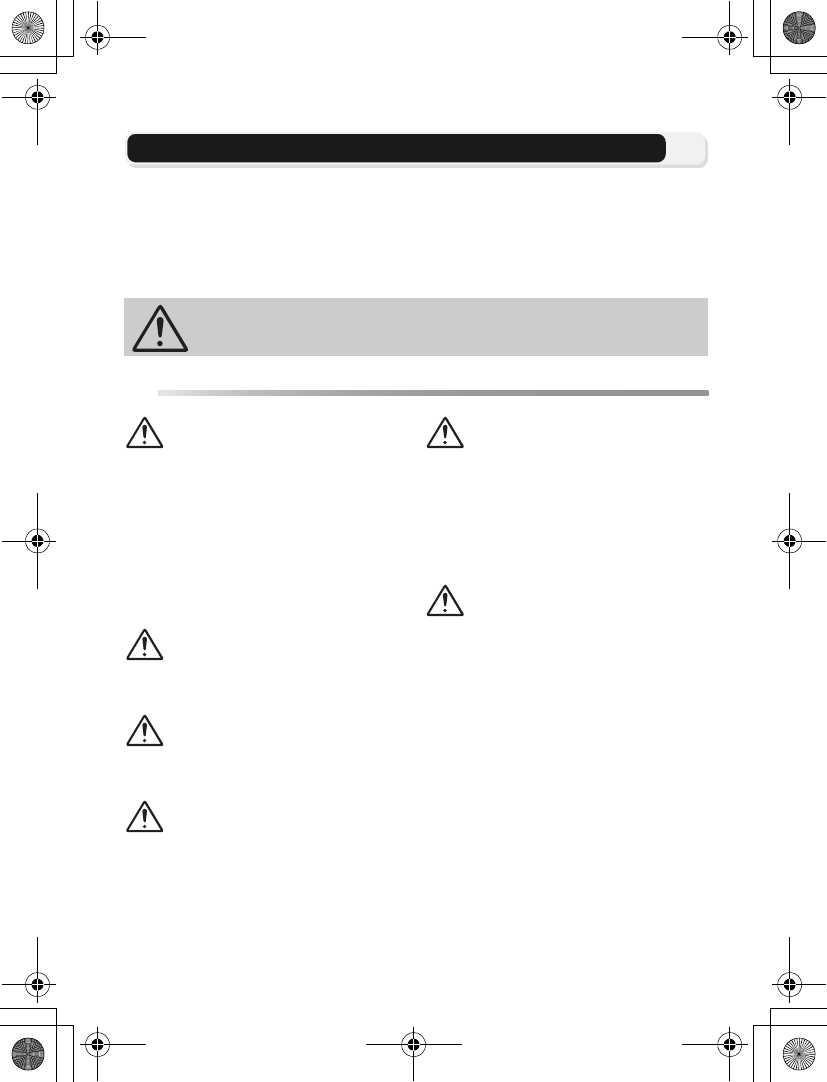
ii
For Your Safety
To prevent damage to your Nikon product or injury to yourself or to others, read
the following safety precautions in their entirety before using this equipment.
Keep these safety instructions where all those who use the product will read
them.
The consequences that could result from failure to observe the precautions listed
in this section are indicated by the following symbol:
This icon marks warnings, information that should be read before using
this product to prevent possible injury.
WARNINGS
Turn off immediately in the
event of malfunction
Should you notice smoke or an
unusual smell coming from the cam-
era, battery charger, or AC adapter
(available separately), unplug the bat-
tery charger or AC adapter and
remove the battery immediately, tak-
ing care to avoid burns. Continued
operation could result in injury. After
removing or disconnecting the power
source, take the equipment to a
Nikon-authorized service representa-
tive for inspection.
Do not use in the presence of
flammable gas
Do not use electronic equipment in
the presence of flammable gas, as this
could result in explosion or fire.
Do not place strap around the
neck of an infant or child
Placing the camera strap around the
neck of an infant or child could result
in strangulation.
Keep out of reach of children
Particular care should be taken to pre-
vent infants from putting the batteries
or other small parts into their mouths.
Do not disassemble
Touching the internal parts of the
camera or battery charger could result
in injury. Repairs should be performed
only by qualified technicians. Should
the camera or battery charger break
open as the result of a fall or other
accident, take the product to a Nikon-
authorized service representative for
inspection after unplugging the prod-
uct and/or removing the battery.
Observe the following precau-
tions when handling the battery
charger
• Keep dry. Failure to observe this
precaution could result in fire or
electric shock.
• Dust on or near the metal parts of
the plug should be removed with a
dry cloth. Continued use could
result in fire.
• Do not handle the power cable or
go near the battery charger during
thunderstorms. Failure to observe
this precaution could result in elec-
tric shock.
• Do not damage, modify, forcibly
tug or bend the power cable, place
it under heavy objects, or expose it
to heat or flame. Should the insula-
tion be damaged and the wires
become exposed, take it to a
Nikon-authorized service represen-
tative for inspection. Failure to
observe these precautions could
result in fire or electric shock.
en_q3175.book Page ii Thursday, June 16, 2005 11:27 AM
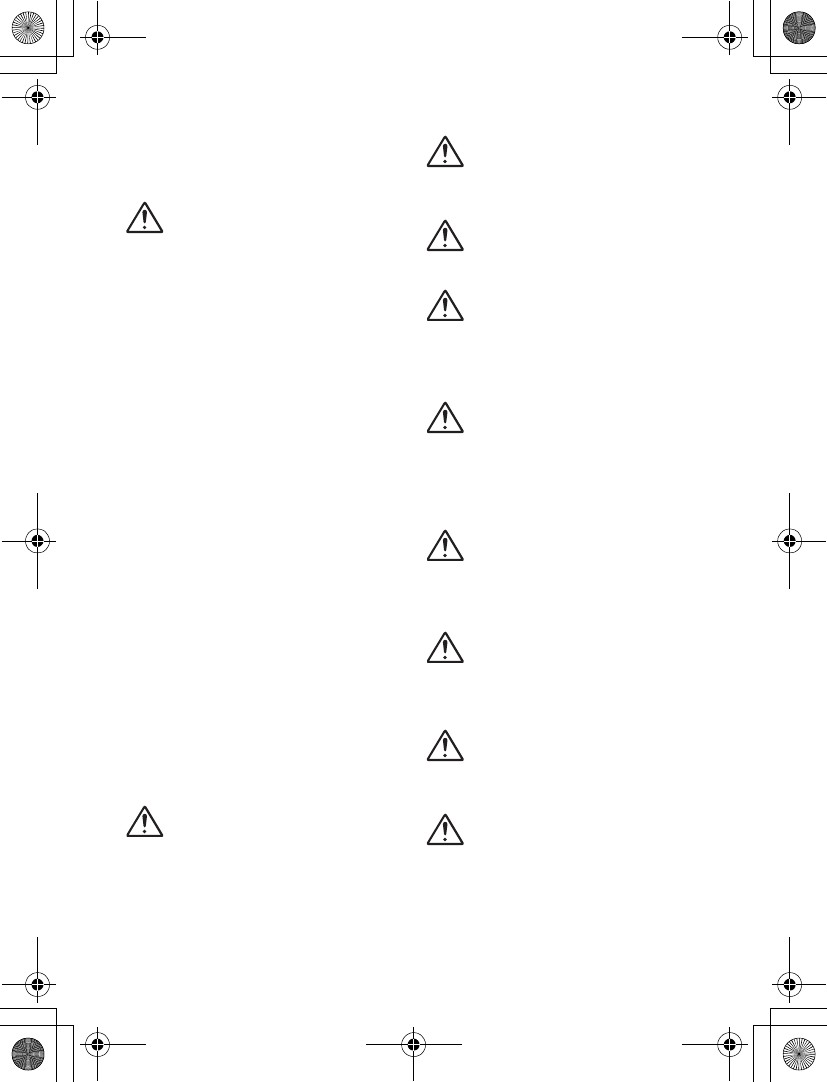
iii
• Do not handle the plug or battery
charger with wet hands. Failure to
observe this precaution could result
in electric shock.
Observe proper precautions
when handling batteries
Batteries may leak or explode if
improperly handled. Observe the fol-
lowing precautions when handling a
battery for use in this product:
• Before replacing the battery, turn
the product off and make sure the
power-on lamp has gone out. If
you are using an AC adapter, be
sure it is unplugged.
• Before replacing the battery, turn
the product off. If you are using an
AC adapter, be sure it is unplugged.
• Use only rechargeable Nikon EN-
EL8 lithium-ion batteries (supplied).
• When inserting the battery, do not
attempt to insert it upside down or
backwards.
• Do not short or disassemble batteries.
• Do not expose batteries to flame or
to excessive heat.
• Do not immerse in or expose to water.
• Replace the terminal cover when
transporting the battery. Do not
transport or store with metal objects
such as necklaces or hairpins.
• Batteries are prone to leakage
when fully discharged. To avoid
damage to the product, be sure to
remove the battery when no
charge remains.
• Immediately after use, or when the
product is used on battery power
for an extended period, the battery
may become hot. Before removing
the battery, turn the camera off
and allow the battery to cool.
• Discontinue use immediately
should you notice any change in
the battery, such as discoloration or
deformation.
Use appropriate cables, batter-
ies, battery chargers, and AC
adapters
Use only the cables, batteries, battery
chargers, and AC adapters provided or
sold by Nikon for the purpose, to
maintain compliance with product
regulations.
Removing memory cards
Memory cards may become hot dur-
ing use. Observe due caution when
removing memory cards from the
camera.
Handle moving parts with care
Be careful that your fingers or other
objects are not pinched by the lens or
other moving parts.
CD-ROMs
The CD-ROMs on which the software
and manuals are distributed should
not be played back on audio CD
equipment. Playing CD-ROMs on an
audio CD player could cause hearing
loss or damage the equipment.
Observe caution when operat-
ing the flash
Using the flash close to your subject’s
eyes could cause temporary visual
impairment. Particular care should be
observed if photographing infants,
when the flash should be no less than
one meter (39”) from the subject.
Do not fire the unit while the
flash head is touching a person
or object
Such use can result in the person being
burned, and/or their clothes igniting
from the heat of the flash’s firing.
Avoid contact with liquid crystal
Should the monitor break, care should
be taken to avoid injury due to broken
glass and to prevent liquid crystal from
the monitor touching the skin or
entering the eyes or mouth.
Keep dry
Do not immerse in or exposure to
water. Continuing to use the product
under such circumstances may cause
fire or an electric shock.
Follow the instructions of
hospital and airline personnel
This device emits radio frequency radi-
ation that could interfere with medical
or navigational equipment. Do not use
this device in a hospital or on board an
airplane without first obtaining the
permission of hospital or airline staff.
en_q3175.book Page iii Thursday, June 16, 2005 11:27 AM
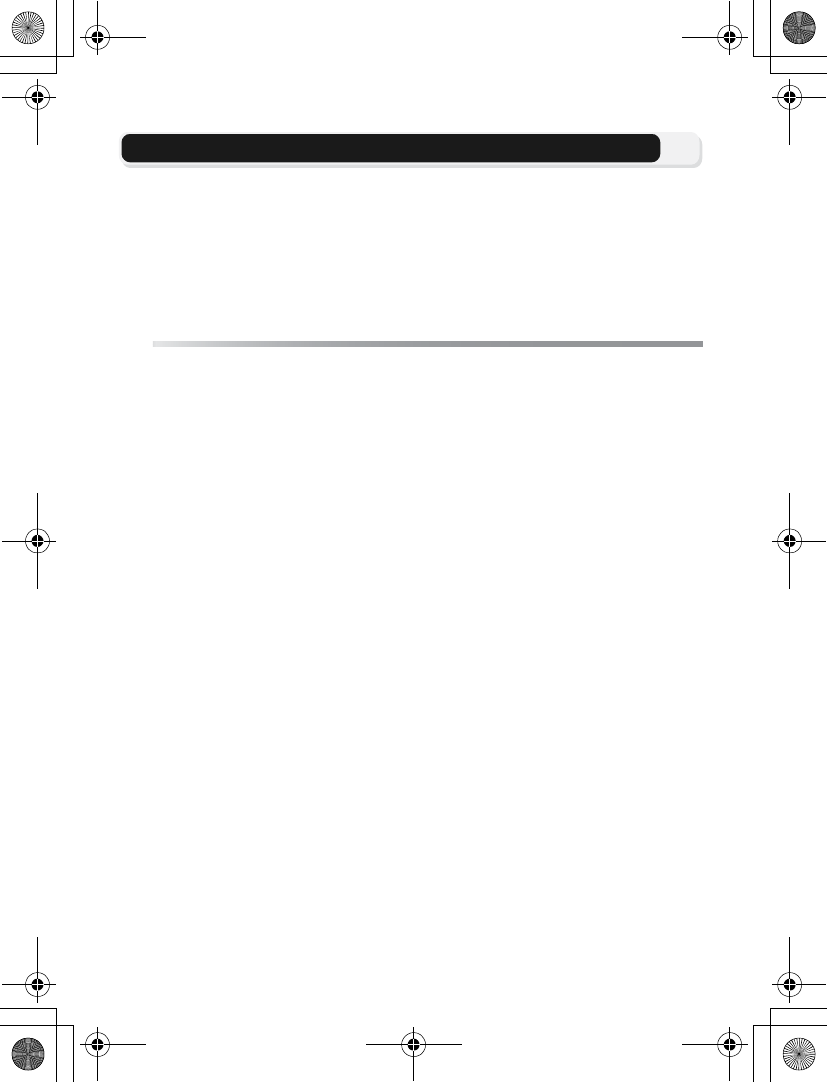
iv
Notices
•No part of the manuals included with this prod-
uct may be reproduced, transmitted, transcribed,
stored in a retrieval system, or translated into any
language in any form, by any means, without
Nikon’s prior written permission.
•Nikon reserves the right to change the specifica-
tions of the hardware and software described in
these manuals at any time and without prior no-
tice.
•Nikon will not be held liable for any damages re-
sulting from the use of this product.
•While every effort has been made to ensure that
the information in these manuals is accurate and
complete, we would appreciate it were you to
bring any errors or omissions to the attention of
the Nikon representative in your area (address
provided separately).
Notice for customers in the U.S.A.
Federal Communications Commission (FCC)
Declaration of Conformity
This device complies with Part 15 of the FCC
rules. Operation of the device is subject to the
following two conditions: (1) this device may
not cause harmful interference, and (2) this
device must accept any interference received,
including interference that may cause undesired
operation.
Products that contain a radio transmitter are
labeled with FCC ID and may also carry the FCC
logo.
FCC Radio Frequency Interference State-
ment
This equipment has been tested and found to
comply with the limits for a Class B digital
device, pursuant to Part 15 of the FCC rules.
These limits are designed to provide reasonable
protection against harmful interference in a res-
idential installation. This equipment generates,
uses, and can radiate radio frequency energy
and, if not installed and used in accordance with
the instructions, may cause harmful interference
to radio communications. However, there is no
guarantee that interference will not occur in a
particular installation. If this equipment does
cause harmful interference to radio or television
reception, which can be determined by turning
the equipment off and on, the user is encour-
aged to try to correct the interference by one or
more of the following measures:
•Reorient or relocate the receiving antenna.
•Increase the separation between the equipment
and receiver.
•Connect the equipment into an outlet on a cir-
cuit different from that to which the receiver is
connected.
•Consult the dealer or an experienced radio/tele-
vision technician for help.
FCC Radiation Exposure Statement
The available scientific evidence does not show
that any health problems are associated with
using low power wireless devices. There is no
proof, however, that these low power wireless
devices are absolutely safe. Low power Wireless
devices emit low levels of radio frequency
energy (RF) in the microwave range while being
used. Whereas high levels of RF can produce
health effects (by heating tissue), exposure to
low level RF that does not produce heating
effects causes no known adverse health effects.
Many studies of low level RF exposures have not
found any biological effects. Some studies have
suggested that some biological effects might
occur, but such findings have not been con-
firmed by additional research. The NIKON
COOLPIX P1/P2 has been tested and found to
comply with the Federal Communications Com-
mission (FCC) guidelines on radio frequency
energy (RF) exposures. The maximum SAR levels
tested for the NIKON COOLPIX P1/P2 has been
shown to be 0.208 W/kg at Body.
This device should not be co-located or oper-
ated with any other antenna or transmitter.
en_q3175.book Page iv Thursday, June 16, 2005 11:27 AM
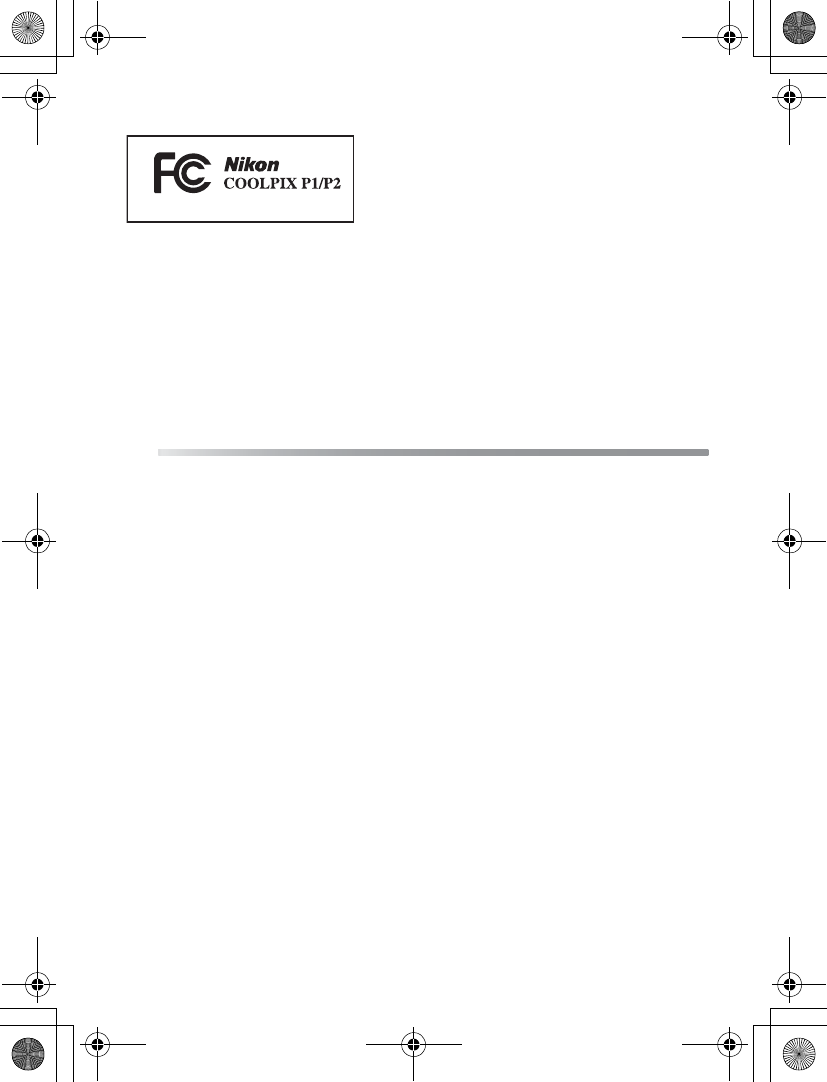
v
CAUTIONS
Modifications
The FCC requires the user to be notified that any
changes or modifications made to this device
that are not expressly approved by Nikon
Corporation may void the user’s authority to
operate the equipment.
Interface Cables
Use the interface cables sold or provided by
Nikon for your equipment. Using other interface
cables may exceed the limits of Class B Part 15
of the FCC rules.
Notice for customers in the State of
California
WARNING: Handling the cord on this product
will expose you to lead, a chemical known to the
State of California to cause birth defects or
other reproductive harm. Wash hands after
handling.
Nikon Inc.,
1300 Walt Whitman Road, Melville, New York
11747-3064, U.S.A.
Tel.: 631-547-4200
Notice for customers in Canada
CAUTION
This class B digital apparatus meets all
requirements of the Canadian Interference
Causing Equipment Regulations.
RSS-210 14. Exposure of Humans to RF
Fields
The installer of this radio equipment must
ensure that the antenna is located or pointed
such that it does not emit RF field in excess
of Health Canada limits for the general pop-
ulation; consult Safety Code 6, obtainable
from Health Canada’s website
www.hc-sc.gc.ca/rpb
ATTENTION
Cet appareil numéique de la classe B
respecte toutes les exigences du Règlement
sur le matériel brouilleur du Canada.
en_q3175.book Page v Thursday, June 16, 2005 11:42 AM
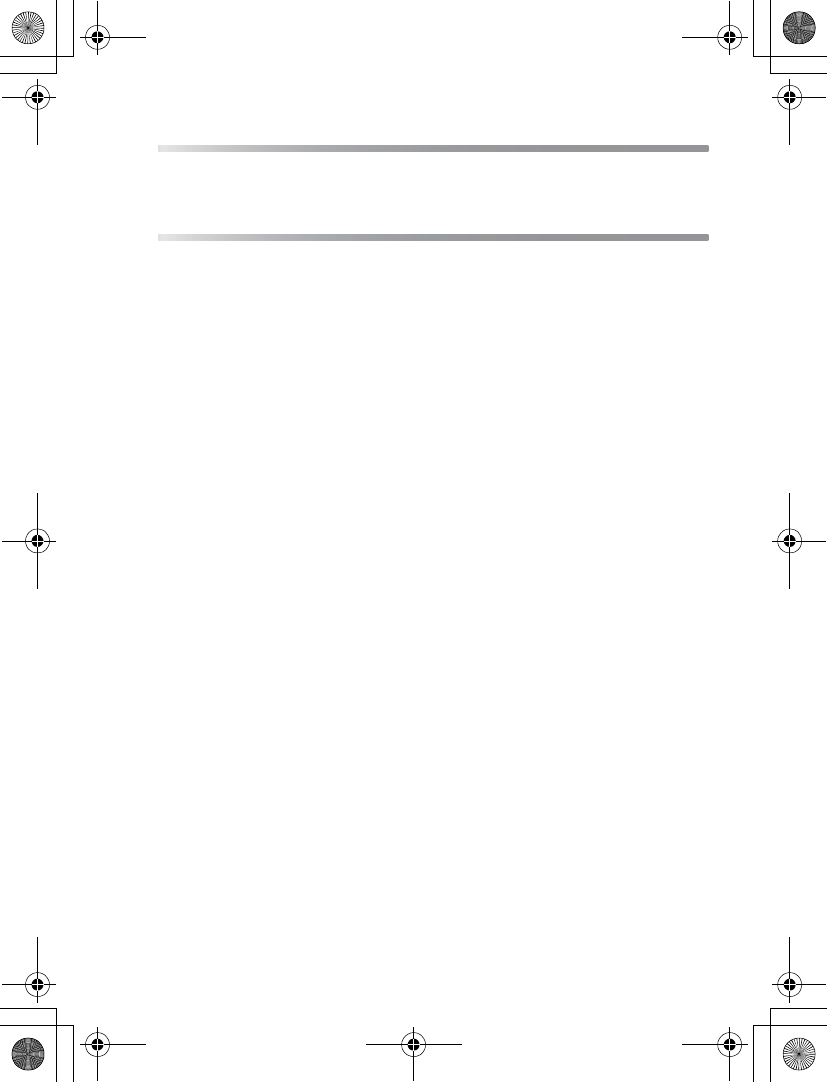
vi
Notice for customers in Europe
Hereby, Nikon, declares that this digital camera is in compliance with the essential require-
ments and other relevant provisions of Directive 1999/5/EC.
Notice Concerning Prohibition of Copying or Reproduction
Note that simply being in possession of material that has been digitally copied or reproduced
by means of a scanner, digital camera or other device may be punishable by law.
• Items prohibited by law from being copied
or reproduced
Do not copy or reproduce paper money, coins,
securities, government bonds, or local govern-
ment bonds, even if such copies or reproductions
are stamped “Sample”.
The copying or reproduction of paper money,
coins, or securities which are circulated in a for-
eign country is prohibited.
Unless the prior permission of the government
has been obtained, the copying or reproduction
of unused postage stamps or post cards issued
by the government is prohibited.
The copying or reproduction of stamps issued by
the government and of certified documents stip-
ulated by law is prohibited.
• Cautions on certain copies and reproduc-
tions
The government has issued cautions on copies or
reproductions of securities issued by private
companies (shares, bills, checks, gift certificates,
etc.), commuter passes, or coupon tickets, ex-
cept when a minimum of necessary copies are to
be provided for business use by a company. Also,
do not copy or reproduce passports issued by the
government, licenses issued by public agencies
and private groups, ID cards, and tickets, such as
passes and meal coupons.
• Comply with copyright notices
The copying or reproduction of copyrighted cre-
ative works such as books, music, paintings,
woodcut prints, maps, drawings, movies, and
photographs is governed by national and inter-
national copyright laws. Do not use this product
for the purpose of making illegal copies or to in-
fringe copyright laws.
en_q3175.book Page vi Thursday, June 16, 2005 11:27 AM
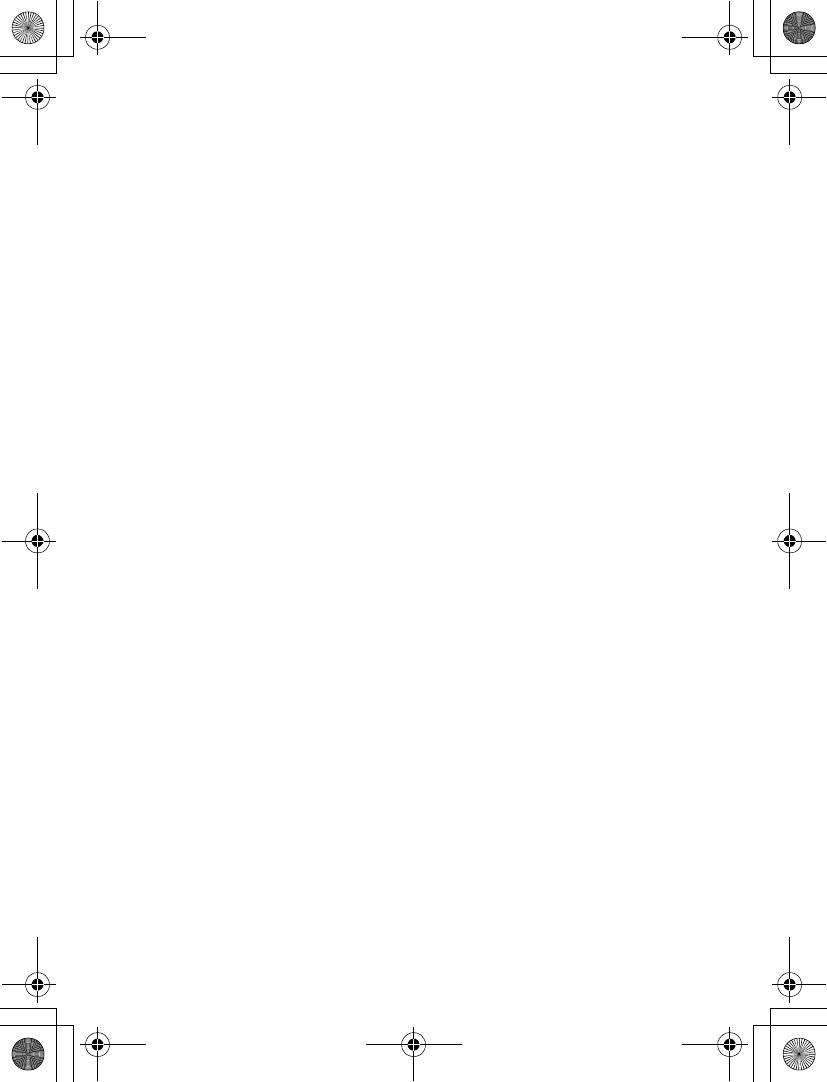
vii
en_q3175.book Page vii Thursday, June 16, 2005 11:52 AM
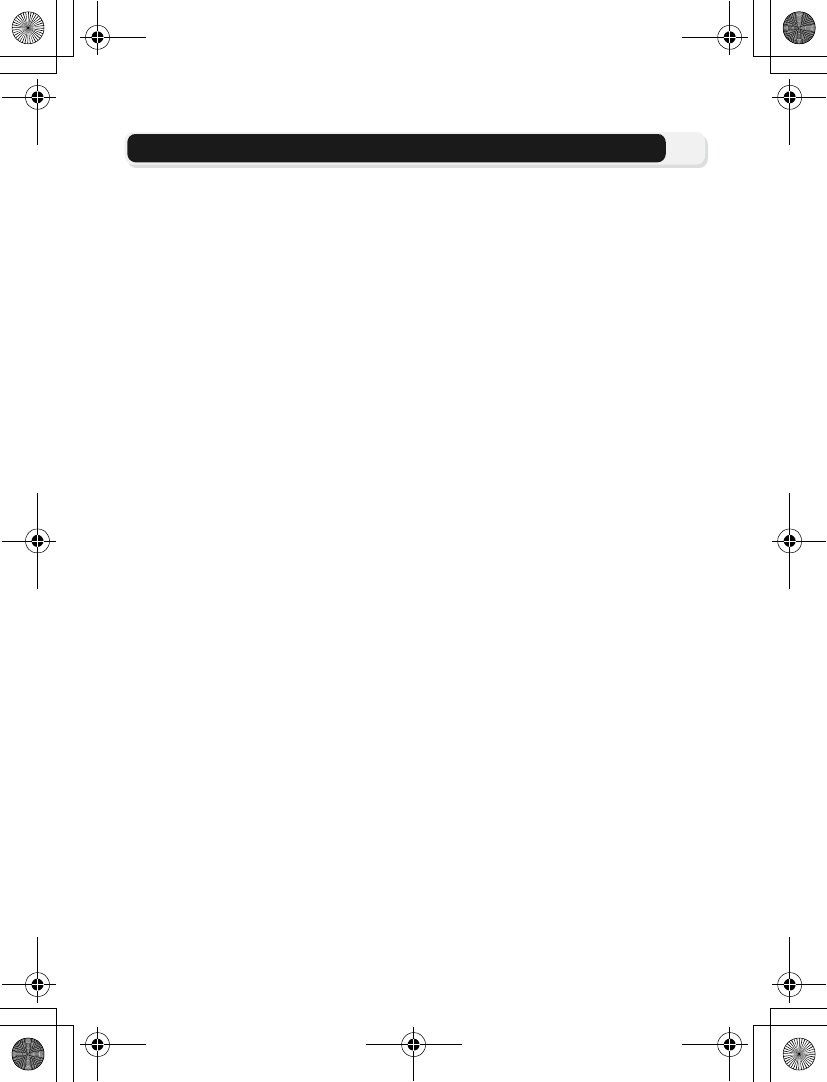
viii
Table of Contents
For Your Safety .................................................................................................................... ii
Notices ............................................................................................................................... iv
Table of Contents ............................................................................................................. viii
Before You Begin ................................................................................ 1
Introduction........................................................................................................................ 1
Parts of the Camera............................................................................................................ 2
The Monitor........................................................................................................................ 4
The Mode Dial .................................................................................................................... 6
Navigating the Menus......................................................................................................... 7
Displaying the Help ............................................................................................................. 7
First Steps............................................................................................. 8
Charging the Battery........................................................................................................... 8
Inserting Batteries ............................................................................................................. 10
Inserting Memory Cards.................................................................................................... 12
Checking the Battery Level................................................................................................ 14
Basic Setup ....................................................................................................................... 16
Basic Photography............................................................................. 18
Step 1–Select X (auto) Mode ......................................................................................... 18
Step 2–Frame the Picture .................................................................................................. 20
Step 3–Focus and Shoot.................................................................................................... 22
Step 4–View the Results (Full-screen Playback) .................................................................. 24
More on Photography....................................................................... 26
C When Lighting Is Poor: Using the Flash .......................................................................... 27
H Taking a Self-Portrait: Using the Self-Timer................................................................... 30
F Focusing on the Subject: Using Focus Mode ................................................................. 31
I Controlling Exposure: Exposure Compensation ............................................................. 33
b Scene Mode ............................................................................................................. 34
Controlling Exposure: Exposure Modes ............................................................................. 45
Z Controlling File Size: Selecting Image Quality and Size ................................................. 47
W Taking Pictures Using Sensitivity: Setting Sensitivity .................................................... 50
d Adjusting the Hue: Using White Balance.................................................................... 52
More on Playback.............................................................................. 55
Viewing Pictures on the Camera ....................................................................................... 55
Voice Memos: Recording and Playback ............................................................................. 58
Viewing Pictures on TV ..................................................................................................... 60
Viewing Pictures on a Computer ....................................................................................... 61
Printing Pictures ................................................................................................................ 65
w Print Set ....................................................................................................................... 66
Printing via Direct USB Connection.................................................................................... 70
en_q3175.book Page viii Thursday, June 16, 2005 10:54 AM
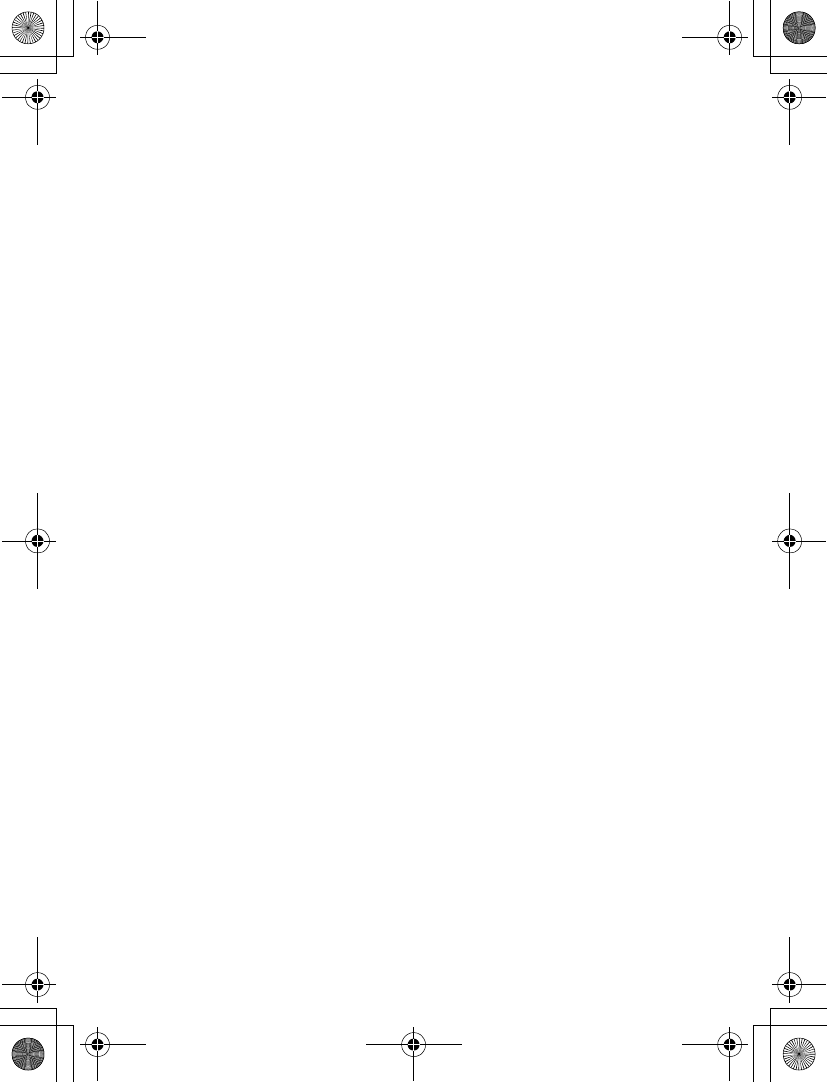
ix
Picture Editing.................................................................................... 76
Available Picture Editing .................................................................................................... 76
Cropping Pictures – Crop .................................................................................................. 77
Enhancing Contrast: D-Lighting......................................................................................... 78
H Creating a Smaller Picture: Small Pic ............................................................................ 79
Movies................................................................................................ 80
S Recording Movies ......................................................................................................... 80
Viewing Movies................................................................................................................. 85
The Shooting Menu........................................................................... 86
Using the Shooting Menu.................................................................................................. 86
m Metering..................................................................................................................... 88
q Continuous ................................................................................................................. 89
A Best Shot Selector ...................................................................................................... 92
C Auto Bracketing......................................................................................................... 93
E Flash Exp. Comp......................................................................................................... 94
F Image Adjustment........................................................................................................ 94
M Image Sharpening ...................................................................................................... 95
P Saturation Control ....................................................................................................... 96
k AF Area Mode ............................................................................................................ 97
Y Auto-focus Mode...................................................................................................... 100
Fixed Aperture................................................................................................................. 100
o Noise Reduction ......................................................................................................... 101
q Reset .......................................................................................................................... 102
r User Setting............................................................................................................... 103
The Playback Menu ......................................................................... 104
Using the Playback Menu ................................................................................................ 104
List by Date ..................................................................................................................... 107
z Slide Show ................................................................................................................ 109
A Delete ......................................................................................................................... 111
D Protect .................................................................................................................... 112
E Transfer Marking ..................................................................................................... 112
G Hide Image ............................................................................................................... 113
L Copy ........................................................................................................................ 114
en_q3175.book Page ix Thursday, June 16, 2005 10:54 AM
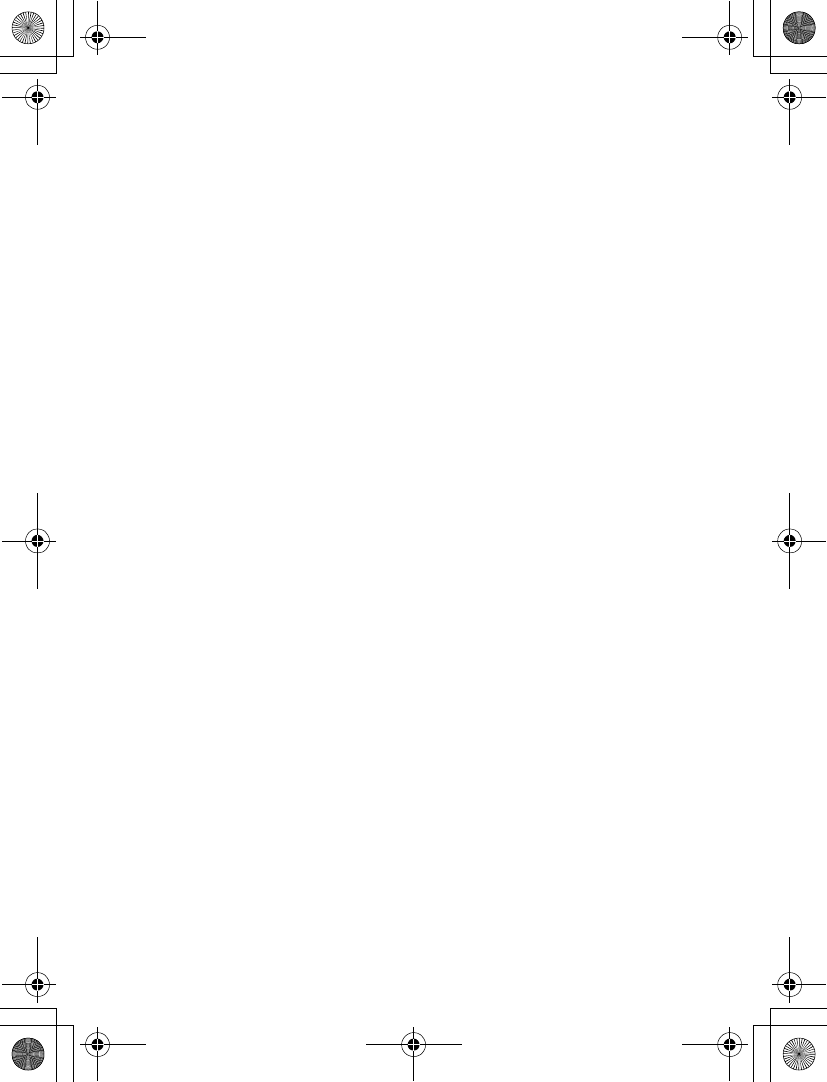
x
The Set-up Menu ............................................................................. 115
Using the Set-up Menu................................................................................................... 115
R Menus...................................................................................................................... 116
V Welcome Screen ...................................................................................................... 117
W Date .......................................................................................................................... 118
Z Monitor Settings....................................................................................................... 120
b Date Imprint ............................................................................................................. 122
Shot Confirmation .......................................................................................................... 124
u AF Assist ................................................................................................................. 125
h Sound Settings ........................................................................................................... 126
i Auto Off .................................................................................................................... 127
M/O Format Memory/Card ........................................................................................... 128
j Language.................................................................................................................... 129
k Interface (USB/Video mode) ..................................................................................... 129
E Auto Transfer .......................................................................................................... 130
n Reset All ..................................................................................................................... 131
B Firmware Version .................................................................................................... 132
Wireless Transfer Mode .................................................................. 133
Functions of the Wireless Transfer Mode......................................................................... 133
Using the Wireless Transfer Mode ................................................................................... 134
Managing Profile Information ......................................................................................... 140
Transferring Images to a Computer................................................................................. 141
Technical Notes................................................................................ 150
Optional Accessories ....................................................................................................... 150
Caring for Your Camera.................................................................................................. 152
Error Messages ............................................................................................................... 155
Troubleshooting.............................................................................................................. 161
Specifications.................................................................................................................. 165
Index .............................................................................................................................. 168
en_q3175.book Page x Thursday, June 16, 2005 10:54 AM
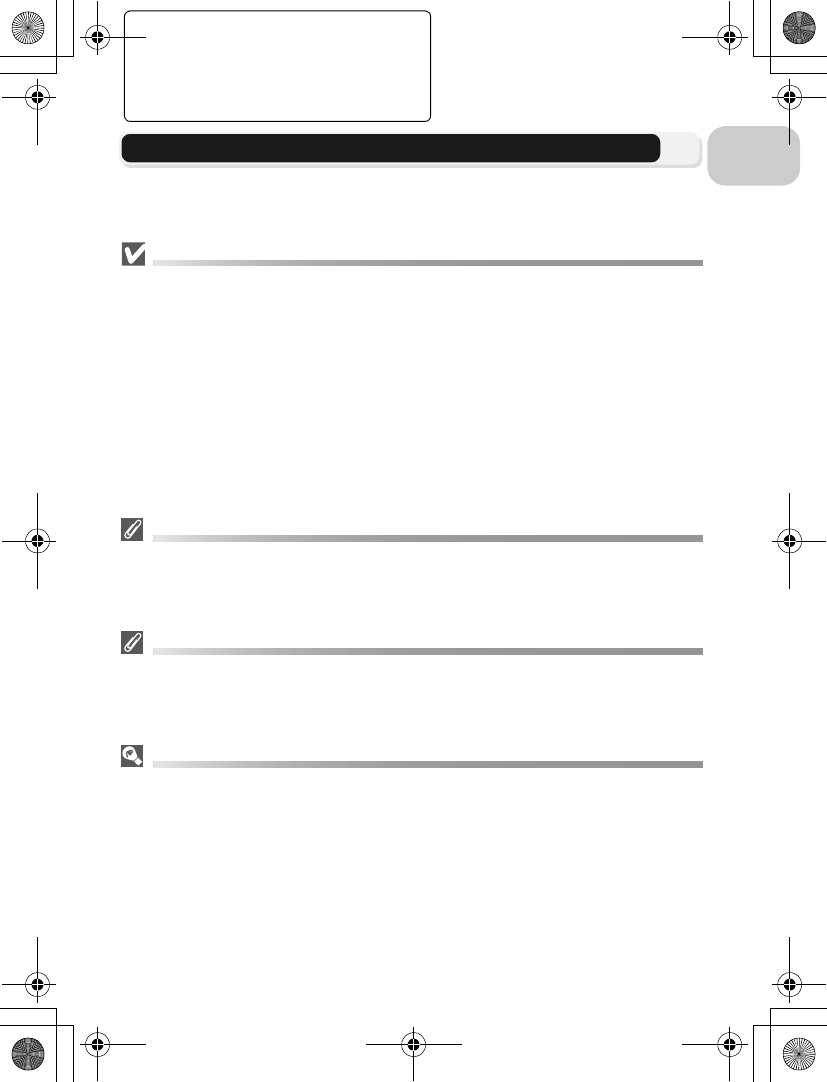
1
Before You Begin
Before You Begin
Introduction
Use Only Nikon Brand Electronic Accessories
Nikon COOLPIX cameras are designed to the highest standards and include complex elec-
tronic circuitry. Only Nikon brand electronic accessories (including battery chargers, batteries,
AC adapters, and Speedlights) certified by Nikon specifically for use with this Nikon digital
camera are engineered and proven to operate within the operational and safety require-
ments of this electronic circuitry.
THE USE OF NON-NIKON ELECTRONIC ACCESSORIES COULD DAMAGE THE CAMERA AND
MAY VOID YOUR NIKON WARRANTY. The use of third-party rechargeable Li-ion batteries
not approved by Nikon could interfere with normal operation of the camera or result in the
batteries overheating, igniting, rupturing, or leaking.
For more information about Nikon brand accessories, contact a local authorized Nikon deal-
er.
Before Taking Important Pictures
Before taking pictures on important occasions (such as at weddings or before taking the
camera with you on a trip), take a test shot to ensure that the camera is functioning normally.
Nikon will not be held liable for damages or lost profits that may result from product mal-
function.
Internal Memory and SD Memory Card
This camera uses both internal memory and an SD memory card for storing pictures. If you
insert a memory card into the camera, pictures will automatically be stored on the card in-
stead of in the internal memory. To store, view or delete pictures in the internal memory or
to format the internal memory, remove the memory card first.
Life-Long Learning
As part of Nikon’s “Life-Long Learning” commitment to ongoing product support and edu-
cation, continually-updated information is available on-line at the following sites:
•For users in the U.S.A.: http://www.nikonusa.com/
•For users in Europe: http://www.europe-nikon.com/support
•For users in Asia, Oceania, the Middle East, and Africa: http://www.nikon-asia.com/
Visit these sites to keep up-to-date with the latest product information, tips, answers to fre-
quently-asked questions (FAQs), and general advice on digital imaging and photography. Ad-
ditional information may be available from the Nikon representative in your area. See the URL
below for contact information:
http://nikonimaging.com/
en_q3175.book Page 1 Thursday, June 16, 2005 10:54 AM
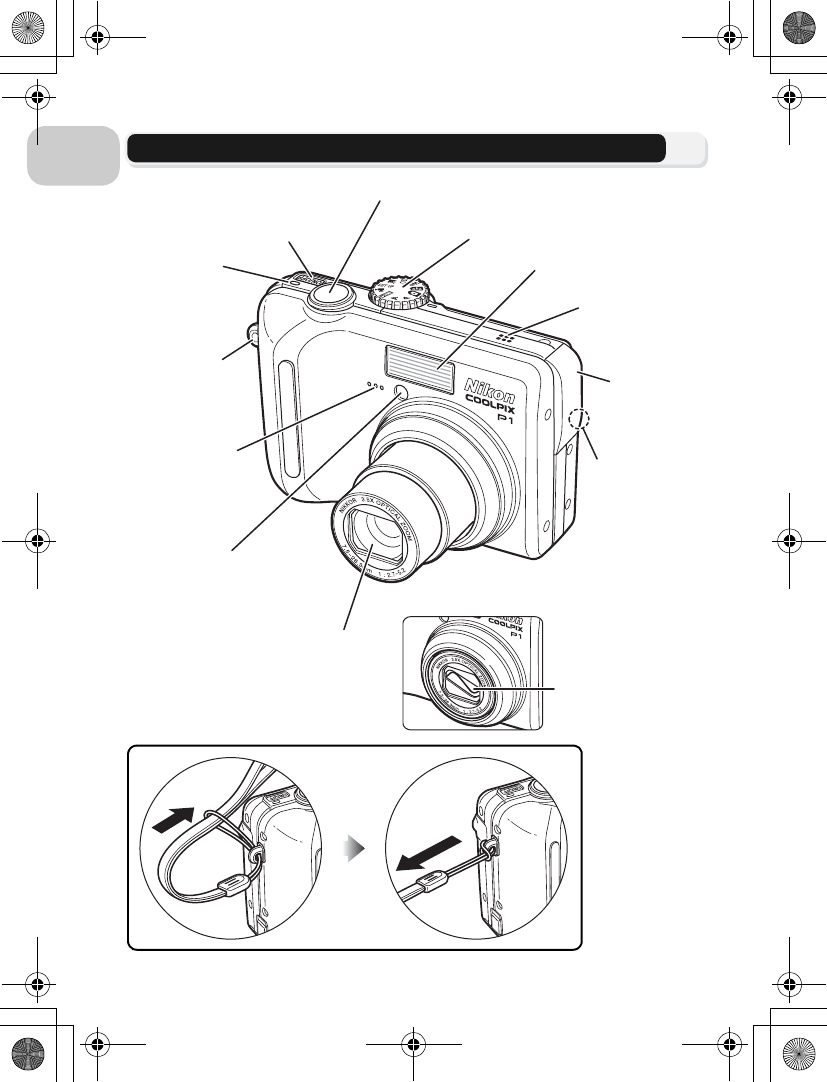
2
Before You Begin
Parts of the Camera
Mode Dial (c6)
Power switch
(c14)
Self-timer lamp (c30)/
AF-Assist illuminator
(LED; c23, 152, 165)
Shot confirmation
(LED; c124)
Built-in flash (c27)
Lens
(c153, 165)
Eyelet for
camera strap
Shutter-release button (c22)
Power-on lamp
(c14)
Attaching the Camera strap
Microphone
(c58)
Lens not extended
Lens cover
Wireless transfer
LED
(blinks when
searching for a
host; lights
when connected
to a host; off
when not con-
nected)(c133)
Antenna
(c20, XXX)
Speaker
en_q3175.book Page 2 Thursday, June 16, 2005 10:54 AM
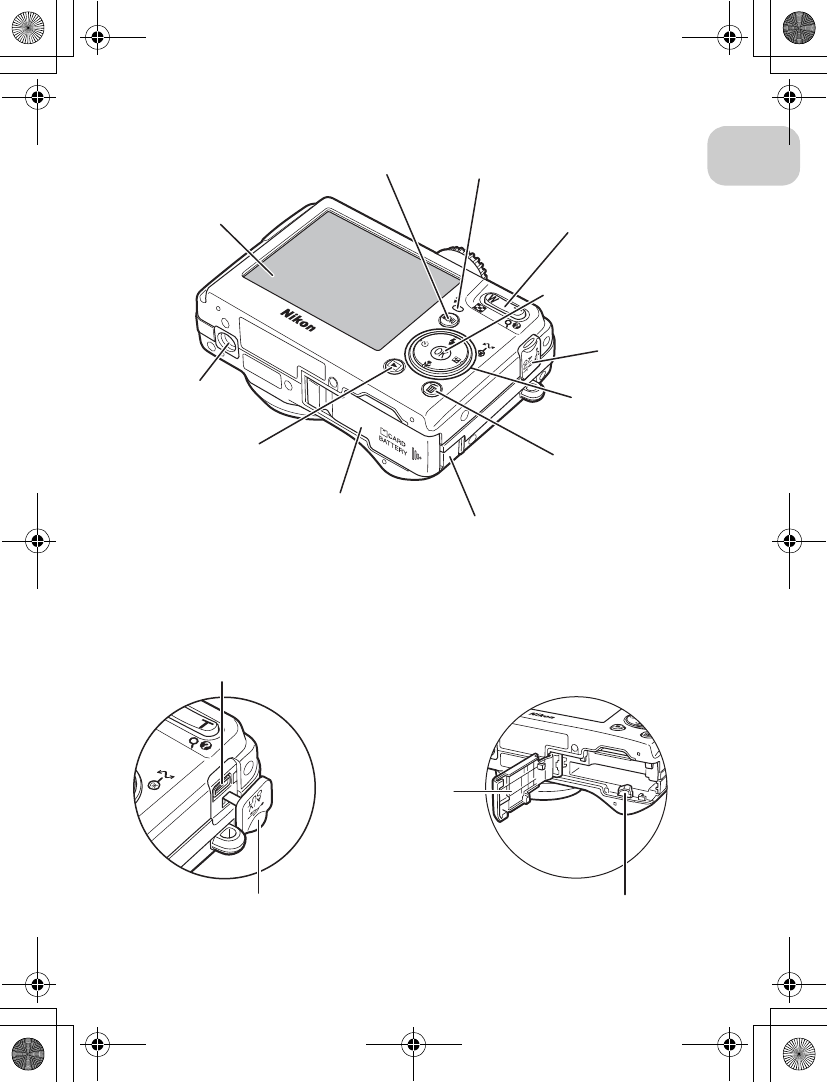
3
Before You Begin
Zoom (j/lk)
buttons (c7, 20)
Multi selector
(C/H/F/I)
(c7, 27, 30, 31, 33)
d (center)/
E(transfer) (c7, 61)
m button (c86, 104) Red (C) lamp (c22)
Interface connector cover
USB (c62)/
Audio/Video (A/V) out
(c60) connector
Delete A button
(c24, 55)
Monitor (c4)
Tripod socket
(c30, 44)
Interface
connector
cover
Play i button
(c24, 55)
Battery-chamber/Memory card
slot cover (c10)
Battery latch (c10)
Battery-chamber/
Memory card slot
cover (c10)
Power connector cover
(for AC adapter kit)
en_q3175.book Page 3 Thursday, June 16, 2005 10:54 AM
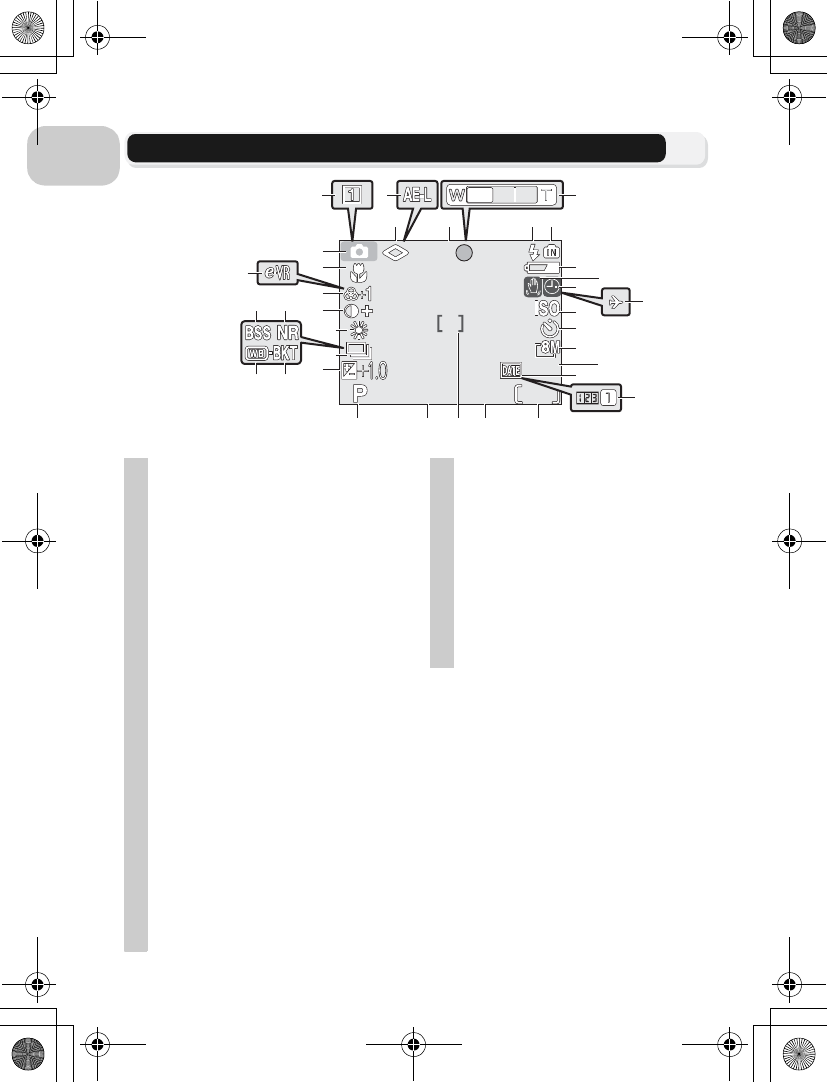
4
Before You Begin
The Monitor
999
999
1/60
1/60
F2.7
F2.7
NORM
NORM
10
10
AF
AF
5 7
20
8
9
34
11 10
13
14
16
32
31
30
25
24
4
2928
27 26
3
6
2
17
15
12
18
19
1
23 22 21
33
Shooting
1Shooting mode . . . . . 18, 34, 81
2Custom No1) . . . . . . . . . . . . 103
3Image sharpening . . . . . . . . . 95
4AE-L indicator2) . . . . . . . . . . . 43
5Focus indicator3) . . . . . . . . . 22
6Zoom indicator4) . . . . . . . . . 20
7Flash mode . . . . . . . . . . . . . . 27
8Internal memory/Memory card
indicator . . . . . . . . . . . . . . . . 18
9Battery level indicator5) . . . . . 14
10
Camera shake icon
6)
. . . 28, 155
11 “Date not set” icon7) . . . . . . 16
12 Time zone indicator8) . . . . . 118
13
Sensitivity (ISO equivalency)
. . . 50
14 Self-timer indicator . . . . . . . . 30
15 Image size. . . . . . . . . . . . 18, 47
16 Image quality . . . . . . . . . 18, 47
17 Date imprint indicator . . . . . 122
18 Date counter/
Stored date number . . . . . . 123
19 Number of exposures remaining/
Length of movie . . . . . . . 18, 80
20 Aperture . . . . . . . . . . . . . . . .46
21 Focus area9) . . . . . . . . . . 22, 97
22 Shutter speed . . . . . . . . . . . . 45
23 Exposure mode . . . . . . . . . . . 45
24 Exposure compensation . . . . 33
25 Continuous shooting mode . . . 89
26 Bracketing10) . . . . . . . . . . . . 93
27
White balance bracketing
11)
. . . . 93
28 Best Shot Selector (BSS) . . . . 92
29 Noise reduction . . . . . . . . . 101
30 White balance . . . . . . . . . . . 52
31 Image adjustment . . . . . . . . 94
32 Saturation control . . . . . . . . 96
33 Electronic VR . . . . . . . . . . . . 84
34 Focus mode . . . . . . . . . . . . . 31
1) Appears when mode dial is rotated to P or A.
2) Appears when taking a picture in Panorama assist
mode.
3) Appears when the shutter-release button is pressed
halfway.
4) Appears when the zoom buttons are pressed.
5) Appears when the battery is running low.
6) Blinks at slow shutter speeds to warn that pictures
may be blurred.
7) Blinks when the camera clock has not been set.
8) Appears when the new city time zone has been set.
9) Displays the focus area when the shutter-release
button is pressed halfway if AF area mode has
been set to l Auto.
10)Appears when Auto bracketing has been set to
CAuto bracketing.
11)Appears when WB (white balance) bracketing has
been set.
Icons displayed vary with camera settings.
en_q3175.book Page 4 Thursday, June 16, 2005 10:54 AM
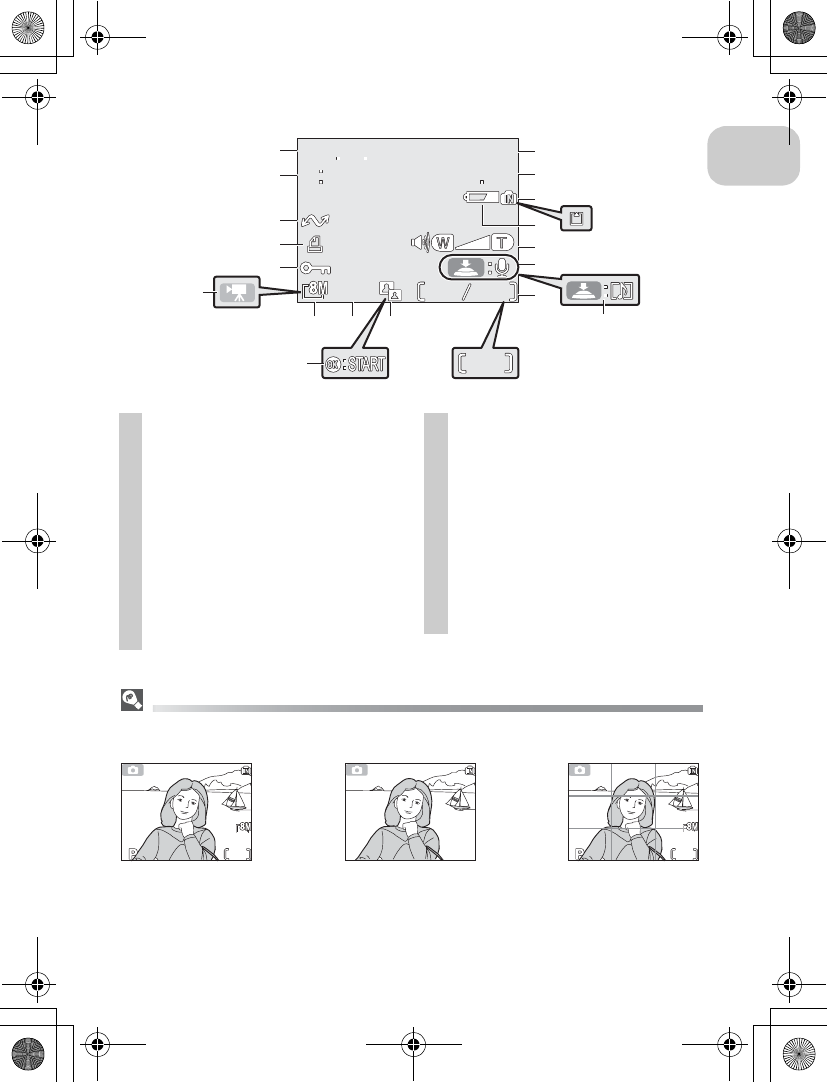
5
Before You Begin
Display in the Monitor
Use Photo info in Monitor settings of the Set-up menu to display or hide information for
shooting or playback (c120).
If the battery level indicator appears, the monitor will turn off temporarily while the flash is
charging (c14, 23).
7
7
5
5
100NIKON
100NIKON
JPG
JPG
2005
2005
12
12
12
12
00
00
01
01
0008
0008
NORM
NORM
12s
12s
18
17
16
14
1
2
3
4
5
8
7
12 911
10
15
6
13
1Current folder . . . . . . . . . . . . 25
2File number and type . . . . . . 25
3Internal memory/Memory card
indicator . . . . . . . . . . . . . . . . 18
4Battery level indicator1) . . . . . 14
5Volume indicator. . . . . . . . . . 85
6
Voice memo recording guide . . . 58
7
Voice memo playback guide . . . 58
8Current frame number/Total
number of frames/Length of
movie . . . . . . . . . . . . . . . 24, 85
9D-Lighting icon . . . . . . . . . . 78
10 Movie playback icon . . . . . . 85
11 Image quality. . . . . . . . . . . . 18
12 Image size . . . . . . . . . . . . . . 18
13 Movie indicator . . . . . . . . . . 80
14 Protect icon . . . . . . . . . . . . 111
15 Print-order icon . . . . . . . . . . 66
16 Transfer icon . . . . . . . . . . . 112
17 Time of recording . . . . . . . . 16
18 Date of recording. . . . . . . . . 16
1) Appears when the battery is running low.
Icons displayed vary with camera settings.
Playback
NORM
NORM
15
15
1/60
1/60
F2.7
F2.7
Monitor shows cur-
rent settings and
view through lens
Monitor shows view
through lens only
NORM
NORM
15
15
1/60
1/60
F2.7
F2.7
Framing grid
en_q3175.book Page 5 Thursday, June 16, 2005 10:54 AM
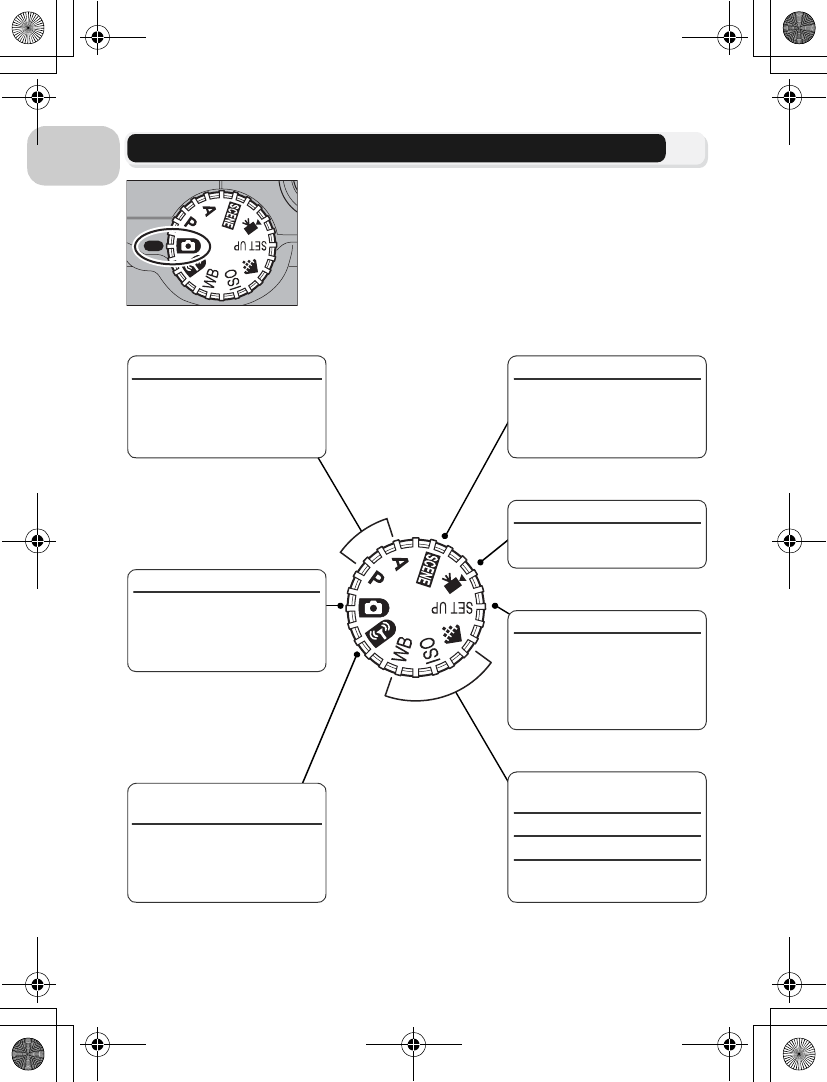
6
Before You Begin
The Mode Dial
b Scene (c34)
Choose from 16 “scenes”
suited to different subjects
or shooting conditions and
let the camera do the rest.
S Movie (c80)
Choose from seven movie
modes.
a Setup (c115)
Display the Set-up menu,
where you can perform
such tasks as setting the
camera clock and adjusting
monitor brightness.
P A (c45)
Choose these modes for
varying degrees of control
over shutter speed and ap-
erture.
X Auto (c18)
A simple “point-and-
shoot” mode recommend-
ed for first time users of
digital cameras.
Y Wireless Transfer mode
(c133)
Connect the camera to a
wireless LAN and transfer
pictures to a computer or
print images from a printer.
Z
Image quality/Image size
(c47)
W ISO sensitivity (c50)
d White balance (c52)
Display menus of each op-
tion.
To select a mode, align the mode icon with the “q”
mark next to the mode dial.
en_q3175.book Page 6 Thursday, June 16, 2005 10:54 AM
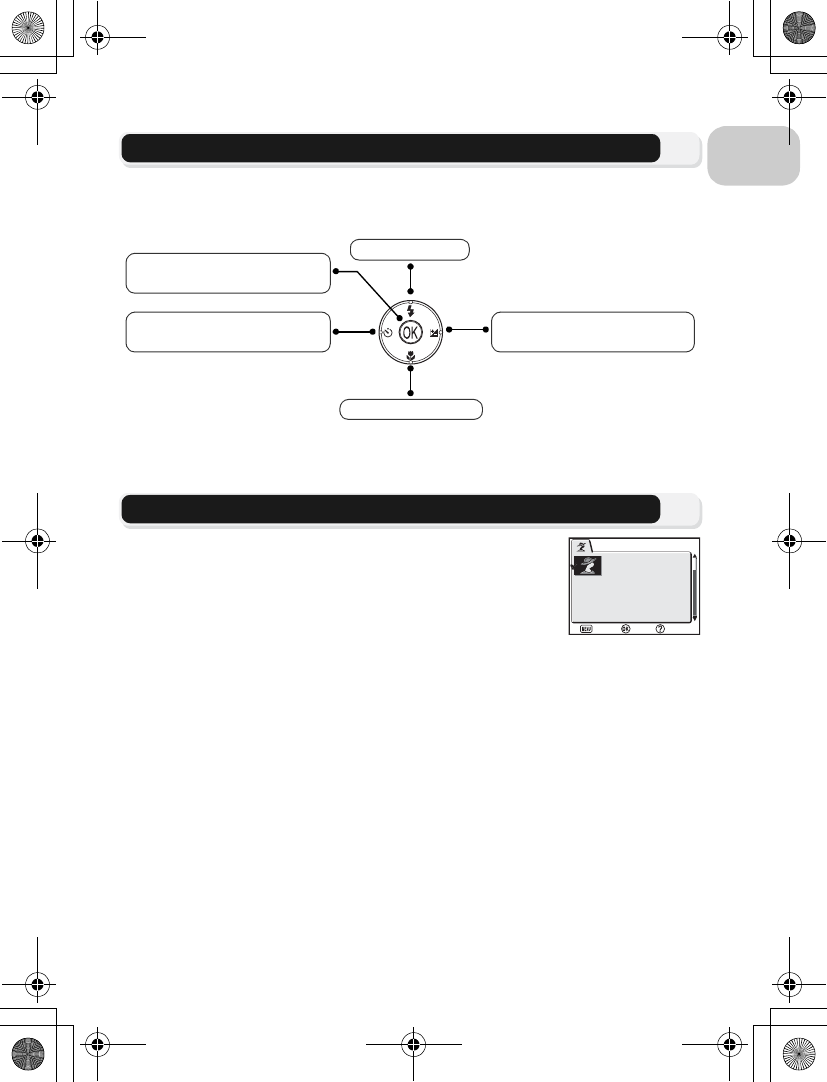
7
Before You Begin
Navigating the Menus
Use the multi selector to perform operations such as selecting or canceling menu
items that appear in the monitor.
Press the d button after selecting an item to perform that operation.
Use the multi selector to perform operations such as moving the area in which a
picture is displayed or selecting a picture.
Displaying the Help
The COOLPIX P1/P2 displays explanations about modes and
menus of the camera in the monitor.
Pressing l (Help) button when displaying a menu displays
the help for the selected scene or item.
Pressing d while displaying the help performs the function.
Move cursor up.
Move cursor down.
Return to previous menu or
move cursor left.
Display sub-menu or move
cursor right.
Press d to make selection
or display sub-menu.
PORTRAIT
PORTRAIT
Use for portrait
pictures, create soft
skin tone effects.
Confirm
Exit Back
en_q3175.book Page 7 Thursday, June 16, 2005 10:54 AM
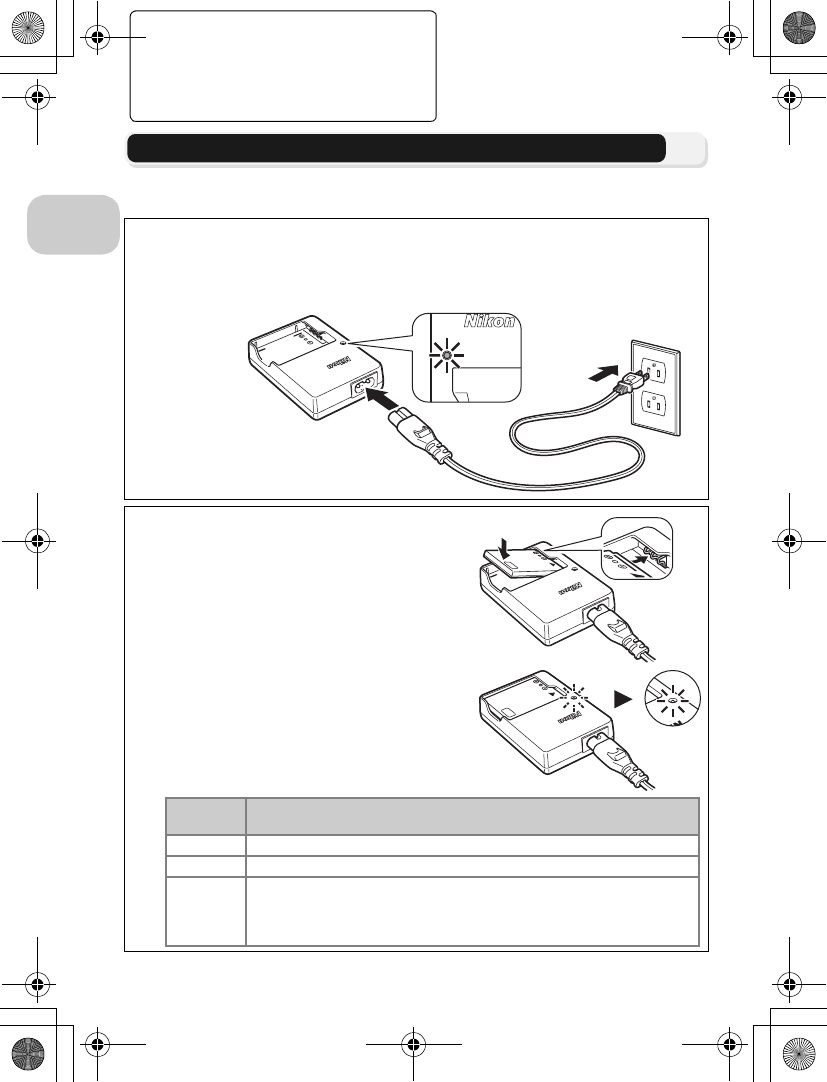
8
First Steps
First Steps
Charging the Battery
The camera uses a rechargeable Nikon EN-EL8 lithium-ion battery (supplied).
Charge the battery before first use or when the battery is running low.
1Connect the power cable
Connect the power cable to the supplied MH-62 battery charger (1) and insert
the wall plug into a power outlet (2). The CHARGE lamp will light to show that
the charger is on (3).
2Charge the battery
Remove the terminal cover from EN-EL8 and
insert the battery into the MH-62.
CHARGE lamp starts blinking when battery
is inserted. Charging is complete when lamp
stops blinking.
About two hours are required to charge a
fully depleted battery.
MH-62
LITHIUM ION BA
TTERY CHARGER
CHARGE
CHARGE
LITHIUM ION BATTE
1
2
3
MH-62
LITHIUM ION BATTERY CHARGER
CHARGE
MH-62
LITHIUM ION BATTERY CHARGER
CHARGE
LITHIUM ION
CHARGE
CHARGE
lamp Description
Blinks Battery charging.
On Battery fully charged.
Flickers
Battery error. If ambient temperature is not 0 to 40 °C (32 to 104 °F),
wait until temperature is in this range before charging. Otherwise
unplug charger and remove battery immediately and take both
devices to retailer or Nikon-authorized service representative.
en_q3175.book Page 8 Thursday, June 16, 2005 10:54 AM
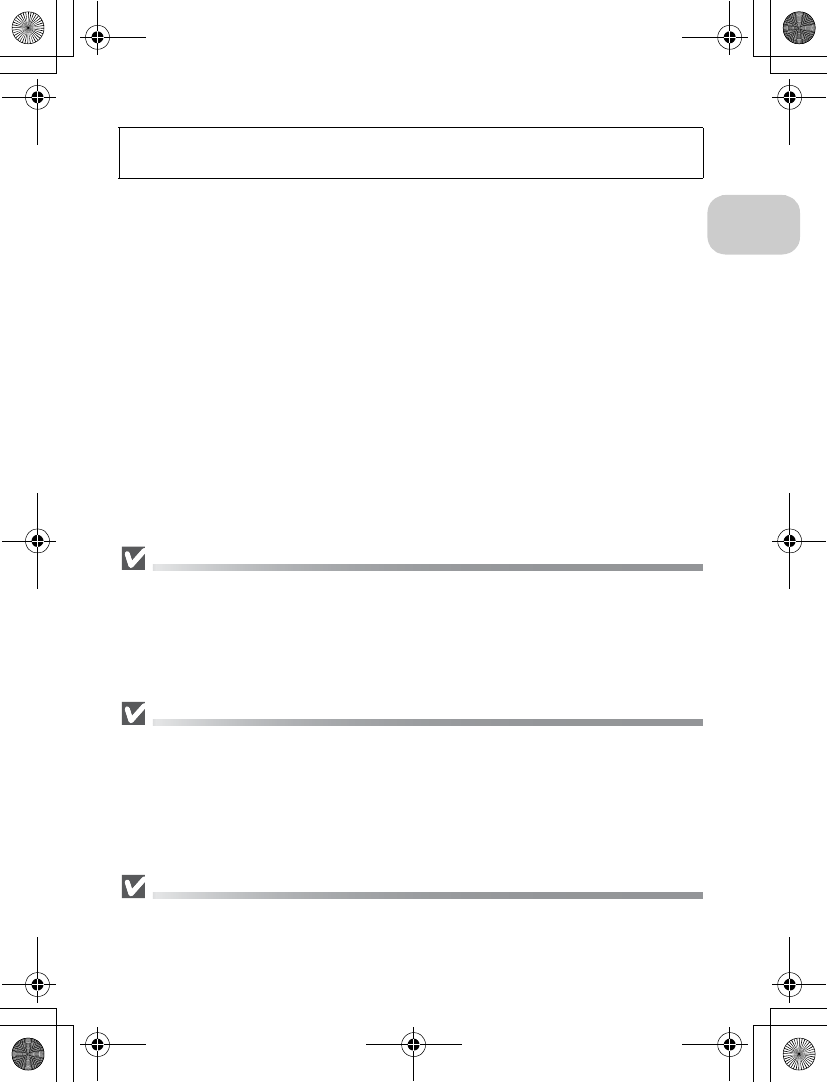
9
First Steps
The MH-62 Battery Charger
Before using the MH-62, read and follow the warnings and notices on pages ii to vi
of this manual.
The MH-62 is for use with EN-EL8 batteries. Do not use with incompatible batteries. The sup-
plied power cable is intended solely for use with the MH-62 and is for domestic use only. It
may be necessary to purchase another cable for use abroad; consult with a local Nikon-au-
thorized retailer or service representative.
EN-EL8 Batteries
Before using the EN-EL8, read and follow the warnings and notices on pages ii–vi
and 154 of this manual.
Do not use the battery at ambient temperatures below 0 °C (32 °F) or above 40 °C (104 °F).
During charging, the temperature should be in the vicinity of 5 to 35 °C (41 to 95 °F). Note
that the battery may become hot during use; wait for the battery to cool before charging.
Failure to observe these precautions could damage the battery, impair its performance, or
prevent it from charging normally.
When the Battery Is Not in Use
When the battery is not in use, remove it from the camera or battery charger and replace the
terminal cover. The camera and battery charger draw minute amounts of current even when
off; if left in place, the battery could be drained to the point that it no longer functions.
3Unplug the charger
Remove the battery and unplug the charger.
en_q3175.book Page 9 Thursday, June 16, 2005 10:54 AM
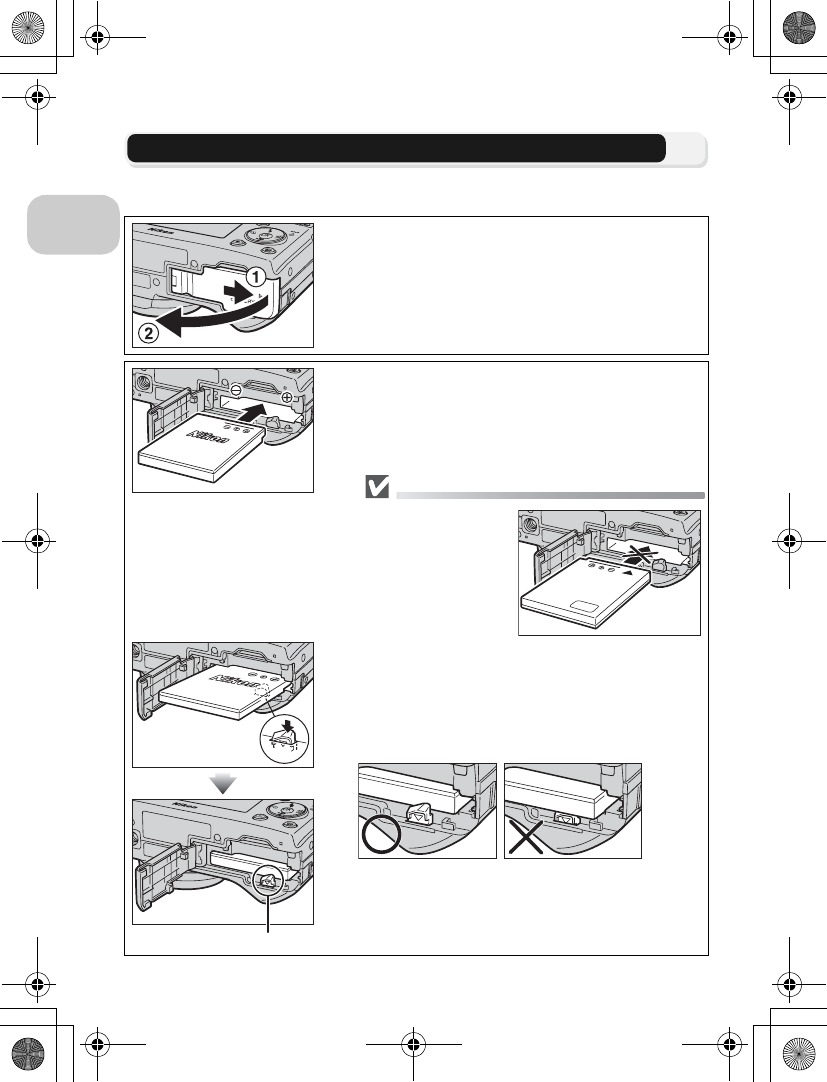
10
First Steps
Inserting Batteries
Insert an EN-EL8 battery that has been fully-charged using the supplied MH-62
battery charger into your camera.
1Open the battery-chamber/memory
card slot cover
Slide the cover in the direction shown in (1) until
it stops and open the cover (2).
2Insert the battery
Insert the battery as shown in the label at the
entrance to the battery chamber, making sure the
positive “+” and negative “–” terminals are in the
correct orientation.
Inserting Batteries
Inserting the battery
upside down or back-
wards could damage
the camera. Check to
be sure the battery is
in the correct orienta-
tion.
The orange battery
latch is pushed aside as the battery is inserted. The
latch will close when the battery is fully inserted.
Make sure that the battery latch is secured over the
battery and that the battery is set.
Battery Latch
en_q3175.book Page 10 Thursday, June 16, 2005 10:54 AM
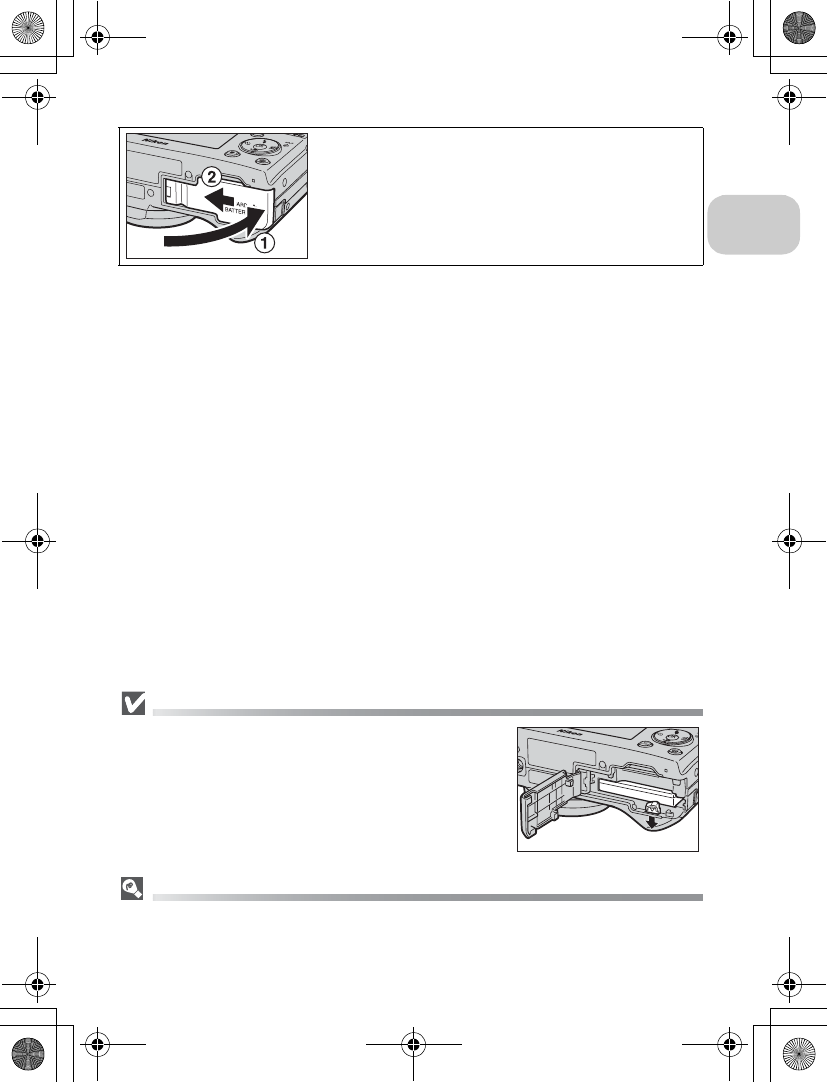
11
First Steps
Replacing Batteries
Turn the camera off and make sure that the power-on lamp
has gone out before opening the battery-chamber/memory
card slot cover.
Slide the battery latch in the direction indicated to eject the
battery, which can then be removed using your fingers.
•Note that the battery may become hot during use. Ob-
serve due caution when removing the battery.
Alternative Power Sources
To power the camera continuously for extended periods, use an optional EH-62C AC adapt-
er. Do not, under any circumstances, use another make or model of AC adapter kit.
Failure to observe this precaution could result in overheating or in damage to the camera.
3Close the battery-chamber/memory
card slot cover
Close the cover (1) and slide it in until it latches
(2).
Ensure the cover is closed firmly.
en_q3175.book Page 11 Thursday, June 16, 2005 10:54 AM
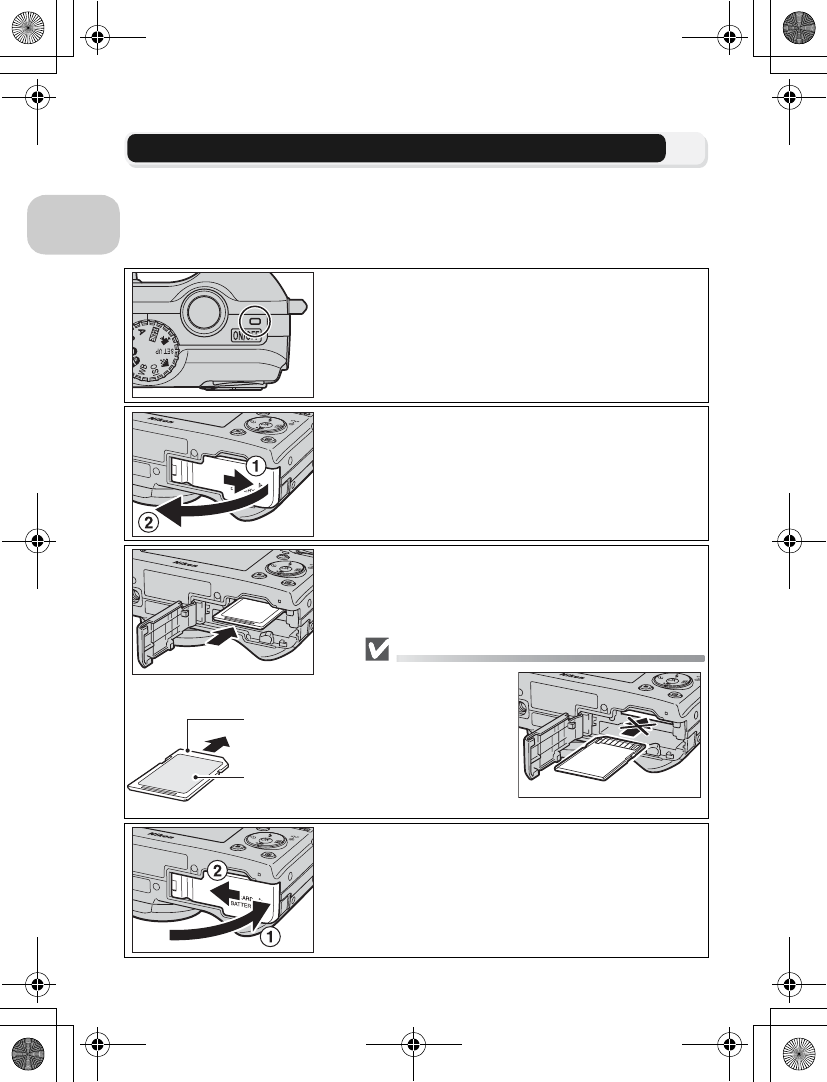
12
First Steps
Inserting Memory Cards
Pictures can be stored in the camera’s internal memory (about 32 MB for P1/16 MB
for P2) or on a Secure Digital (SD) memory card. If no memory card has been inserted
in the camera, pictures will be stored in the camera’s internal memory, and if the cam-
era contains a memory card, then pictures will automatically be stored on the card.
To store pictures in the internal memory, remove the memory card.
1Confirm that the camera is off
The power-on lamp should be off.
2Open the battery-chamber/memory
card slot cover
Slide the cover in the direction shown in (1) until
it stops and open the cover (2).
3Insert the memory card
Insert the memory card in the direction of the
arrow shown on the label at the entrance to the
memory card slot until it stops.
Inserting Memory Cards
Insert the memory card
terminals first. Inserting
the card upside down
or backwards could
damage the camera or
the card. Check to be
sure the card is in the
correct orientation.
4Close the battery-chamber/memory
card slot cover
Close the cover (1) and slide it until it latches (2).
Ensure the cover is closed firmly.
256
MB
256
MB
Direction
of insertion
Terminals
Front
en_q3175.book Page 12 Thursday, June 16, 2005 10:54 AM
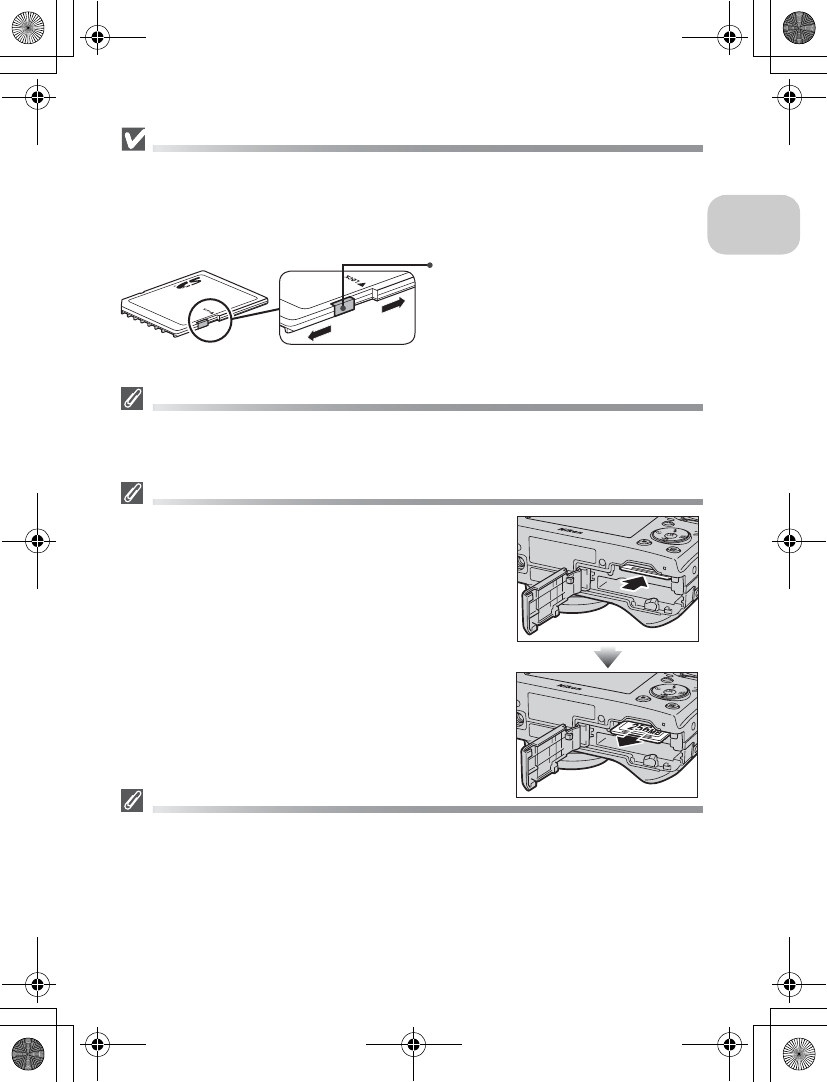
13
First Steps
The Write Protect Switch
Memory cards are equipped with a write protect switch to prevent accidental loss of data.
When this switch is in the “lock” position, pictures cannot be recorded, deleted, or edited,
and the card cannot be formatted. Do not lock the card when taking, editing, or deleting
pictures, when transferring images to a computer, when using Wireless transfer mode, or
when formatting the memory card.
Formatting Memory Cards
When using the memory cards formatted by the device other than COOLPIX P1/P2, format
them using the COOLPIX P1/P2 before first use. For information on formatting memory
cards, see “M/O Format Memory/Card” (c128) in the Set-up menu.
Removing Memory Cards
Memory cards can be removed without loss of data when
the camera is off. To remove memory cards, turn the camera
off and confirm that the power-on lamp is off. Do not open
the battery-chamber/memory card slot cover while the
power-on lamp is lit. Open the battery-chamber/memory
card slot cover and press the memory card to partially eject
the card. The card can then be removed by hand.
•Memory cards may become hot during use; observe due
caution when removing memory cards.
Memory Cards
•Use only Secure Digital (SD) memory cards.
•Do not disassemble or modify.
•Do not drop, bend, or expose to water or strong physical shocks.
•Do not touch the metal terminals with your fingers or metal objects.
•Do not affix labels or stickers to the memory card.
•Do not leave in direct sunlight in a closed vehicle or in other areas exposed to high tem-
peratures.
•Do not expose to high levels of humidity or to corrosive gas.
Write protect switch
When the memory card is locked,
pictures can be played back but can-
not be recorded, deleted, edited, or
transferred using the d (E) but-
ton on the camera, and the card
cannot be formatted.
en_q3175.book Page 13 Thursday, June 16, 2005 10:54 AM
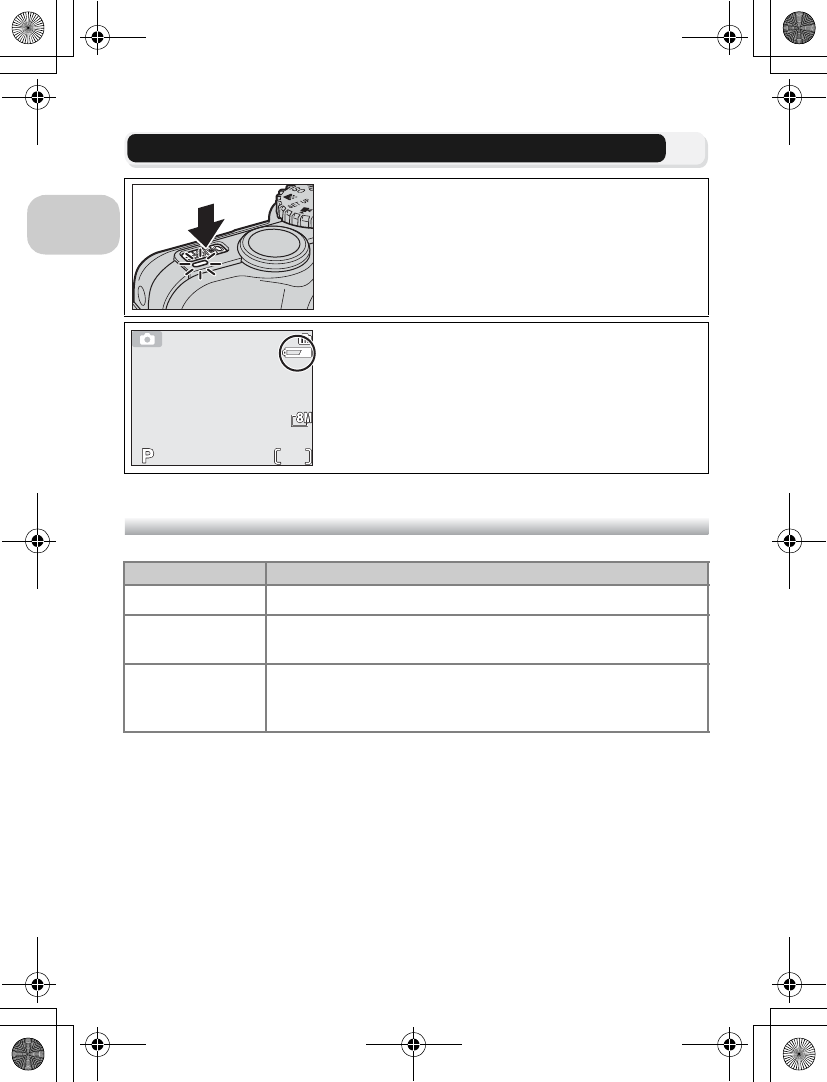
14
First Steps
Checking the Battery Level
Battery Level
The red (C) lamp and power-on lamp will blink when the “WARNING!! BATTERY
EXHAUSTED” warning is displayed (c155).
1Turn the camera on
•Press the power switch.
•The power-on lamp lights when the camera is
on.
2Check the battery level in the moni-
tor
When the camera is turned on for the first time, a
language-selection dialog will be displayed.
Choose the desired language and press d. See
“Basic Setup” (c16).
Display Meaning
NO ICON Battery fully charged.
w
(lights)
Low battery. If flash fires, monitor turns off while flash
recharges.
WARNING!!
BATTERY
EXHAUSTED
Battery exhausted. Replace with fully charged battery.
NORM
NORM
15
15
1/60
1/60
F2.7
F2.7
en_q3175.book Page 14 Thursday, June 16, 2005 10:54 AM
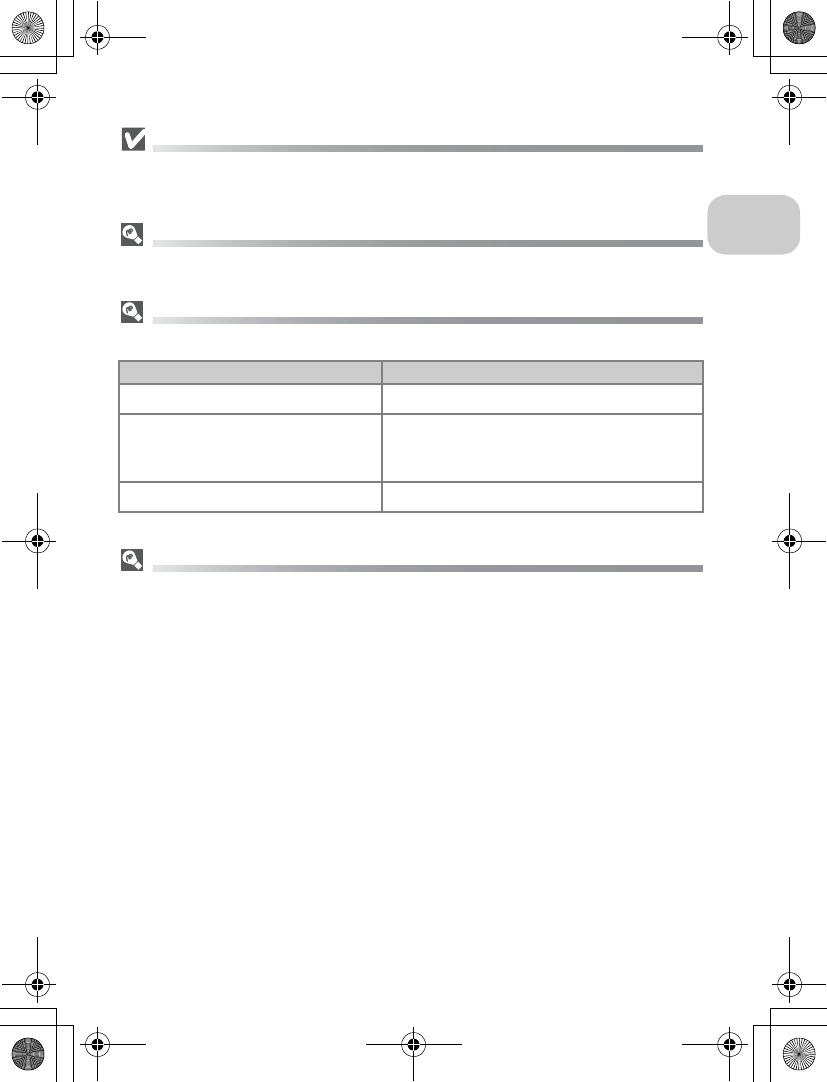
15
First Steps
Turning the Camera Off
To turn the camera off when the power-on lamp is lit, press the power switch.
•Do not remove the battery or disconnect the EH-62C AC adapter kit (optional) until the
power-on lamp has gone out.
The i Button
The camera can also be turned on by pressing the i button for about one second (except
in Wireless transfer mode). The monitor will show full-screen playback (c24).
The Power-On Lamp
The power-on lamp indicates the following:
Auto Power Off (Standby Mode)
If no operations are performed for one minute (default setting), the monitor will turn off au-
tomatically and the camera will enter Standby mode to reduce the drain on the battery. While
the camera is in Standby mode, the power-on lamp will blink. If no operations are performed
for three minutes after the camera enters Standby mode, the power will turn off automati-
cally and the power-on lamp will go out. The camera will be reactivated from Standby mode
when you:
•Press the power switch
•Press the shutter-release button halfway
•Press the i button (when not in Wireless transfer mode, camera is in Playback mode)
•Press the m button to display the menu for the current mode
The length of time before the camera enters Standby mode can be changed using the Auto
off option in the Set-up menu (c127).
However, the length of time is fixed in the following cases:
•When a menu is displayed: 3 minutes
•When pictures are being played back in a slide show: 30 minutes
•When in Wireless transfer mode: 3 minutes (Auto off is unavailable.)
•When using the optional EH-62C AC adapter kit: 30 minutes
When connecting the camera to a computer or printer with a USB cable, Auto power off
function does not work.
When the power-on lamp is The camera is
On On
Blinking
In Standby mode; Auto power off, or waiting
for next shot in Interval timer shooting or
Time-lapse movie
Off Off
en_q3175.book Page 15 Thursday, June 16, 2005 10:54 AM
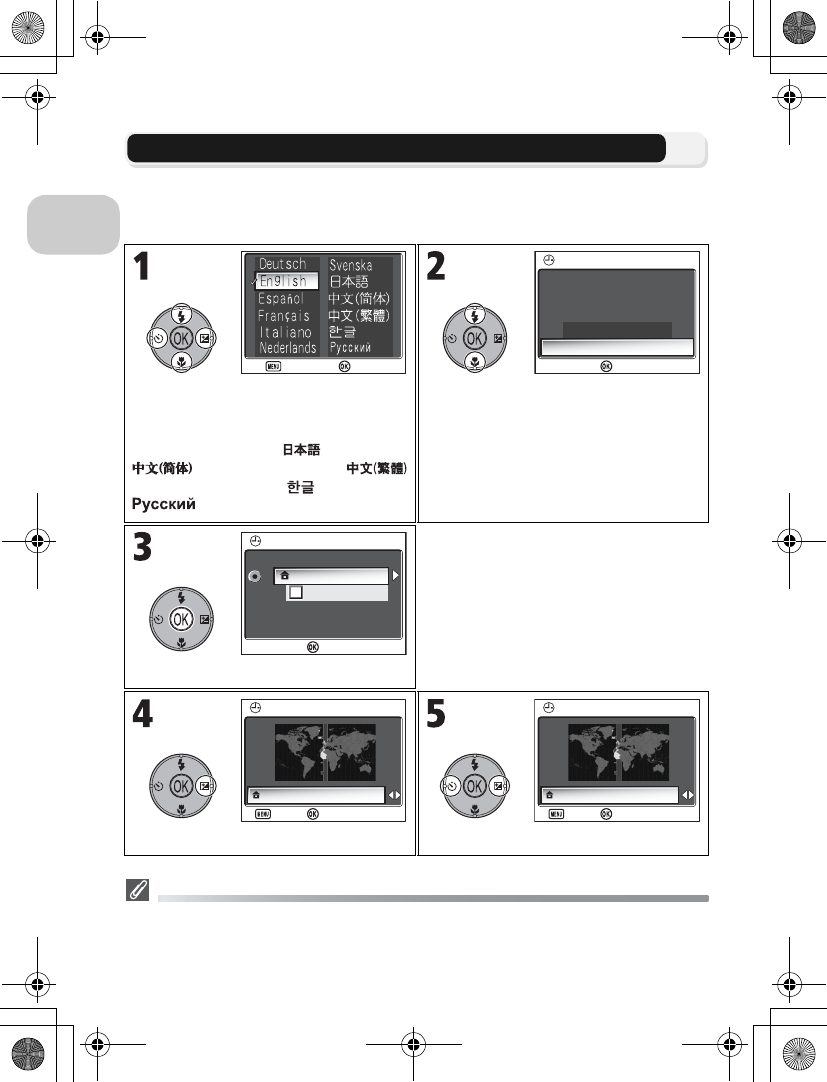
16
First Steps
Basic Setup
The first time the camera is turned on, a language-selection dialog will be dis-
played in the monitor. Follow the steps below to choose a language and set the
time and date.
Date not Set
If you exit without setting time and date, the s (“date not set”) icon will flash in the monitor
(c4) when the camera is in Shooting mode and all pictures will have time stamp of
“0000.00.00 00:00” (still images) or “2005.01.01 00:00” (movies).
Highlight Deutsch (German), English,
Español (Spanish), Français (French),
Italiano (Italian), Nederlands (Dutch),
Svenska (Swedish), (Japanese),
(Simplified Chinese),
(Traditional Chinese), (Korean), or
(Russian) and press d.
Confirmation dialog displayed.
Highlight Yes.
*To turn daylight saving time on or off,
press multi selector down to highlight
DaylightSaving and press d. When
DaylightSaving is checked, time will
automatically be advanced one hour
(c119). To return to Step 3, press
multi selector up to highlight current
time zone.
TIME ZONE menu displayed.*
Display map of world time zones. Select home time zone.
Confirm
Confirm
Cancel
Cancel
No
Yes
Set time and date?
Set time and date?
DATE
Confirm
DaylightSaving
TIME ZONE
London, Casablanca
OK
Confirm
Back
Back
HOME TIME ZONE
HOME TIME ZONE
London, Casablanca
Confirm
Back
Back
HOME TIME ZONE
HOME TIME ZONE
London, Casablanca
Confirm
en_q3175.book Page 16 Thursday, June 16, 2005 10:54 AM
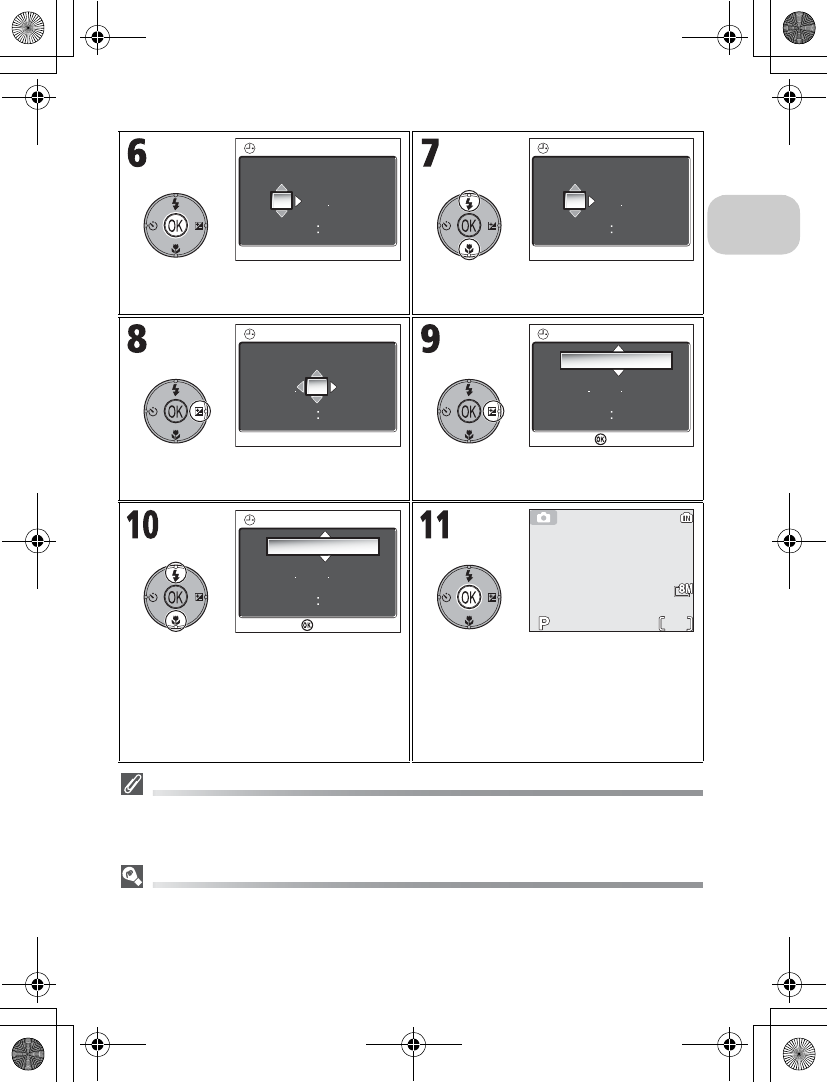
17
First Steps
The Clock Battery
When the main battery is installed or the camera is powered by an EH-62C AC adapter (op-
tional), the clock battery will charge in about ten hours. When fully charged, the clock battery
can provide a few days of back-up power.
Setting the Clock from PictureProject (Windows XP/Mac OS X Only)
If the camera is connected with the USB option set to PTP (c61) in the Interface menu of
the Set-up menu, PictureProject and Wireless Camera Setup Utility (both provided) can be
used to set the camera clock to the same time and date as the computer. See the Picture-
Project Reference Manual (on CD) for details.
Display DATE menu. Edit Day (order of Day, Month, and Year
may differ in some areas).
Select Month. Repeat steps 7 and 8 to
edit Month, Year, hour, and minute.
Highlight D M Y.
Choose order in which Day, Month, and
Year will be displayed.
Exit to mode currently selected with the
mode dial.
Note that time and date of recording will
not be imprinted on pictures unless Date
or Date and time is selected for Date
imprint (c122).
0 0 0 0
DATE
DATE
MDY
0 9
0 1
2005
0 0 0 0
DATE
DATE
MDY
0 9
0 1
2005
0 0 0 0
DATE
DATE
MDY
0 9
0 1
2005
1 3 0 0
DATE
DATE
Confirm
MDY
1 2
0 1
2005
1 3 0 0
DMY
0 1
1 2
2005
DATE
DATE
Confirm
NORM
NORM
15
15
1/60
1/60
F2.7
F2.7
en_q3175.book Page 17 Thursday, June 16, 2005 10:54 AM
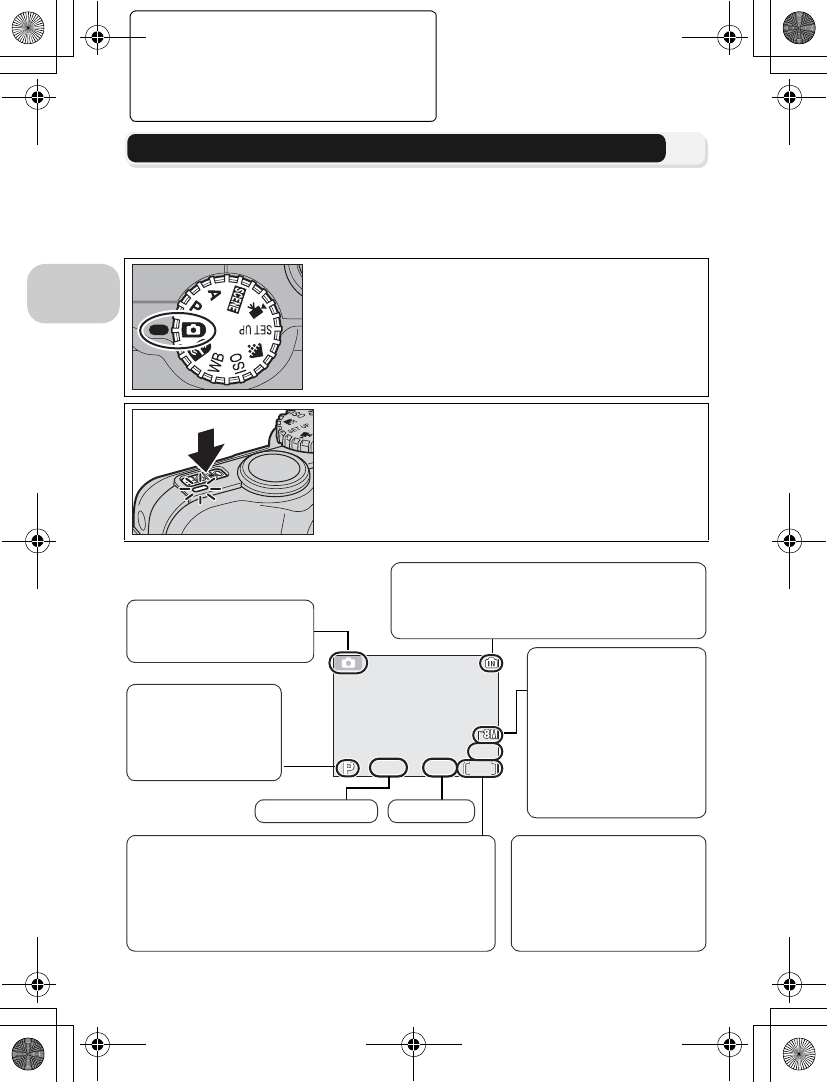
18
Basic Photography
Basic Photography
Step 1–Select X Mode
This section details the basic steps involved in taking pictures in X (Auto shoot-
ing mode). In this automatic, “point-and-shoot” mode, the majority of camera
settings are controlled by the camera in response to shooting conditions, produc-
ing optimal results in most situations.
1Rotate the mode dial to X
2Turn the camera on
The power-on lamp will light and the monitor will
display a welcome screen (c117). The camera is
ready to shoot when the monitor shows the view
through the camera lens.
NORM
NORM
15
15
1/60
1/60
F2.7
F2.7
Exposure mode
When taking pic-
tures in Auto shoot-
ing mode, P is
displayed (c45).
Shooting mode
X indicates Auto shoot-
ing mode.
Internal memory/Memory card
When the camera contains a memory card,
O is displayed, and when there is no mem-
ory card in the camera, M is displayed.
Number of exposures remaining
The number of pictures that can be stored in the in-
ternal memory or on a memory card depends on the
capacity of the memory or memory card and the op-
tion chosen for Image mode (Image quality and
Image size) (c47).
Image quality
Choose from three options
depending on how you
plan to use the picture
(c47). The default setting
is NORMAL.
Image size
Choose from eight op-
tions (for P1) or seven
options (for P2) depend-
ing on how you plan to
use the picture (
c
47).
The default setting is
c
3264 × 2448
for P1,
d
2592 × 1944
for P2.
Shutter speed Aperture
en_q3175.book Page 18 Thursday, June 16, 2005 10:54 AM
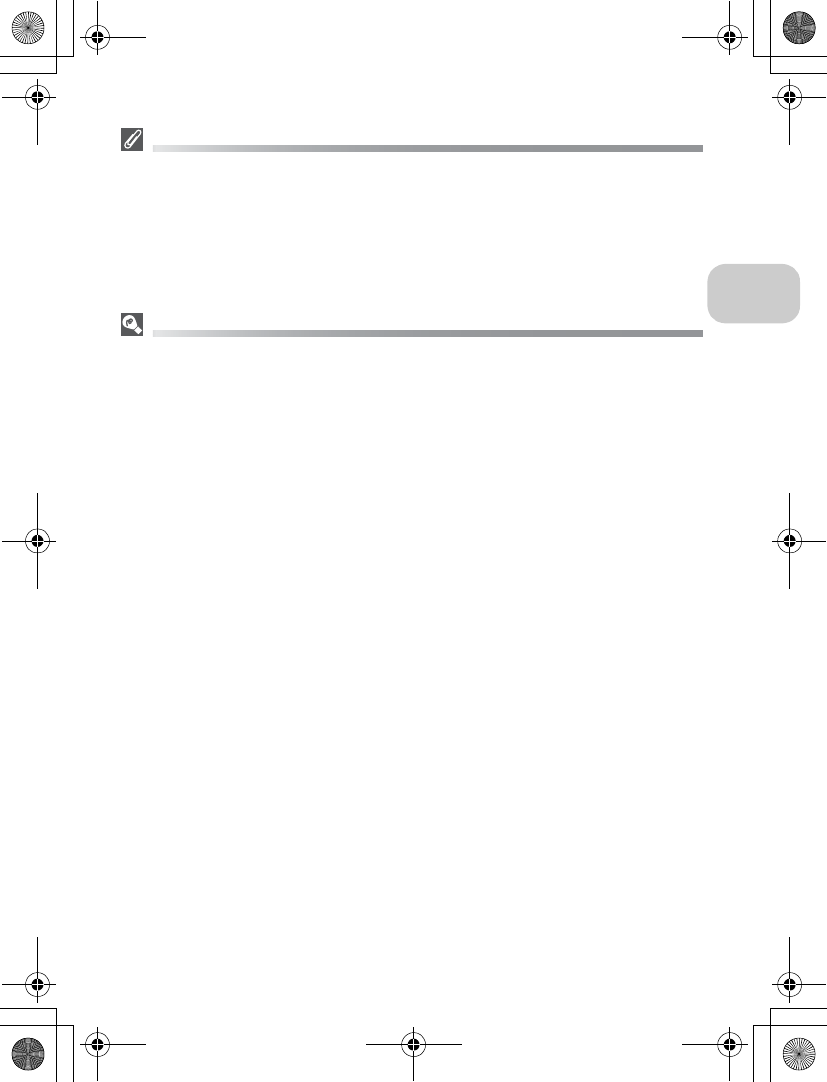
19
Basic Photography
Number of Exposures Remaining
If the number of exposures remaining is zero, the message “OUT OF MEMORY” will be dis-
played in the monitor and no further pictures can be taken until you:
•Choose a lower image quality or image size setting (c47) (depending on certain condi-
tions, no further pictures may be taken even if you change the setting).
•Insert a new memory card (c12).
•Remove the memory card so that pictures will be recorded in the internal memory (pictures
can be taken only when the internal memory has space).
•Delete some pictures in the internal memory or on a memory card (c111).
Available Functions in Auto Shooting Mode
In X (Auto shooting) mode, the Flash, Self-timer, Focus, and Exposure compensation can
be set (c26). In Z mode, Image quality and Image size can be set.
en_q3175.book Page 19 Thursday, June 16, 2005 10:54 AM
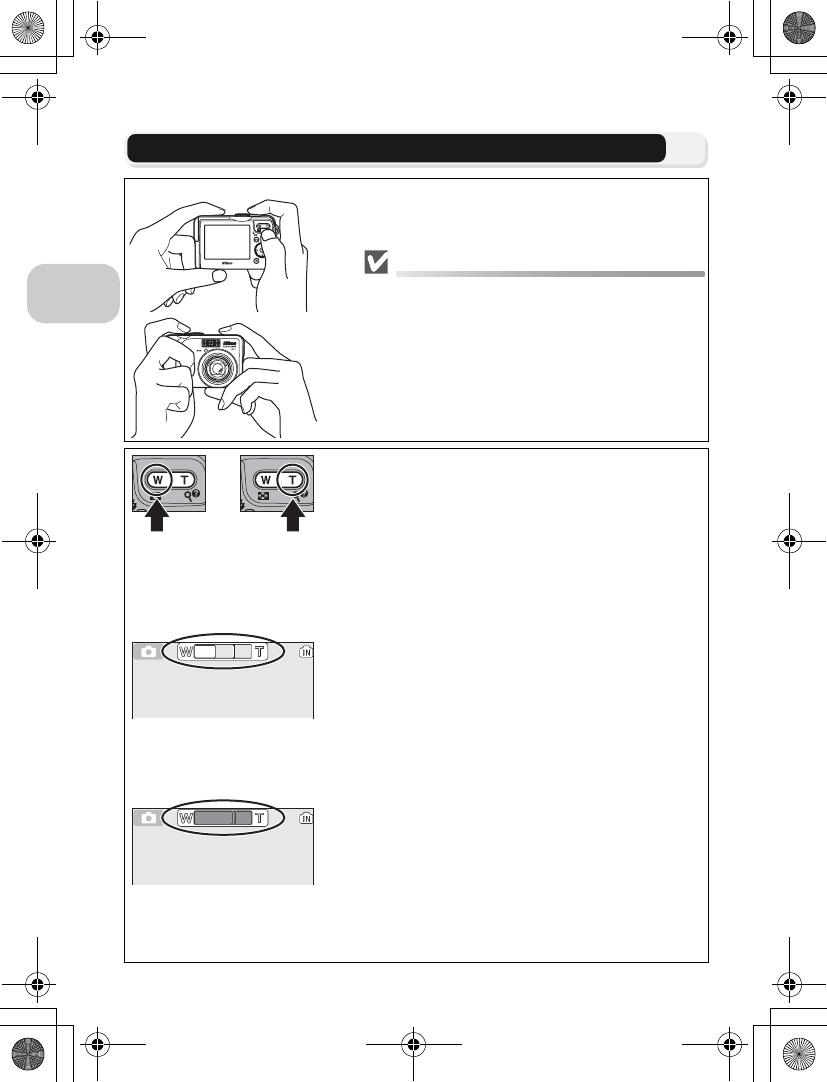
20
Basic Photography
Step 2–Frame the Picture
1Ready the camera
Hold the camera steadily in both hands. Photo-
graphs can be framed in the monitor.
Don’t Block the Shot
To avoid dark or partially obscured pictures, keep your
fingers and other objects away from the lens, flash
window, AF-assist illuminator, microphone, and an-
tenna.
2Frame your subject
Your Nikon digital camera is equipped with two
types of built-in zoom: optical zoom, in which the
camera’s telescoping lens can be used to magnify
the subject up to 3.5 ×, and digital zoom, in which
digital processing is used to further magnify the
image up to 4 ×, for a total of 14 ×. Use the zoom
buttons to frame your subject in the center of the
monitor:
•Press the j (W) button to zoom out from your
subject, increasing the area visible in the frame.
•Press the k (T) button to zoom in on your sub-
ject so that it fills a larger area of the frame.
To use digital zoom
When the camera is zoomed in to maximum mag-
nification, holding the k (T) button down for more
than two seconds will trigger digital zoom. The
zoom indicator will turn yellow. Use the k (T) and
j (W) buttons to adjust zoom in the digital zoom
range. To cancel digital zoom, press j (W) until
the zoom indicator turns white.
Zoom out Zoom in
Indicator in monitor
shows amount of zoom
when either button is
pressed
Digital zoom
NORM
15
1/60
F2.7
NORM
15
1/60
F2.7
en_q3175.book Page 20 Thursday, June 16, 2005 10:54 AM
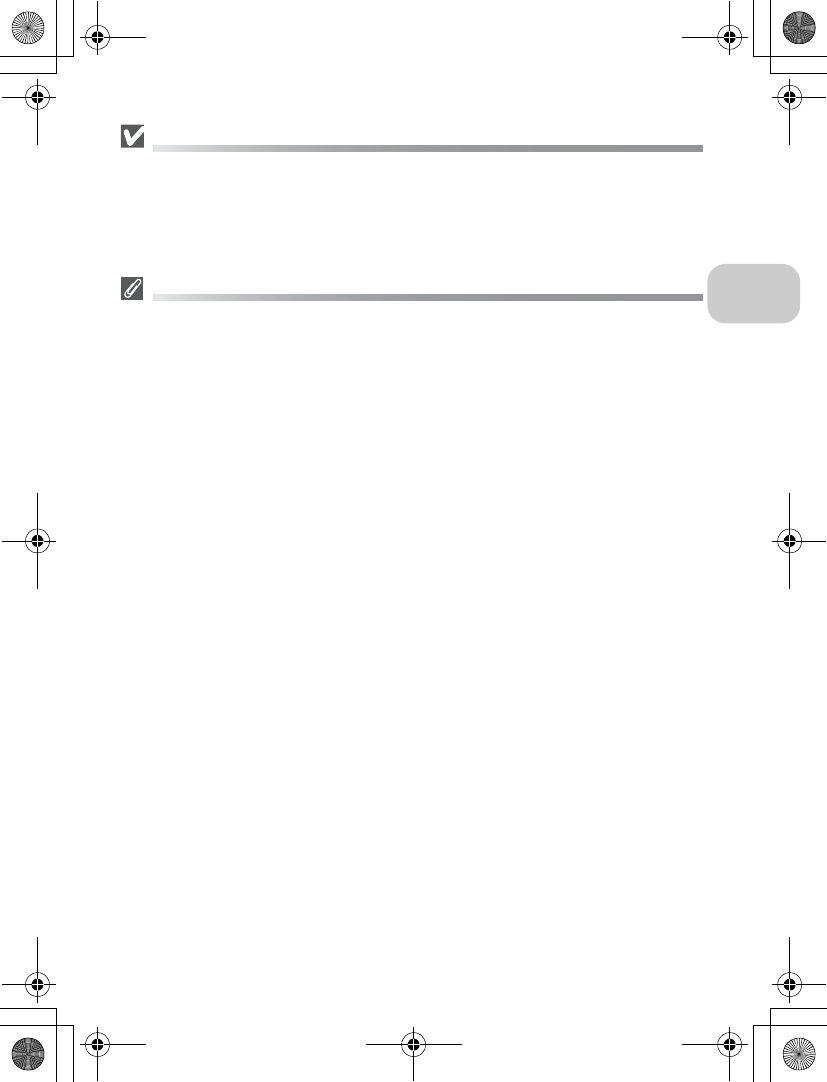
21
Basic Photography
Digital Zoom
•In digital zoom, data from the camera’s image sensor is processed digitally, enlarging the
center area of the picture to fill the frame. Unlike optical zoom, digital zoom does not in-
crease the amount of detail visible in the picture. Instead, details visible at maximum opti-
cal zoom are simply enlarged, producing a slightly “grainy” image.
•When digital zoom is working, the focus area is fixed in the center of the frame (c97).
•When digital zoom is working, Metering is set just like nCenter-weighted (c88).
When Lighting Is Poor
When lighting is poor, sensitivity is raised to compensate and the image in the monitor may
be slightly mottled. This is normal and does not indicate a malfunction.
en_q3175.book Page 21 Thursday, June 16, 2005 10:54 AM
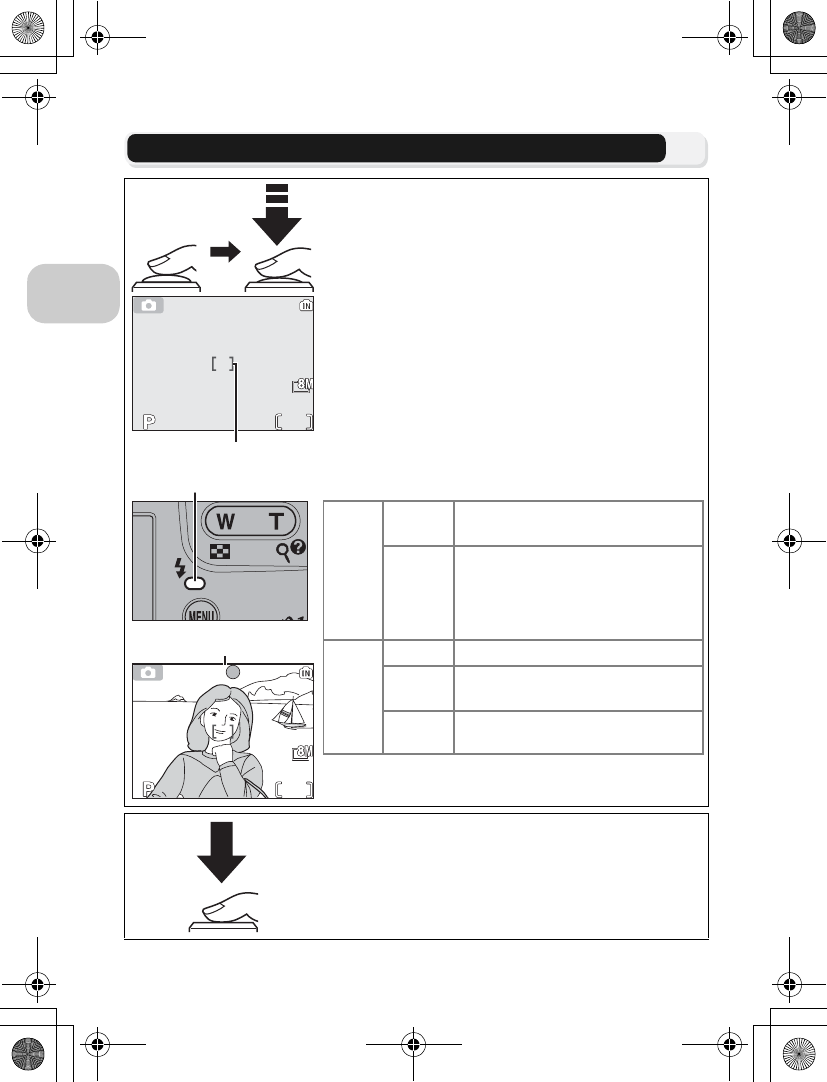
22
Basic Photography
Step 3–Focus and Shoot
1Focus
Press the shutter-release button halfway to set
focus and exposure.
The camera has a two stage shutter-release but-
ton. The camera sets focus and exposure when the
button is pressed halfway. Focus and exposure will
remain locked while the shutter-release button is
kept in this position.
•In X mode, the camera focuses with Auto-
focus on subject at center of frame.
•When subject is in focus, the selected Focus area
turns green.
2Take the picture
•Press the shutter-release button the rest of the
way down to take the picture.
•To prevent blur, press the shutter-release button
down smoothly.
NORM
NORM
15
15
1/60
1/60
F2.7
F2.7
Red (C) Lamp
AF
AF
15
15
NORM
NORM
1/60
1/60
F2.7
F2.7
Focus indicator
Focus area With the shutter-release button pressed halfway, check
the focus indicator and Red (C) lamp:
On
(green) Subject in focus.
Blinks
red
Camera unable to focus on subject
at center of frame. Using focus lock,
focus on another subject at same
distance, then recompose picture
and shoot.
On (red) Flash will fire when picture is taken.
Blinks
red Flash is charging.
Off Flash is off or not required.
Focus
indicator Red (
C
) lamp
en_q3175.book Page 22 Thursday, June 16, 2005 10:54 AM
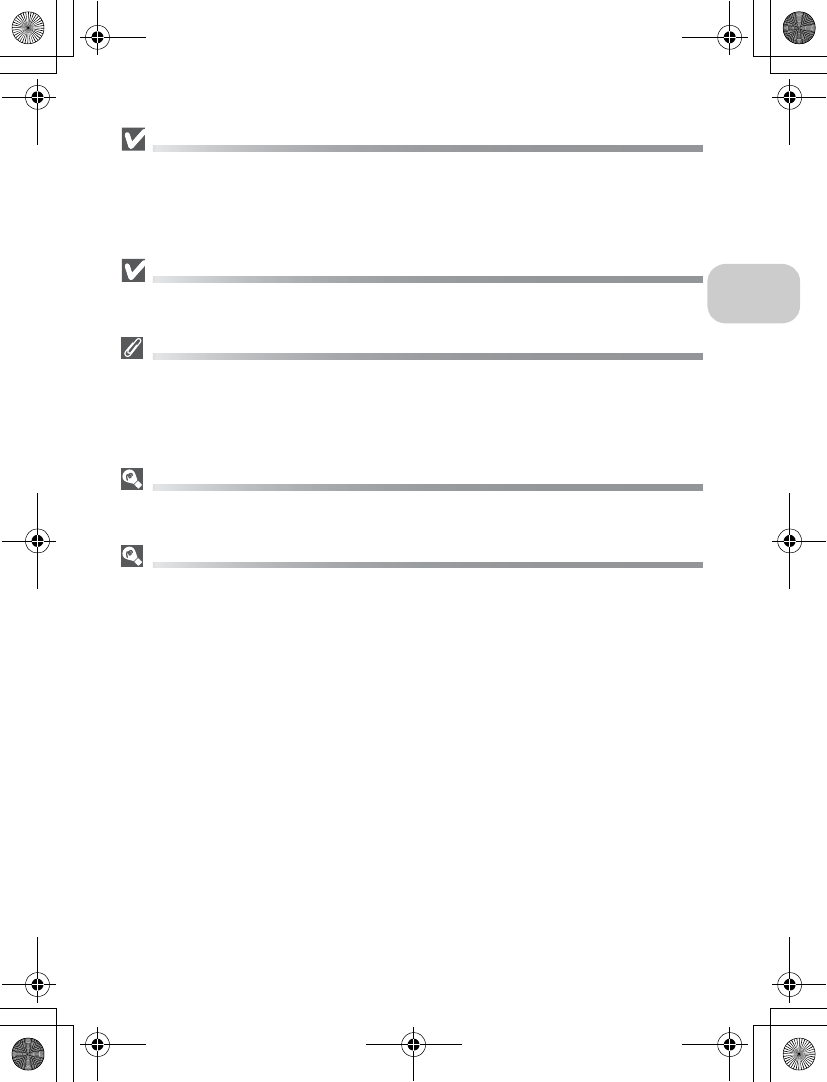
23
Basic Photography
During Recording
While pictures are being recorded to the memory or memory card, the memory icon (O or
M) will blink. Do not turn the camera off, eject the memory card, or remove or dis-
connect the power source while pictures are being recorded. Cutting power or remov-
ing the memory card in these circumstances could result in loss of data or in damage to the
camera, internal memory, or card.
Low Battery
If the flash fires when the low battery icon is displayed, the monitor will turn off while the
flash recharges.
Getting Good Results with Autofocus
Autofocus performs best when there is contrast between the subject and the background
and the subject is evenly lit. It does not perform well if the subject is very dark or moving
rapidly, if there are objects of sharply differing brightness in the scene (e.g., the sun is behind
your subject and their features are in deep shadow), or if there are several objects at different
distances from the camera at the center of the frame (e.g., your subject is inside a cage).
Autofocus
The COOLPIX P1/P2 has two modes that allow control of the Autofocus; AF area mode
(c97) and Auto-focus mode (c100).
AF-Assist Illuminator
COOLPIX P1/P2 is equipped with an AF-assist illuminator. If lighting is poor, the built-in AF-
assist illuminator will light when the shutter-release button is pressed halfway, allowing the
camera to focus even when the subject is poorly lit. For more information on AF-assist illu-
minator, see “u AF Assist” in the Set-up menu (c125).
en_q3175.book Page 23 Thursday, June 16, 2005 10:54 AM
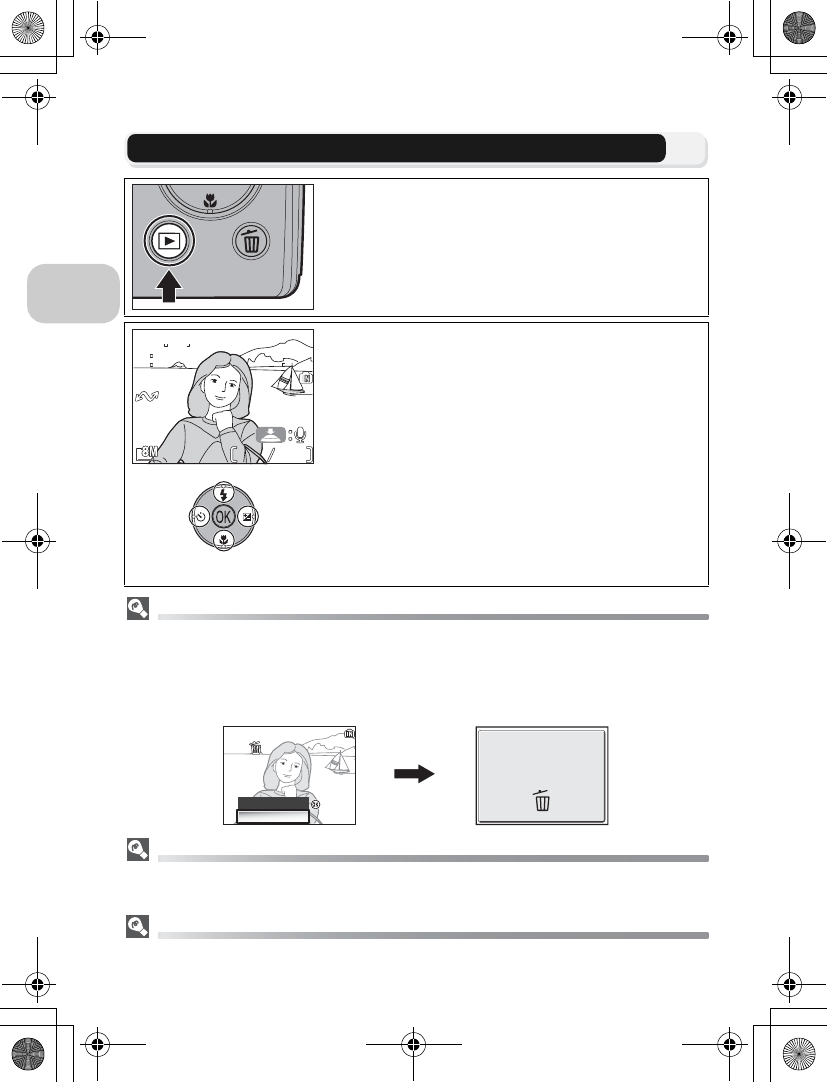
24
Basic Photography
Step 4–View the Results (Full-screen Playback)
Deleting Unwanted Pictures
During Shooting mode or Playback mode, pressing A displays the delete confirmation dialog
(except when a menu is displayed). Highlight Yes and press d to delete the currently dis-
played picture and return to Shooting mode or Playback mode.
•Highlight No and press d to return to Shooting screen or Playback screen without delet-
ing the picture.
The i Button
Pressing the i button for about one second will turn the camera on (Auto off is unavail-
able.). Press again to return to the mode selected with the mode dial.
More About Playback
For more information on playback, see “More on Playback” (c55 - 75).
1Press the i button
2View pictures in the monitor
•This mode is called “Full-screen playback.”
•
To view additional pictures, press multi selector
down or right to view pictures in the order
recorded, up or left to view pictures in reverse order.
•Pictures are displayed briefly at low resolution
while being read from the memory or a memory
card. This makes it possible to scroll rapidly
through the pictures in the memory or a mem-
ory card without waiting for each image to be
displayed at full resolution.
To cancel Full-screen playback and return to the
Auto shooting mode, press the i button again.
1
1
1
1
100NIKON
100NIKON
JPG
JPG
2005
2005
12
12
12
12
00
00
01
01
0008
0008
NORM
NORM
Done
Erase 1 image?
Erase 1 image?
No
:
Confirm
:
Confirm
Yes
en_q3175.book Page 24 Thursday, June 16, 2005 10:54 AM
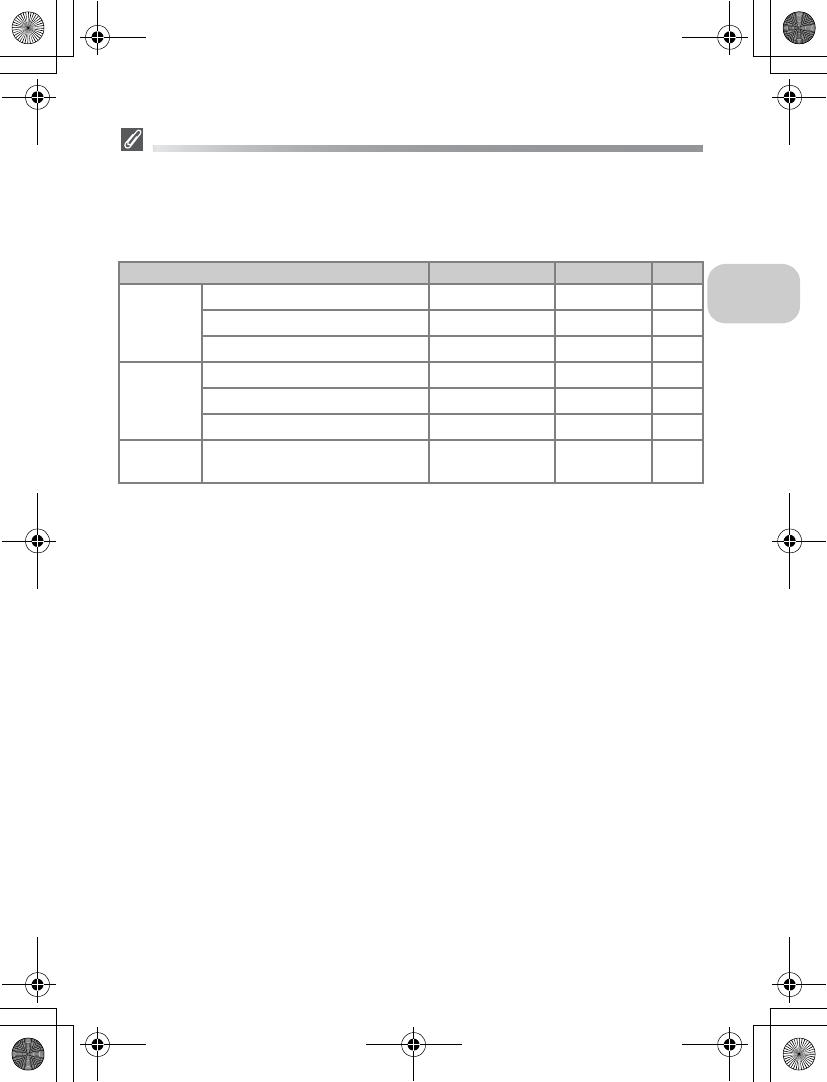
25
Basic Photography
Image File and Folder Names
In the memory or on the memory card, pictures are identified by file names with three parts:
a four letter identifier, a four-digit file number assigned automatically by the camera in as-
cending order, and a three-letter extension (e.g., “DSCN0001.JPG”). When a picture is
viewed in the monitor, the file number and extension appear in the top right corner of the
display. The identifier is not displayed, but is visible when images are transferred to a com-
puter.
•Pictures are stored in a folder created automatically by the camera. The folder name in-
cludes a three-digit folder number (e.g., 100NIKON).
•Folders can hold up to 200 pictures; if a picture is taken when the current folder contains
200 pictures, a new folder will be created by adding one to the largest folder number (e.g.,
100NIKON → 101NIKON).
•When taking pictures using FPanorama assist (c43), xUltra HS (c89), or
zIntvl timer shooting (c91), each sequence of pictures is stored in a folder with a
name consisting of a three-digit folder number followed by “XXXP_xxx”, “XXXN_xxx”, or
“XXXINTVL” (e.g., “101P_001”, “101N_001” or “101INTVL”).
•If you take a picture when the current folder contains a picture numbered 9999, a new
folder will be created and file numbering will begin again from 0001.
•If file number reaches 200 or picture number reaches 9999 when the memory or the
memory card contains a folder numbered 999, no further pictures can be taken, even if
there is still memory capacity. Replace the memory card, or transfer all pictures to a com-
puter (c61) and then format the memory or the memory card (c128).
Picture type Identifier Extension c
Original
Still picture DSCN .JPG 24
Movie DSCN .MOV 85
Time-lapse movie INTN .MOV 83
Copy
Copy created using Small pic. SSCN .JPG 79
Cropped copy RSCN .JPG 77
Copy created using D-Lighting FSCN .JPG 78
Audio file Voice memo DSCN, RSCN,
SSCN, FSCN .WAV 58
en_q3175.book Page 25 Thursday, June 16, 2005 10:54 AM
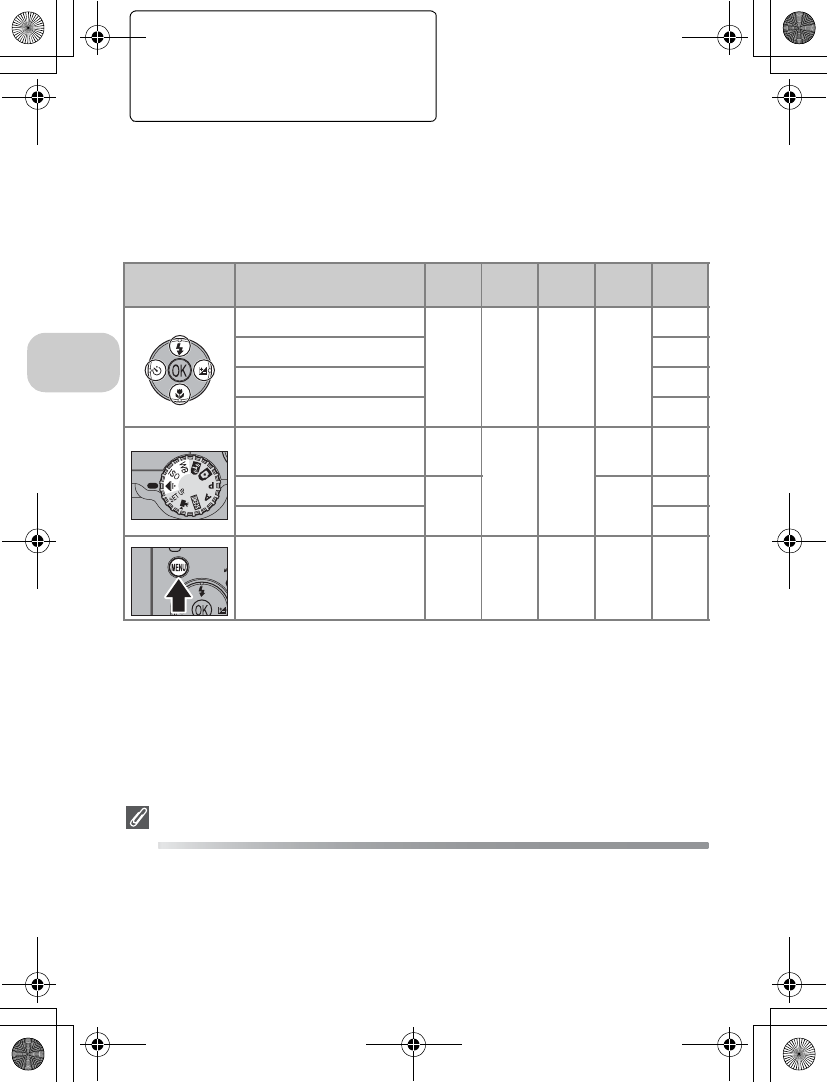
26
More on Photography
More on Photography
In addition to X (Auto shooting) mode explained in “Basic Photography”
(c18), the COOLPIX P1/P2 has other shooting modes which are P (Programmed
auto) mode, A (Aperture-priority auto) mode, and b (Scene) mode. Use the
mode dial to select the mode.
Some functions can be set when taking pictures with all the modes and some
functions can only be set in P and A modes.
*1The functions that can be set depend on the scene mode in use (c34). See Scene mode for more
information.
*2Can be set from Shooting menu in P (Programmed auto) mode and A (Aperture-priority auto)
mode (c86).
*3Pressing m in b (Scene) mode displays the Scene menu (c34).
When the Focus Area Selection Guide or Exposure Compensation
Setting Screen is Displayed
When the Focus area selection guide (c97) is displayed, Flash mode (c27), Self-timer mode
(c30), Focus mode (c31), and Exposure compensation (c33) cannot be set.
When the Exposure compensation setting screen (c33, 45) is displayed, Flash mode (c27),
Self-timer mode (c30), and Focus mode (c31) cannot be set.
Press d to hide Focus area selection guide or Exposure compensation setting screen and se-
lect mode.
How to
select Function XP A b c
C Flash
{{{{
*1
27
H Self timer 30
F Focus mode 31
I Exposure comp. 33
Z Image mode (image
quality and image size) {
{*2 {*2
{47
Sensitivity --
50
d White balance 52
Functions for Shooting
menu -{{-*3 86
en_q3175.book Page 26 Thursday, June 16, 2005 10:54 AM
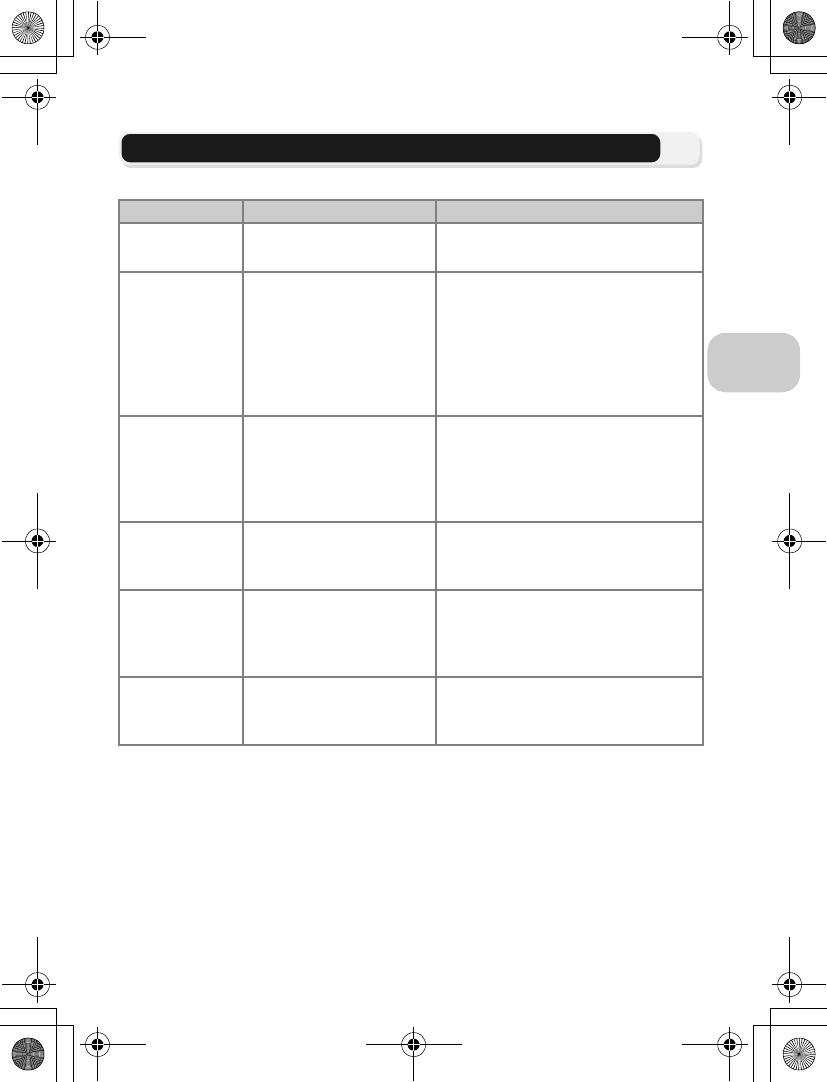
27
More on Photography
C
When Lighting Is Poor: Using the Flash
The following six flash modes are available:
Mode How it works When to use it
z
Auto
Flash fires when lighting is
poor. Best choice in most situations.
A
Auto with red-
eye reduction
Pre-flash is used before the
main flash fires to reduce
“red-eye.” If “red-eye” is
detected after an image is
taken, the camera will cor-
rect “red-eye” when stor-
ing the picture.
Use for portraits (works best when
subject is well within range of flash
and looking at pre-flash). Not recom-
mended when quick shutter response
is required.
B
Flash Cancel
(off)
Flash will not fire even
when lighting is poor.
Use to capture natural lighting under
dim light or where use of flash is pro-
hibited. If J (camera shake) icon
appears, care should be taken to
avoid blurring.
C
Anytime Flash
(fill flash)
Flash fires whenever pic-
ture is taken.
Use to “fill-in” (illuminate) shadows
and back-lit subjects.
CD
Slow sync
Auto flash combined with
slow shutter speeds.
Use to capture both subject and back-
ground at night or under dim light.
Care should be taken to avoid blur-
ring.
E
Rear-curtain
sync
Shutter speed slows; built-
in flash fires just before
shutter closes.
Creates stream of light trailing mov-
ing objects. Care should be taken to
avoid blurring when lighting is poor.
en_q3175.book Page 27 Thursday, June 16, 2005 10:54 AM
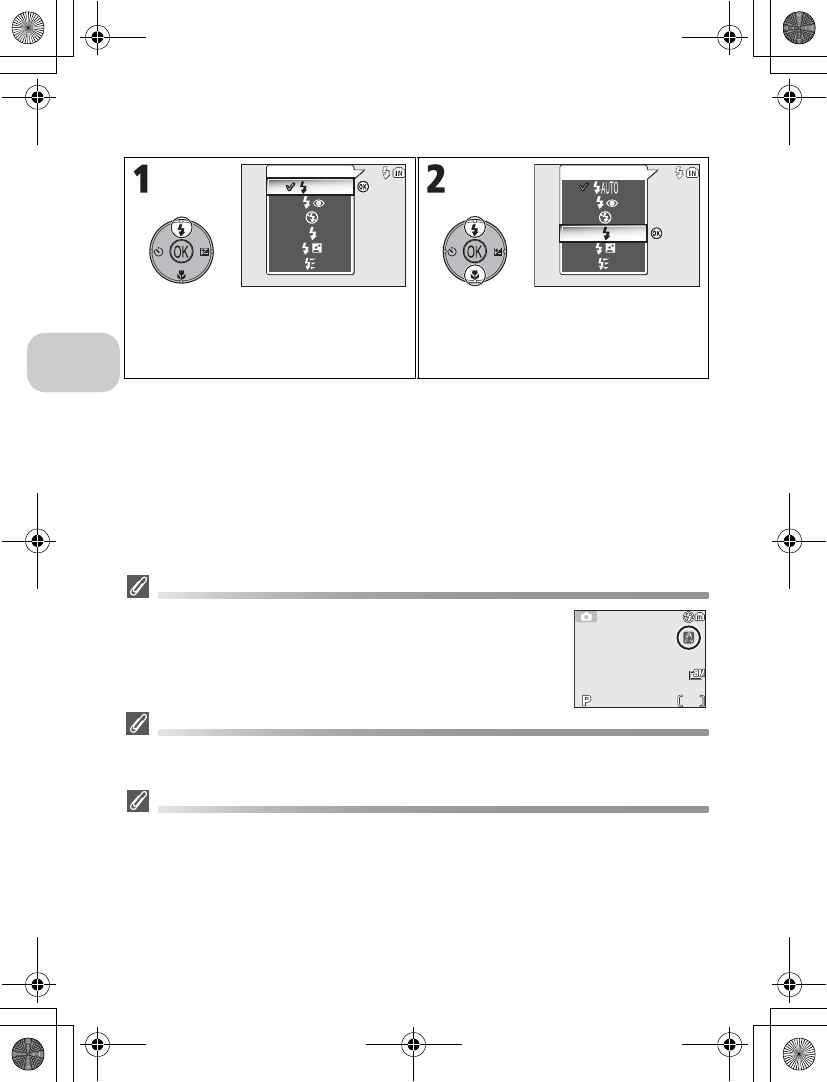
28
More on Photography
To choose the flash mode:
The J (Camera Shake) Icon
When lighting is poor and the Flash is off (B), shutter speeds will
slow and pictures may be blurred. If the shutter speed required for
exposure is very slow, the J (camera shake) icon will appear in the
monitor as a warning. Use of a tripod or support is recommended.
Using the Built-In Flash
Light from the flash reflected from particles of dust or other matter in the air may appear in
pictures as bright specks. If this occurs, turn the flash off or zoom in and try again.
Flash Mode Selection
Flash mode is not available in the following cases:
•When taking pictures using sContinuous H, uContinuous L, xUltra HS, or
y5 shot buffer (c89)
•BSS is set to On (c92).
•Auto bracketing is set to CAuto bracketing (c93).
•Taking a picture in some scene modes (c34 - 44).
•Taking a picture when Focus mode is set to w (Infinity mode) (c31).
•Recording a movie other than Time-lapse movie (c81).
Display Flash menu. Highlight desired mode and press d.
Flash mode is displayed in monitor (to exit
without changing mode, wait two sec-
onds without pressing d).
:
Confirm
:
Confirm
Flash
AUTO
Flash
:
Confirm
:
Confirm
NORM
NORM
15
15
1/60
1/60
F2.7
F2.7
en_q3175.book Page 28 Thursday, June 16, 2005 10:54 AM
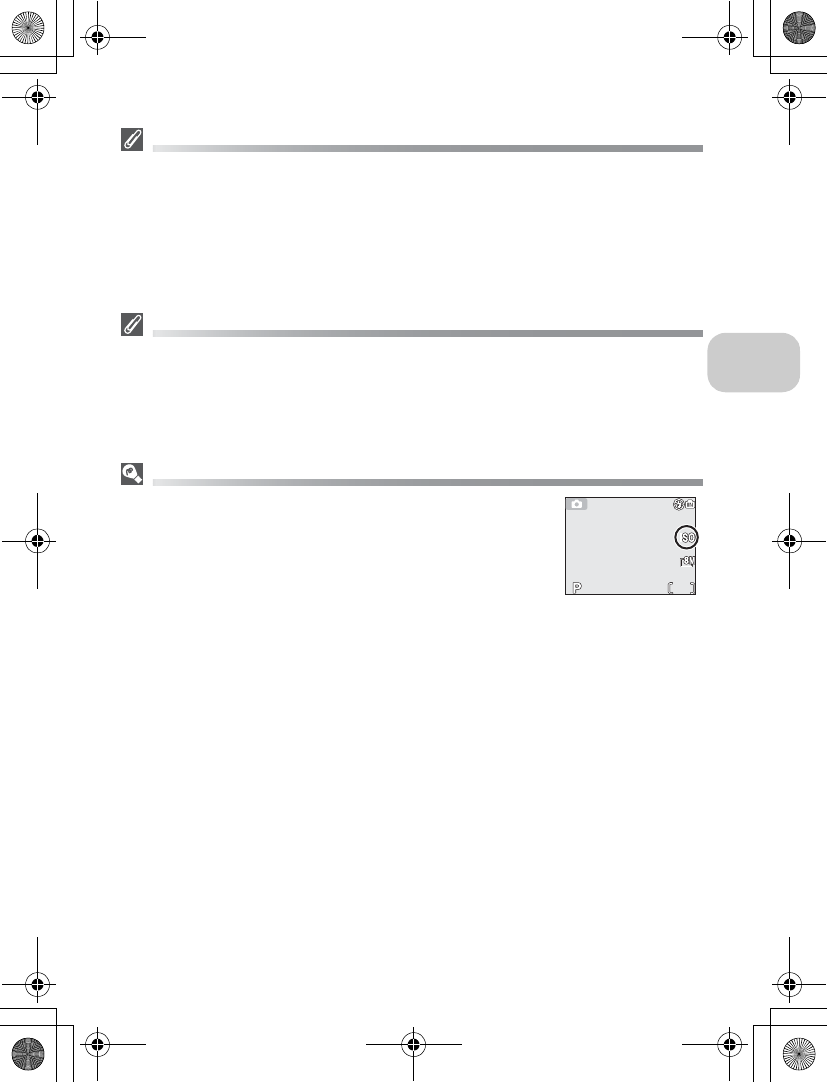
29
More on Photography
Red-Eye Reduction
The “Red-eye reduction” flash function of the COOLPIX P1/P2 uses an advanced red-eye re-
duction method. Several pre-flashes are fired before the main flash fires to reduce “red-eye.”
In addition to this function, if “red-eye” is detected the camera will automatically correct it
when storing the picture (“In-Camera Red-Eye Fix”). Using this function there is slight delay
before you can press the shutter release again for the next shot. Depending on the situation,
red-eye reduction may not always produce the desired results. In some rare cases, other pic-
ture areas may be affected as well as the “red-eye” area. In this case, choose another flash
mode and try again.
Flash Range
•Flash range varies with zoom position. When the camera is zoomed all the way out, the
flash has a range of approximately. XXX - XXX m/XXX' - XXX". When the camera is
zoomed all the way in, the flash has a range of approximately. XXX - XXX m/XXX' - XXX"
with Auto in Sensitivity.
•The flash may not be able to light the entire subject at distances of less than XXX cm
(XXX'). When taking close-ups, play each picture back after shooting to check the results.
Sensitivity (ISO Equivalency)
Sensitivity is a measure of how sensitive the camera responds to
light. Your Nikon digital camera normally has a sensitivity roughly
equivalent to film with an ISO 50 rating for COOLPIX P1 or ISO 64
rating for COOLPIX P2.
When sensitivity is set to Auto, the camera will automatically in-
crease sensitivity in response to lighting conditions, permitting faster
exposures and minimizing blur caused by inadvertent camera move-
ment (camera shake).
An ISO icon will be displayed to warn that pictures may be slightly mottled.
NORM
NORM
15
15
1/60
1/60
F2.7
F2.7
en_q3175.book Page 29 Thursday, June 16, 2005 10:54 AM
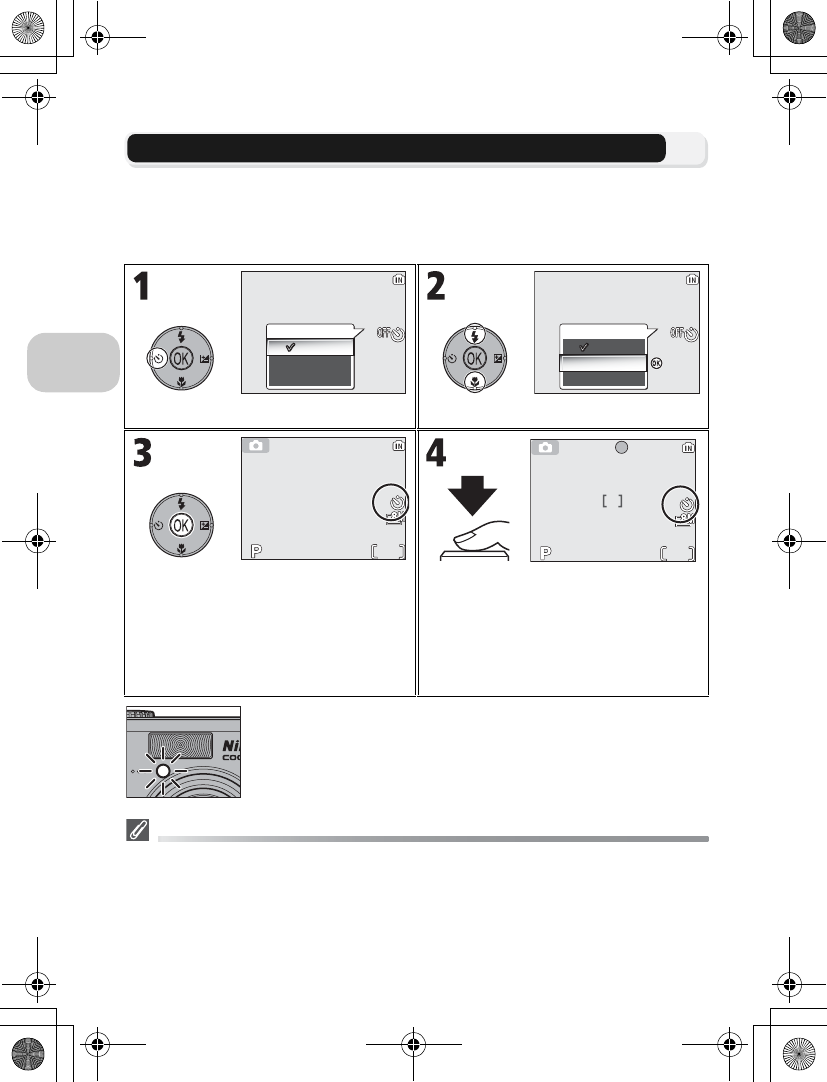
30
More on Photography
H
Taking a Self-Portrait: Using the Self-Timer
When the self-timer is on, pictures are taken 10 or 3 seconds after the shutter-
release button is pressed. This can be used to allow you to appear in your own
pictures or to prevent close-up or low-light shots from being blurred by the cam-
era movement that occurs when the shutter-release button is pressed.
The self-timer lamp on the front of the camera will blink until
one second before the picture is taken, staying lit during the fi-
nal second to warn that the shutter is about to be released.
The Self-Timer
•When using the self-timer, mount the camera on a tripod (recommended) or rest it on a
flat, level surface.
•If an option other than zIntvl timer shooting is selected for Continuous (c89), Con-
tinuous will automatically be set to rSingle.
•When BBS is set to ON or Auto bracketing is set to CAuto bracketing, Continuous
will automatically be set to rSingle.
Display Self-timer menu. Highlight option.
Exit menu. H icon is displayed in monitor
(to exit without setting the self-timer,
wait two seconds without pressing d).
Start timer.
•Countdown timer in monitor shows
number of seconds remaining until
shutter is released.
•Press the shutter-release button again
to stop the self-timer.
10s
3s
Self-timer
OFFOff
10s
3s
:
Confirm
:
Confirm
Self-timer
Off
10s
NORM
NORM
10
10
15
15
1/60
1/60
F2.7
F2.7
15
15
NORM
NORM
10
10
AF
AF
1/60
1/60
F2.7
F2.7
en_q3175.book Page 30 Thursday, June 16, 2005 10:54 AM
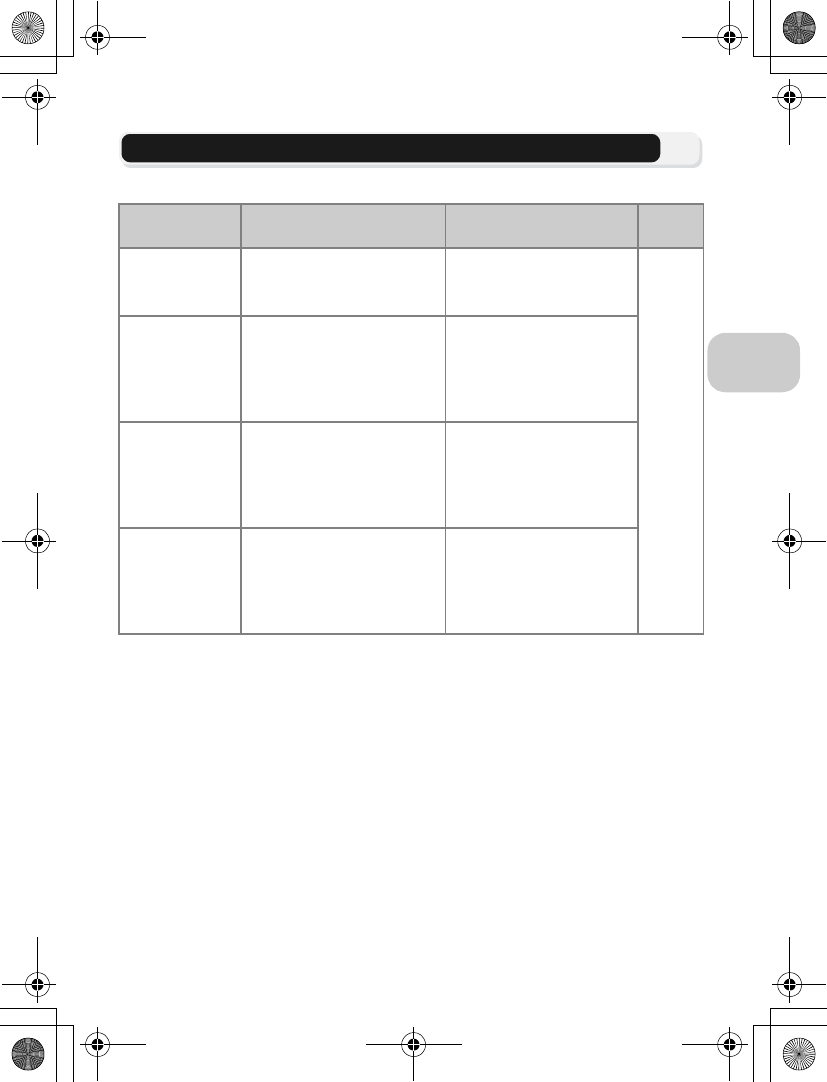
31
More on Photography
F
Focusing on the Subject: Using Focus Mode
Choose a focus mode according to the subject and composition.
Mode How it works When to use it Mode
dial
NO ICON
Autofocus
Camera automatically adjusts
focus according to distance to
subject.
Use when subject is 50 cm
(1'8") or more from lens.
X
P
A
b
S
Y
w
Infinity
Camera focuses at infinity;
focus indicator lights when-
ever shutter-release button
is pressed halfway. Flash is
disabled.
Use when shooting distant
scenes through fore-
ground objects such as
windows.
2 m - ∞
(6'7" - infinity)
####
Camera can focus on sub-
jects 2 m or more from the
lens.
Use when subject is 2 m
(6'7") or more from the
lens. Camera focuses on
subjects faster than with
normal Autofocus.
F
Macro
close-up
If zoomed in or out until F
icon in the shooting display
turns green, camera can
focus on objects as close as
4 cm (1.6") to the lens.
Use for close-ups.
en_q3175.book Page 31 Thursday, June 16, 2005 10:54 AM
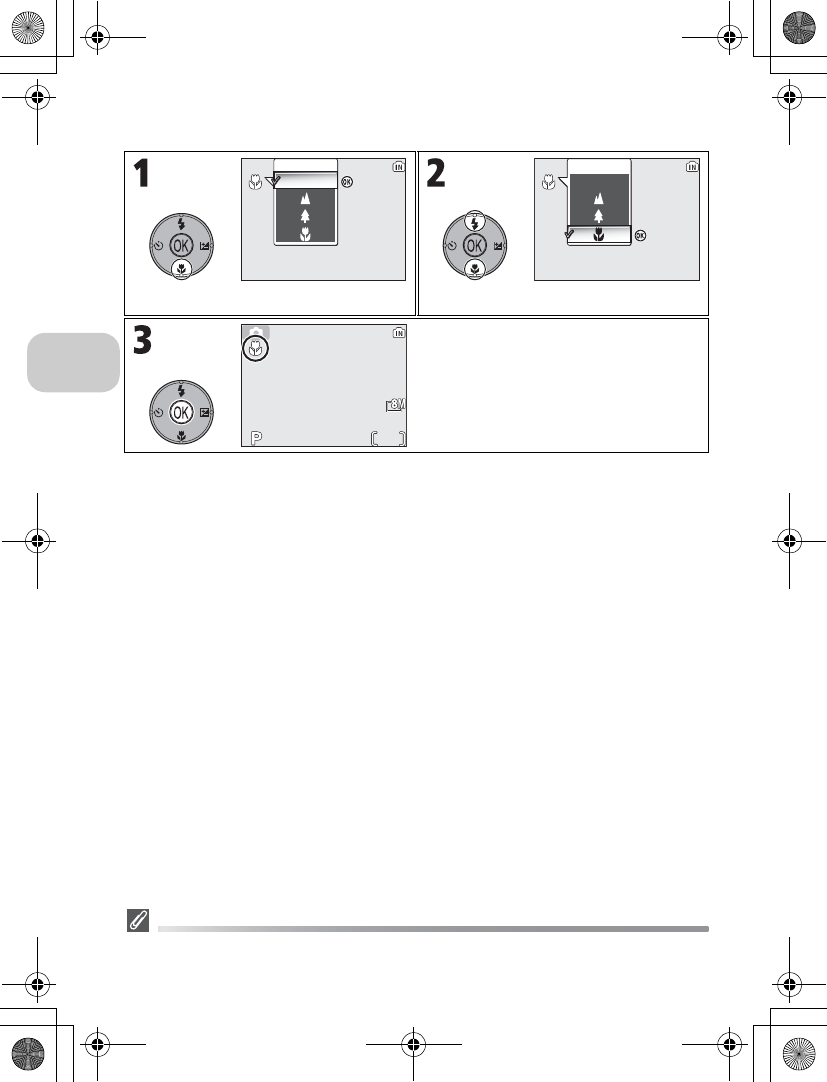
32
More on Photography
To choose the focus mode:
Focus Mode
Focus mode is not available in some scene modes (c34 - 44).
Display Focus mode menu. Highlight option.
Exit menu. Focus mode icon appears in
monitor (to exit without setting Focus
mode, wait two seconds without press-
ing d).
AF
Focus mode
:
Confirm
:
Confirm
AF AF
Focus mode
:
Confirm
:
Confirm
15
15
NORM
NORM
en_q3175.book Page 32 Thursday, June 16, 2005 10:54 AM
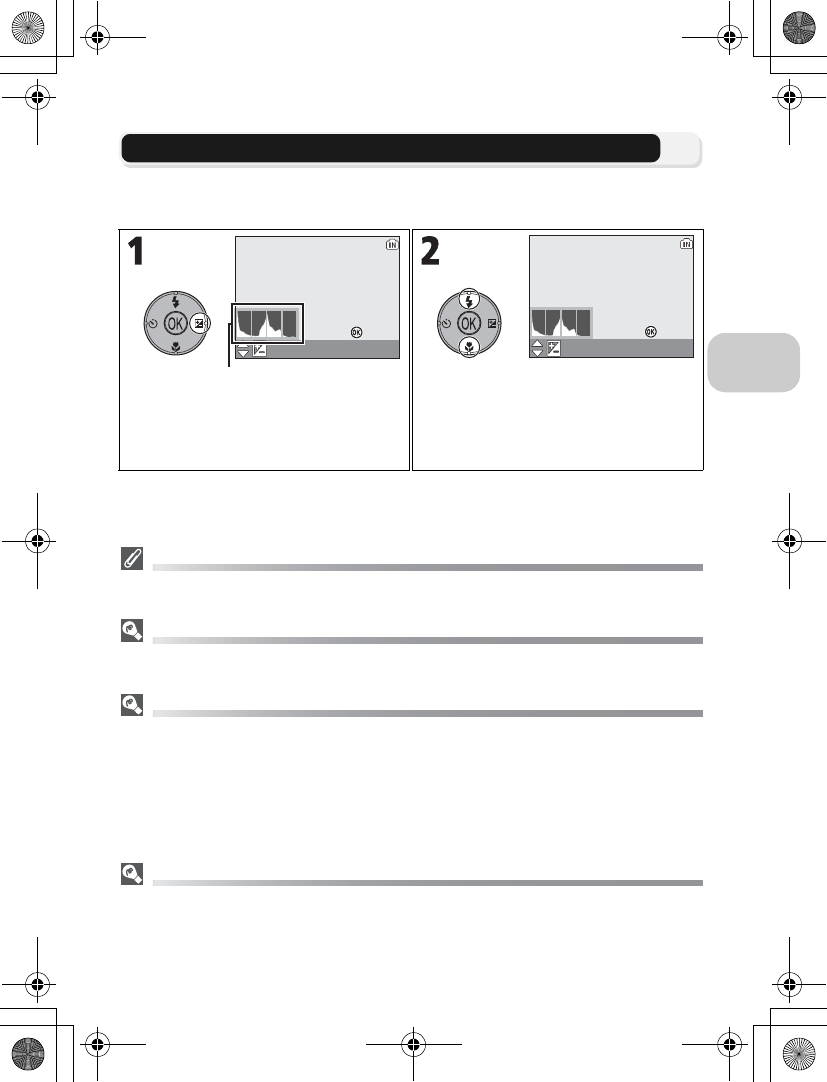
33
More on Photography
I
Controlling Exposure: Exposure Compensation
Exposure compensation is used to alter the exposure from the value suggested by
the camera. Exposure compensation can be set to values between –2.0 EV (un-
derexposure) and +2.0 EV (overexposure) in increments of 1/3 EV.
Exposure Compensation
Exposure compensation is not available when KFIREWORKS SHOW (c39) is selected in
the Scene mode.
Exposure Compensation in P and A Modes
In addition to exposure compensation, exposure can be set with flexible program in P (Pro-
grammed auto) mode and aperture in A (Aperture-priority auto) mode.
Choosing a Value for Exposure Compensation
As a rule of thumb, select positive values when large areas of the frame are very brightly lit (for
example, when photographing an expanse of sunlit water, sand, or snow) or when the back-
ground is much brighter than the main subject. Choose negative values when large areas of
the frame are very dark (for example, when photographing a forest of dark green leaves) or
when the background is much darker than the main subject. This is because the camera, in or-
der to avoid extreme under- or over-exposure, tends to lower exposure when the frame is very
bright and raise exposure when the frame is very dark. This can make naturally bright subjects
look darker and naturally dark subjects appear over-bright, or “washed out.”
Histogram
A histogram shows distribution of tones in image; horizontal axis corresponds to pixel bright-
ness, with dark tones to left and bright tones to right, while vertical axis shows number of
pixels of each brightness in the image.
The scale of an axis is determined by the maximum number of pixels of a picture.
Display value for exposure compensation
(exposure compensation setting screen)
and histogram (distribution of tones).
Highlight desired value.
•You can frame your subject, focus, and
shoot.
•Press d to exit.
:
Exit
:
Exit
0
0
Histogram
1.0
1.0
:
Exit
:
Exit
en_q3175.book Page 33 Thursday, June 16, 2005 10:54 AM
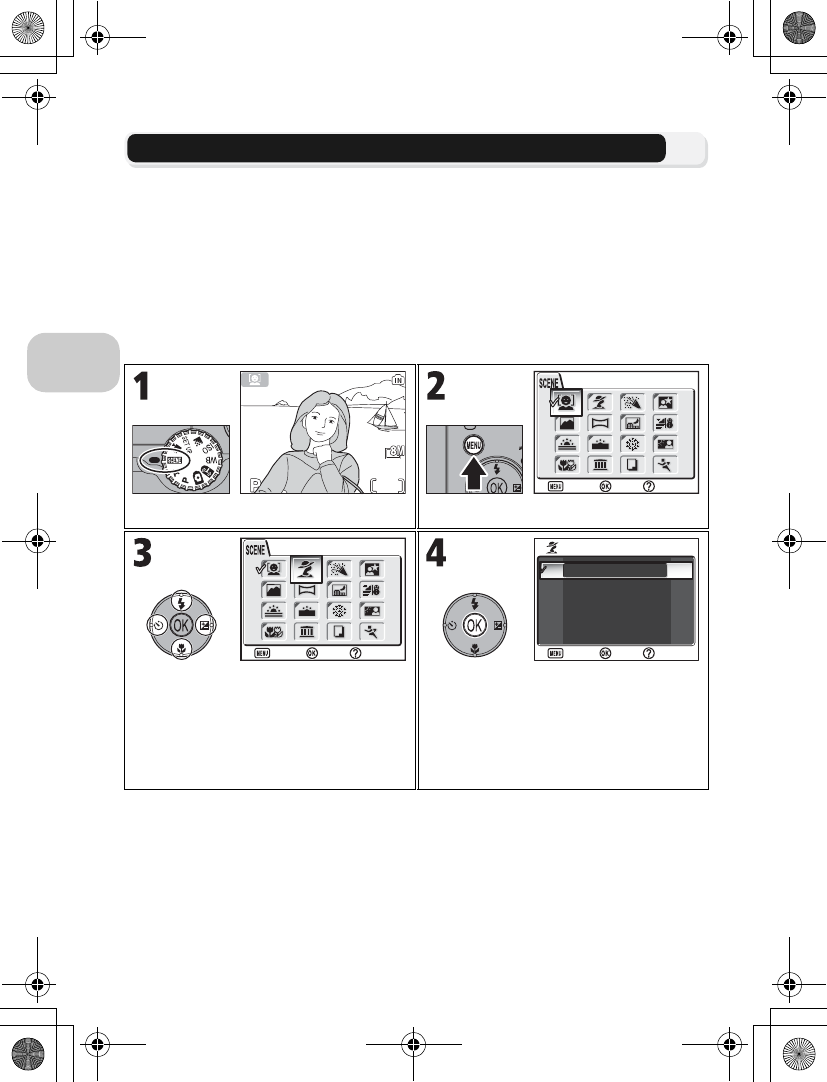
34
More on Photography
b Scene Mode
Scene mode offers a menu of 16 “scenes”, each corresponding to a common sit-
uation, such as a backlit subject, sunset, or interior shot. Camera settings are au-
tomatically adjusted to suit the selected scene, sparing the user the necessity of
adjusting each setting separately.
With Advanced option, 3 effects, including NORMAL, can be selected for 11 of
the 16 scenes. For example, you can adjust an image in Portrait mode so that skin
tones appear brighter.
To choose a scene:
Select Scene mode (default is A). Display Scene menu.
Highlight scene.
•To exit without changing current selec-
tion, press m.
Display Advanced options menu.
•If there are no options, selected scene
mode is set and screen returns to
Shooting mode. Selected scene shown
by icon in top left corner of the moni-
tor.
NORM
NORM
15
15
1/60
1/60
F2.7
F2.7
PORTRAIT (FACE AF)
Confirm
Exit Help
PORTRAIT
Confirm
Exit Help
1
EFFECT 2
NORMAL
EFFECT 1
PORTRAIT
PORTRAIT
Confirm
Exit Help
en_q3175.book Page 34 Thursday, June 16, 2005 10:54 AM
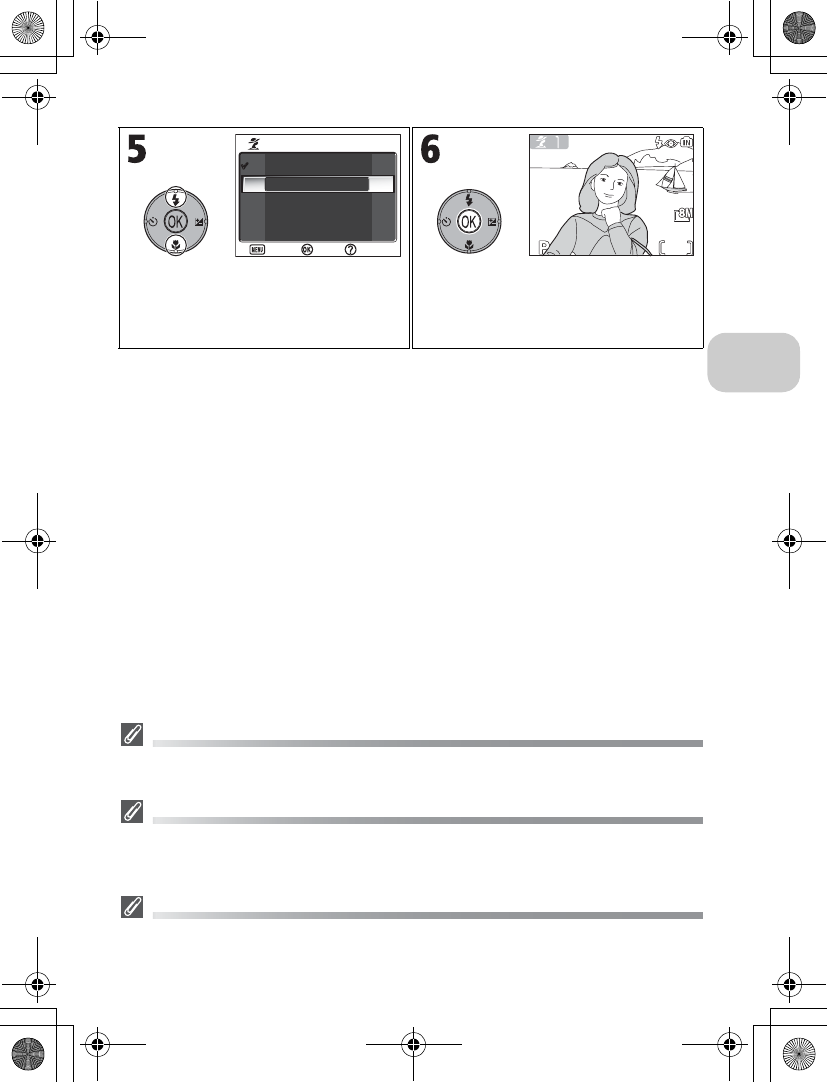
35
More on Photography
Scene Modes
Depending on your subject, scene modes may not always produce the desired results. If re-
sults are not to your satisfaction, choose X (Auto shooting), P or A and try again.
AF-assist Illuminator
AF-assist illuminator will not light in ELANDSCAPE, GNIGHT LANDSCAPE, JDUSK/
DAWN, KFIREWORKS SHOW, NMUSEUM, or PSPORTS modes, or when the center
focus area is not selected in BPORTRAIT, DNIGHT PORTRAIT, or MCLOSE UP.
Checking Advanced Options Effects
You may not be able to check Advanced options effects in the monitor. Play back the picture
and check effects.
Highlight option. Set option and return to shooting mode.
•If Advanced option is not set to
NORMAL, the selected effect (1 or 2)
appears next to the scene mode icon.
1
PORTRAIT
PORTRAIT
Help
Help
Confirm
Confirm
Exit
Exit
EFFECT 2
NORMAL
EFFECT 1
NORM
NORM
15
15
1/60
1/60
F2.7
F2.7
en_q3175.book Page 35 Thursday, June 16, 2005 10:54 AM
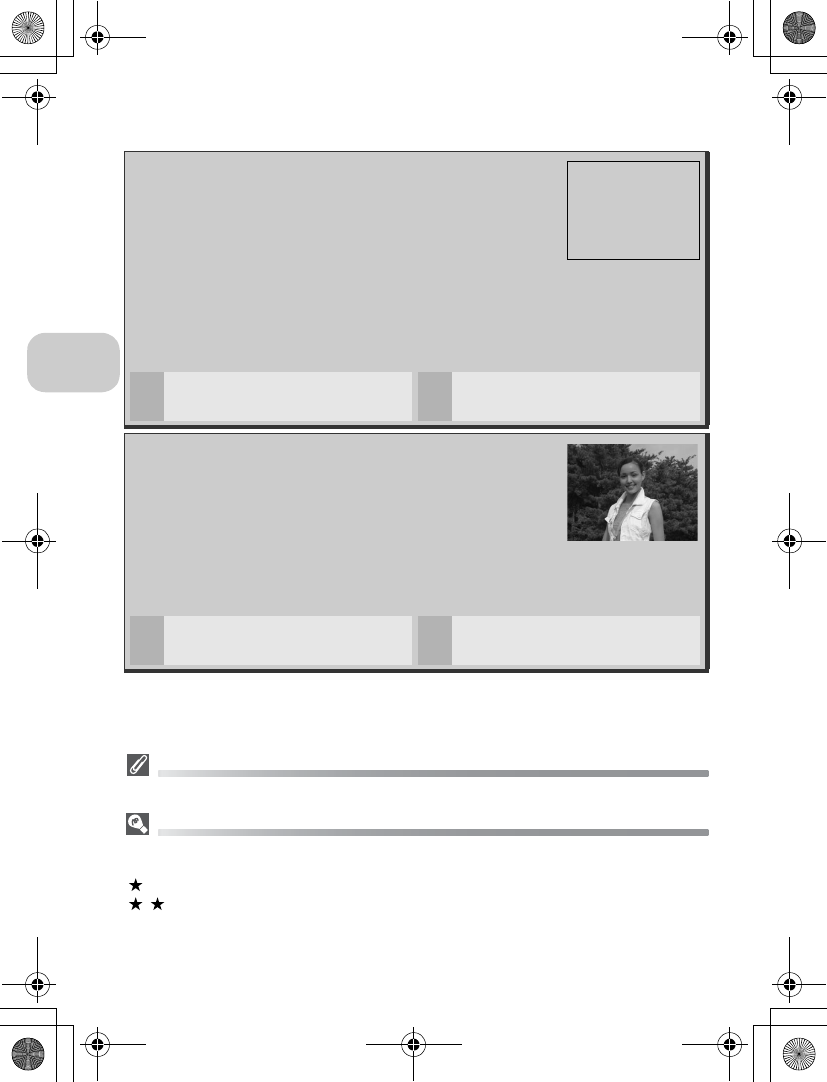
36
More on Photography
The following scenes are available:
Settings for Scene Modes
C and F indicate Flash and Focus mode respectively.
The J (Camera Shake) Icon
When the J icon appears in the monitor, pictures may be blurred. In this section, the pre-
cautions that you can take to avoid blur are indicated by stars:
hold the camera in both hands and brace elbows against your body.
use a tripod or rest the camera on a flat, level surface.
A PORTRAIT (FACE AF)
This function is optimal for photographing portraits (from the
waist up) of up to three people. When the camera recognizes
human faces, the square focus area is displayed and the subject
is in focus (Face-priority AF). When the shutter-release button
is pressed halfway, focus area is locked and the camera
focuses. Main subjects stand out clearly while background details are softened, lend-
ing sense of depth to composition.
See P.42 for more information on how to take pictures with this function.
For EFFECT 1, skin appears brighter, causing people to stand out.
For EFFECT 2, the surface of people’s skin appears smoother.
CA
(Changeable) FAutofocus
B PORTRAIT
Use for portraits. Main subject stands out clearly while back-
ground details are softened, lending composition sense of
depth.
For EFFECT 1, skin appears brighter, causing people to stand
out.
For EFFECT 2, the surface of people’s skin appears smoother.
•Degree of softening depends on amount of light available.
•Select from 99 areas to focus on in the focus area using the multi selector.
CA
(changeable) FAutofocus
en_q3175.book Page 36 Thursday, June 16, 2005 10:54 AM
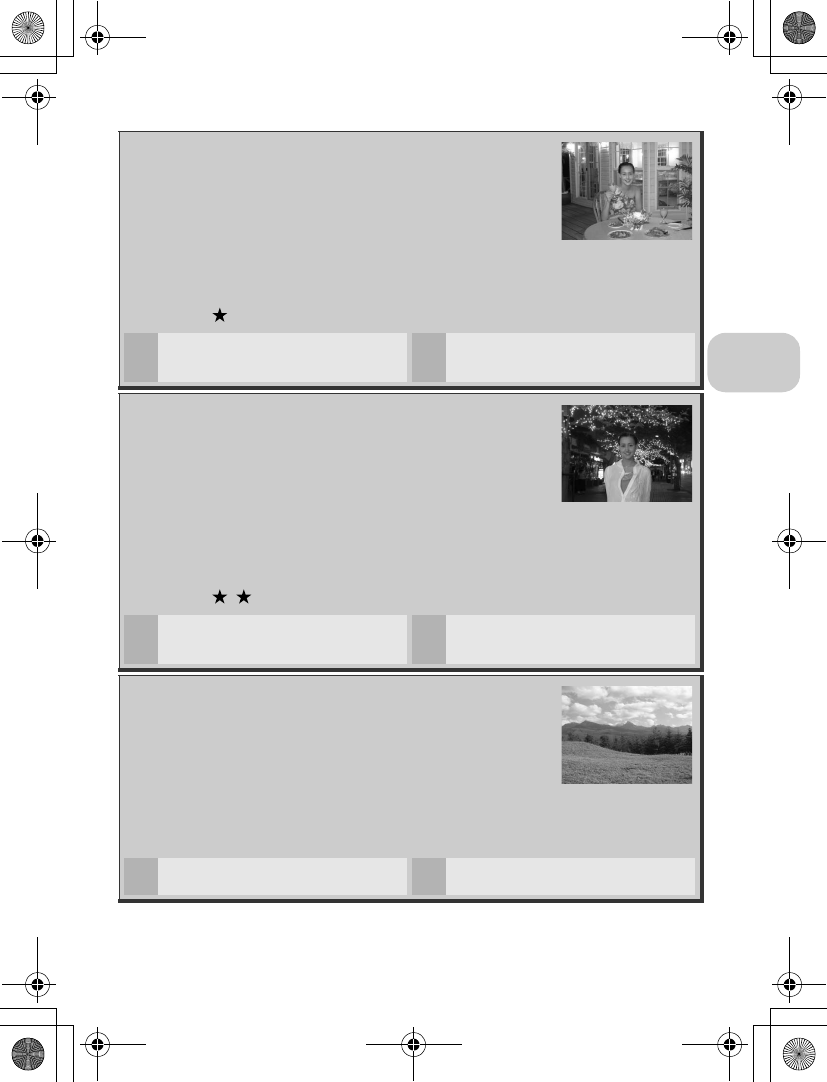
37
More on Photography
C PARTY/INDOOR
Use for shots that include details of the background, or to cap-
ture the effects of candlelight and other indoor background
lighting.
For EFFECT 1, pictures do not have as much noise and are
blurred less than with normal shooting. Shutter response is also
quicker than normal.
For EFFECT 2, pictures do not have as much noise and are blurred less, as with
EFFECT 1. However, backgrounds appear brighter than when using EFFECT 1.
•Blur level:
CA
(changeable) FAutofocus
D NIGHT PORTRAIT
Use for shots that provide natural balance between main sub-
ject and background when shooting portraits under low light.
For EFFECT 1, the brightness of the background is preserved ,
causing the subject to stand out.
For EFFECT 2, point sources of light radiate out in addition to
the effects for EFFECT 1. This causes the nightscape to stand out.
•Noise reduction turns on automatically at slow shutter speeds. It takes more time
than usual to store the picture.
•Select from 99 areas to focus on in the focus area using the multi selector.
•Blur level:
CA
(changeable) FAutofocus
E LANDSCAPE
Use for vivid landscape shots that enhance outlines, colors, and
contrast in such subjects as skyscapes and forests.
For EFFECT 1, colors are enhanced, causing landscape to
appear more vivid and clear.
For EFFECT 2, the blue color of the sky is captured more vividly.
•Camera focuses at infinity. Focus indicator lights whenever shutter-release button
is pressed halfway.
•AF-assist illuminator will not light even when lighting is poor.
C B F w
en_q3175.book Page 37 Thursday, June 16, 2005 10:54 AM
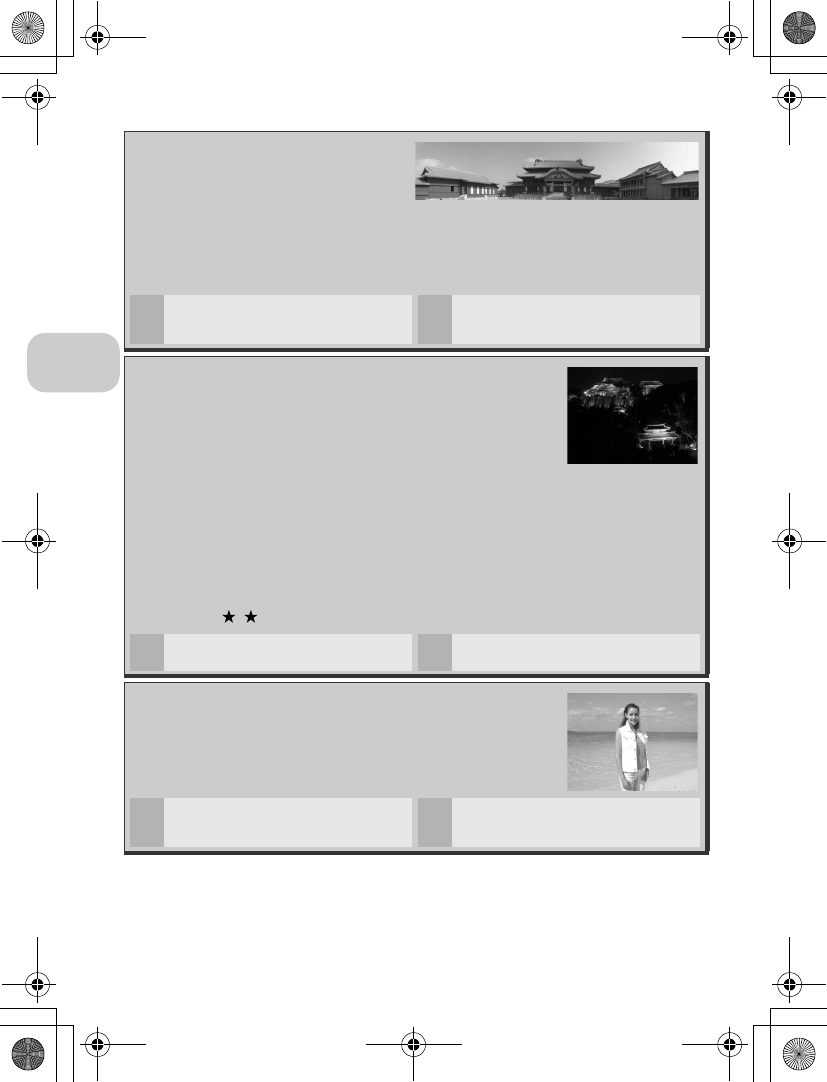
38
More on Photography
F PANORAMA ASSIST
Use when taking a series of pictures that
will later be joined to form a single
scene (for example, a panorama or 360°
virtual-reality image).
See P.43 for more information on how to take pictures with this function.
•Flash, Self-timer, Focus, and Exposure modes are fixed at settings for the first shot
in a series. Zoom is also fixed at the adjustment for the first shot in a series.
CB
(changeable) FAutofocus
(changeable)
G NIGHT LANDSCAPE
A slow shutter speed is used to produce stunning night land-
scapes.
For EFFECT 1, pictures do not have as much noise as with nor-
mal shooting. Use of a tripod is recommended.
For EFFECT 2, point sources of light radiate out in addition to
the effects for EFFECT 1. This causes the nightscape to stand out. Use of a tripod is
recommended.
•Focus is fixed at infinity. Focus indicator lights whenever shutter-release button is
pressed halfway.
•Noise reduction turns on automatically at slow shutter speeds. It takes more time
than usual to store the picture.
•AF-assist illuminator does not light even if for a dark subject.
•Blur level:
C B F w
H BEACH/SNOW
Vividly captures the brightness of such subjects as snowfields,
beaches, or sunlit expanses of water.
Cz
(changeable) FAutofocus
en_q3175.book Page 38 Thursday, June 16, 2005 10:54 AM
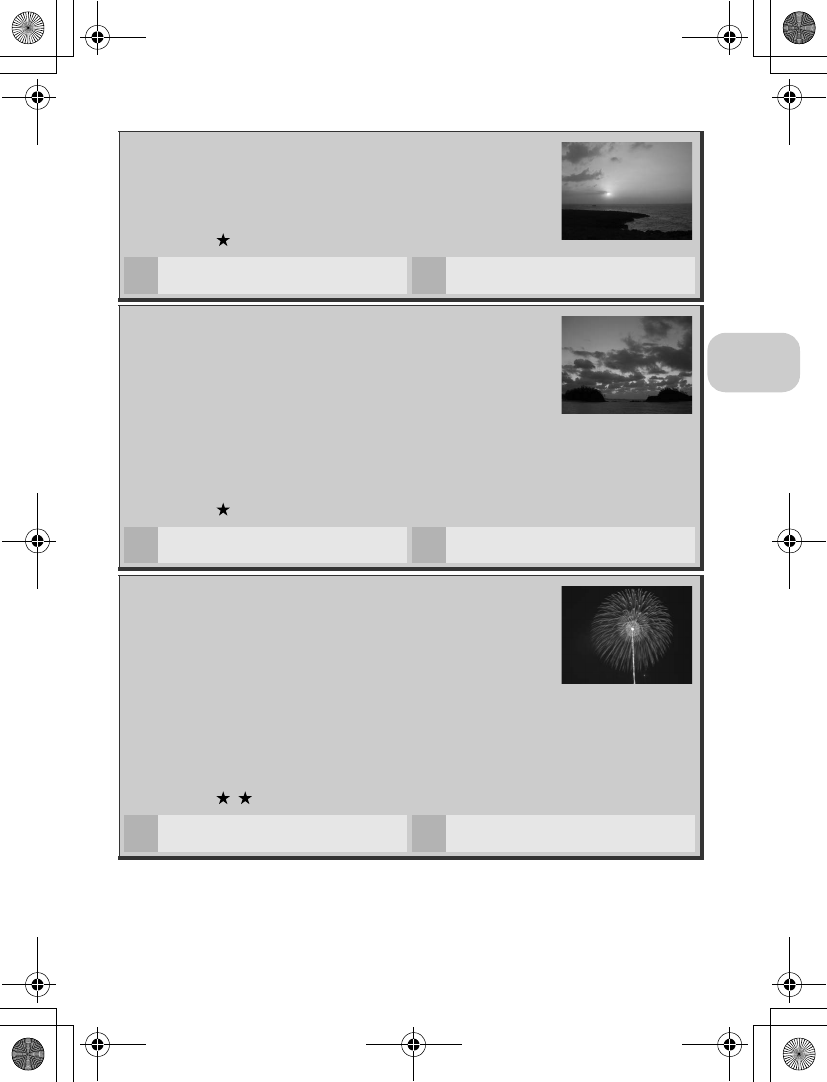
39
More on Photography
I SUNSET
Beautifully captures the deep hues in sunsets and sunrises.
For EFFECT 1, the red hues are captured more vividly.
For EFFECT 2, the colors of the sunset and sunrise are pre-
served.
•Blur level:
C B F Autofocus
J DUSK/DAWN
Beautifully captures the colors in the weak natural light before
sunrise or after sunset.
For EFFECT 1, blue colors are captured more vividly.
For EFFECT 2, the colors of the landscape are preserved.
•Camera focuses at infinity. Focus indicator lights whenever
shutter-release button is pressed halfway.
•Noise reduction turns on automatically at slow shutter speeds. It takes more time
than usual to store the picture.
•AF-assist illuminator does not light even if for a dark subject.
•Blur level:
C B F w
K FIREWORKS SHOW
The contrast with the background is deepened and fireworks
stand out.
For EFFECT 1, pictures are shot with a slower shutter speed.
Pictures may contain more noise than normal.
For EFFECT 2, large fireworks that burst slowly are clearly cap-
tured along with their trail.
•Focus is fixed at infinity. Focus indicator lights whenever shutter-release button is
pressed halfway.
•Exposure compensation cannot be used.
•AF-assist illuminator does not light even if for a dark subject.
•Blur level:
C B F w
en_q3175.book Page 39 Thursday, June 16, 2005 10:54 AM
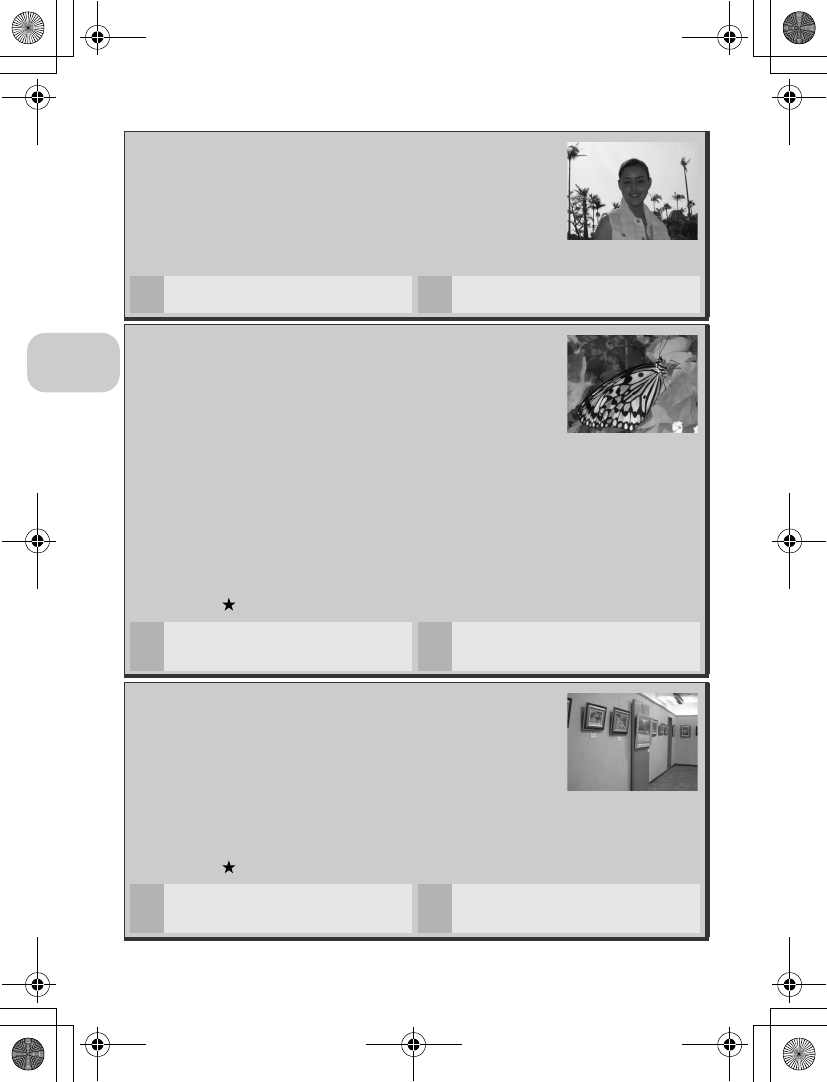
40
More on Photography
L BACK LIGHT
Use when light is coming from behind your subject, throwing
their features into shadow, or when your subject is in the shade
but the background is brightly lit.
For EFFECT 1, people appear brighter than normal.
For EFFECT 2, the picture is shot to match the brightness of
people. Use this effect when people still appear dark using EFFECT 1.
C C F Autofocus
M CLOSE UP
Use to capture vivid colors in close-up shots of flowers, insects,
and other small objects, with the background artistically
blurred.
For EFFECT 1, subject is captured more vividly and clearly.
For EFFECT 2, background details are softened and shutter
response is quicker. Optimal for capturing moving subjects such as flowers swaying
in the breeze.
•To focus on objects as close as 4 cm (1.6") to the lens, adjust zoom until the macro
close-up icon (F) in monitor turns green.
•Minimum focus distance varies with zoom position.
•The camera focuses continuously, until AF lock is set by pressing the shutter-
release button halfway.
•Select from 99 areas to focus on in the focus area using the multi selector.
•Blur level:
CB
(changeable) F F
N MUSEUM
Use indoors where flash photography is prohibited (for exam-
ple, in museums and art galleries) or in other indoor settings
where you do not want to use the flash.
•The Best Shot Selector (BSS; c92) turns on automatically,
reducing the effects of inadvertent camera movement.
•Photography may be prohibited altogether in some locations. Be sure to obtain
permission first.
•AF-assist illuminator does not light even if for a dark subject.
•Blur level:
C B F Autofocus
(changeable)
en_q3175.book Page 40 Thursday, June 16, 2005 10:54 AM
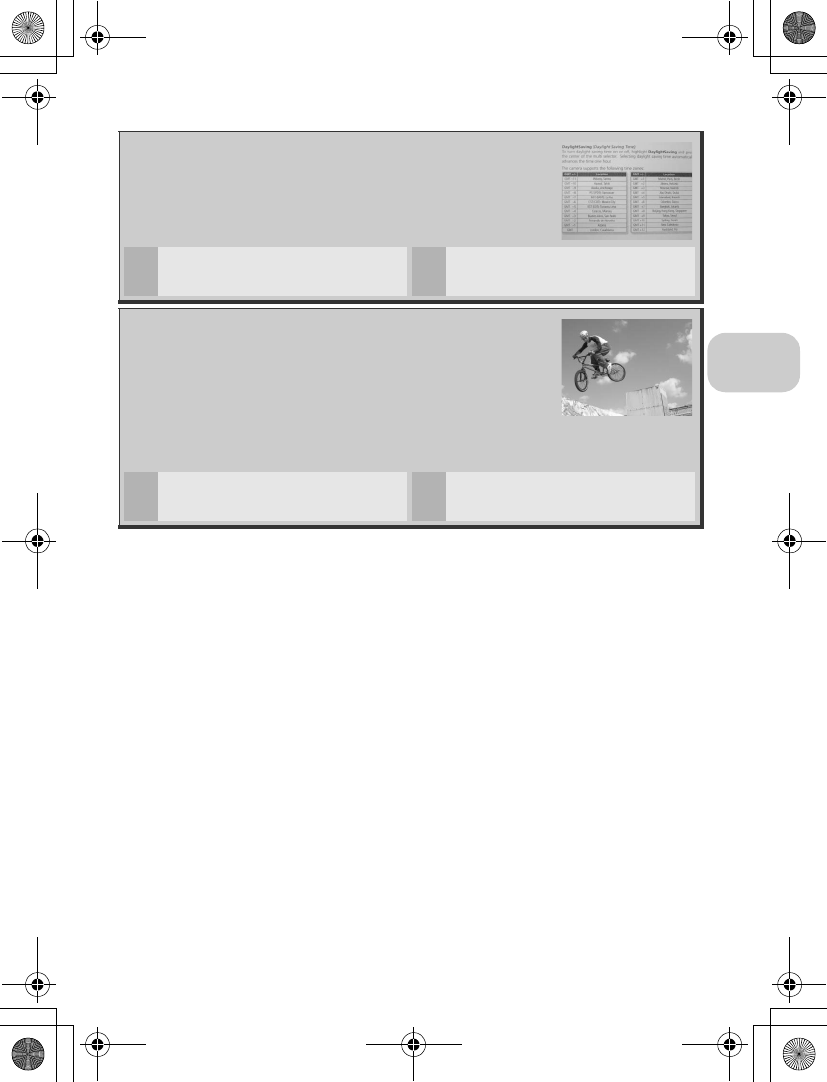
41
More on Photography
O COPY
Provides clear pictures of text or drawings on a white board or
in printed matter such as a business card.
•Colored text and drawings may not show up well in the final
picture.
CB
(changeable) FAutofocus
(changeable)
P SPORTS
Fast shutter speeds freeze motion for dynamic sports shots.
•Camera focuses continuously on center of frame until shut-
ter-release button is pressed halfway to lock focus.
•While shutter-release button is fully pressed, camera shoots
at about XXX frames per second; monitor turns off.
•Focus, exposure, and auto white balance are determined by first shot in each
series.
C B F Autofocus
(changeable)
en_q3175.book Page 41 Thursday, June 16, 2005 10:54 AM
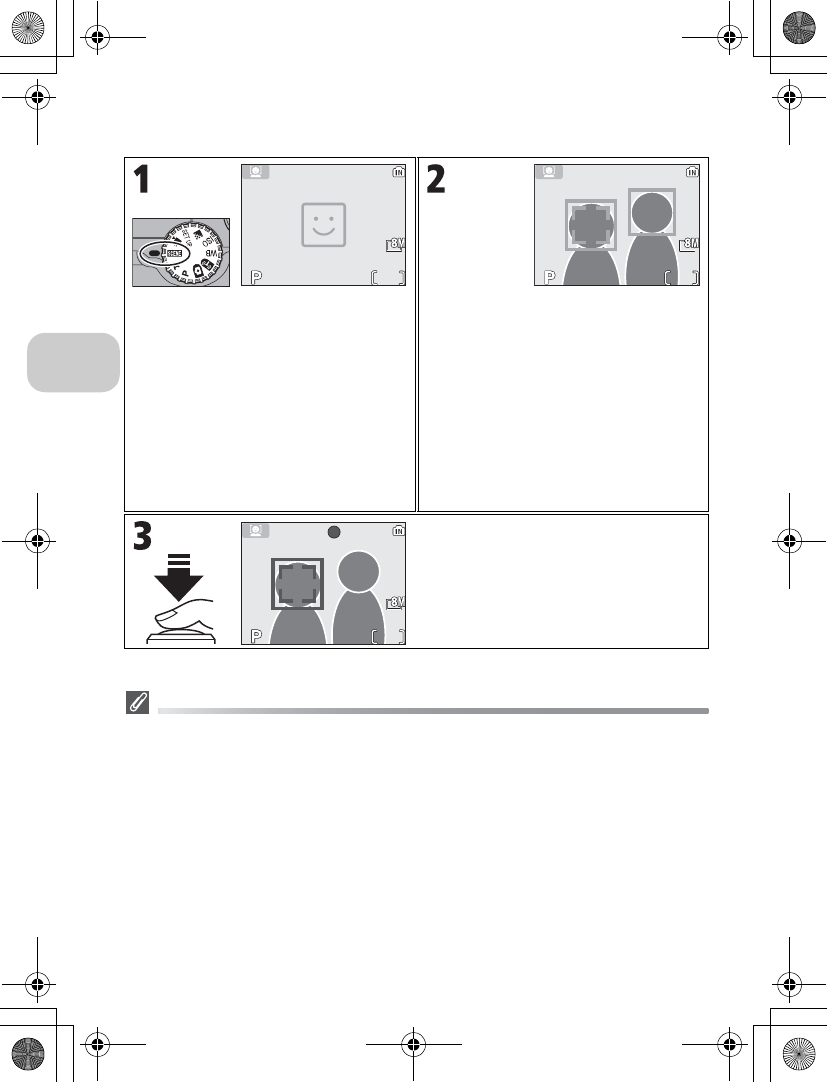
42
More on Photography
To use A PORTRAIT (FACE AF):
PORTRAIT (FACE AF) - Face-priority AF
•The camera focuses continuously, until the camera recognizes a subject’s face.
•When the camera does not recognize a face, the object at the center of the frame is fo-
cused.
•Optical zoom is available in the PORTRAIT (FACE AF) mode, but digital zoom (c20) does
not work.
•The face selected for focusing by the camera varies depending upon a number of condi-
tions including the direction in which each person is facing.
•The camera is unable to recognize human faces in the following situations:
-The subject is wearing sunglasses or part of face is obstructed in some other way.
-The subject is facing sideways.
-A portion of the face is too big because the subject is too close to the camera.
-A portion of the face is too small because the subject is too far away from the camera.
Rotate the mode dial to b. K blinks in
the center of the monitor (default set-
ting).
•K indicates the size of a subject’s face
that the camera can recognize.
•If a different Scene menu is selected,
press m button and select A.
When the subject’s face becomes almost
the same size as K, the camera recog-
nizes it and is framed with L (yellow).
•When the camera recognizes more
than one face, the closest and largest
is framed with L (yellow) and the oth-
ers with M (yellow). The camera can
recognize up to three faces.
•If the frame (L or M) disappears
because the subject moves, the cam-
era goes back to the screen in step 1.
Press the shutter-release button halfway
to lock the focus on the face framed with
L (yellow). When focus is locked, the
color changes from yellow to green. Press
the shutter-release button the rest of the
way down to take the picture.
NORM
NORM
15
15
1/60
1/60
F2.7
F2.7
NORM
NORM
15
15
1/60
1/60
F2.7
F2.7
NORM
NORM
AF
AF
15
15
1/60
1/60
F2.7
F2.7
en_q3175.book Page 42 Thursday, June 16, 2005 10:54 AM
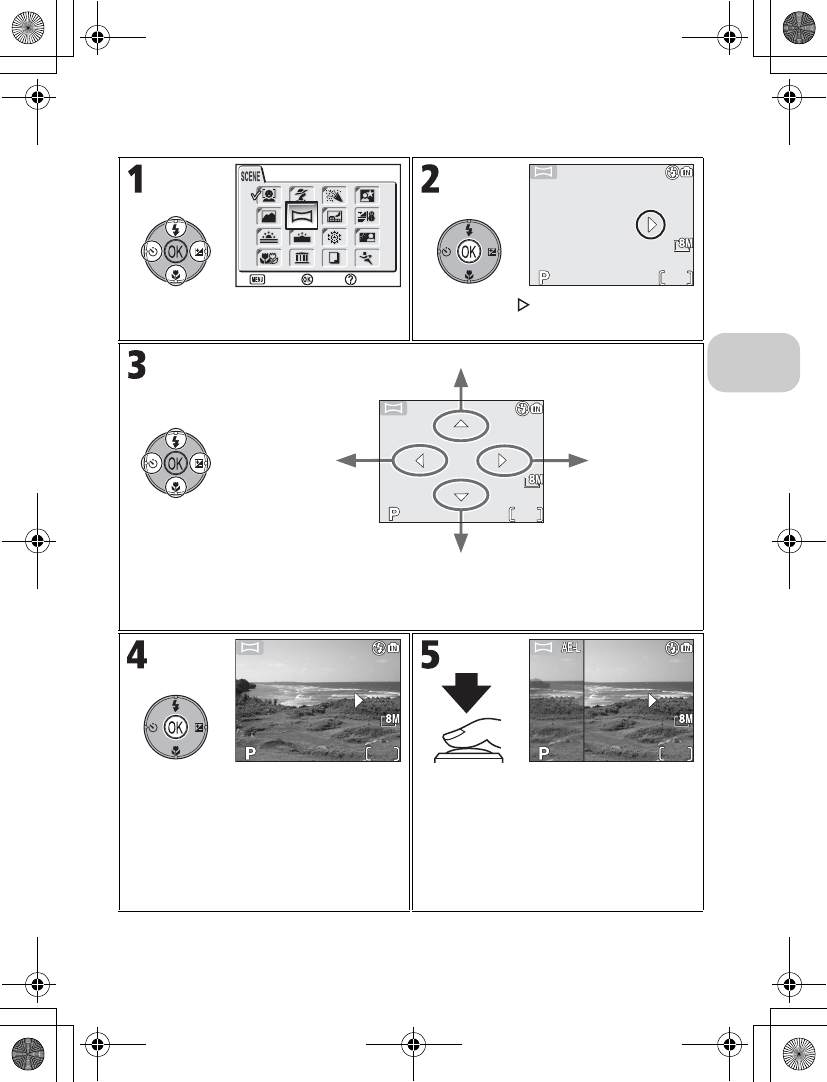
43
More on Photography
To use F PANORAMA ASSIST:
Select F (PANORAMA ASSIST) in Scene
menu.
Pan direction ( ) displayed in yellow.
Select how pictures will be joined together in completed panorama. This is the direc-
tion in which to pan the camera after each shot.
Make selection (to change selected pan
direction, press d again and repeat steps
3 and 4). Pan direction displayed in white.
Take first picture. G icon is displayed,
and white balance and exposure com-
pensation are locked. About one third of
picture is shown superimposed on view
through lens (if pan direction is left to
right, picture will appear on left side of
monitor).
PANORAMA ASSIST
Confirm
Exit Help
NORM
NORM
15
15
1/60
1/60
F2.7
F2.7
NORM
NORM
15
15
1/60
1/60
F2.7
F2.7
Right to left Left to right
Top to bottom
Bottom to top
NORM
NORM
15
15
1/60
1/60
F2.7
F2.7
NORM
NORM
15
15
1/60
1/60
F2.7
F2.7
en_q3175.book Page 43 Thursday, June 16, 2005 10:54 AM
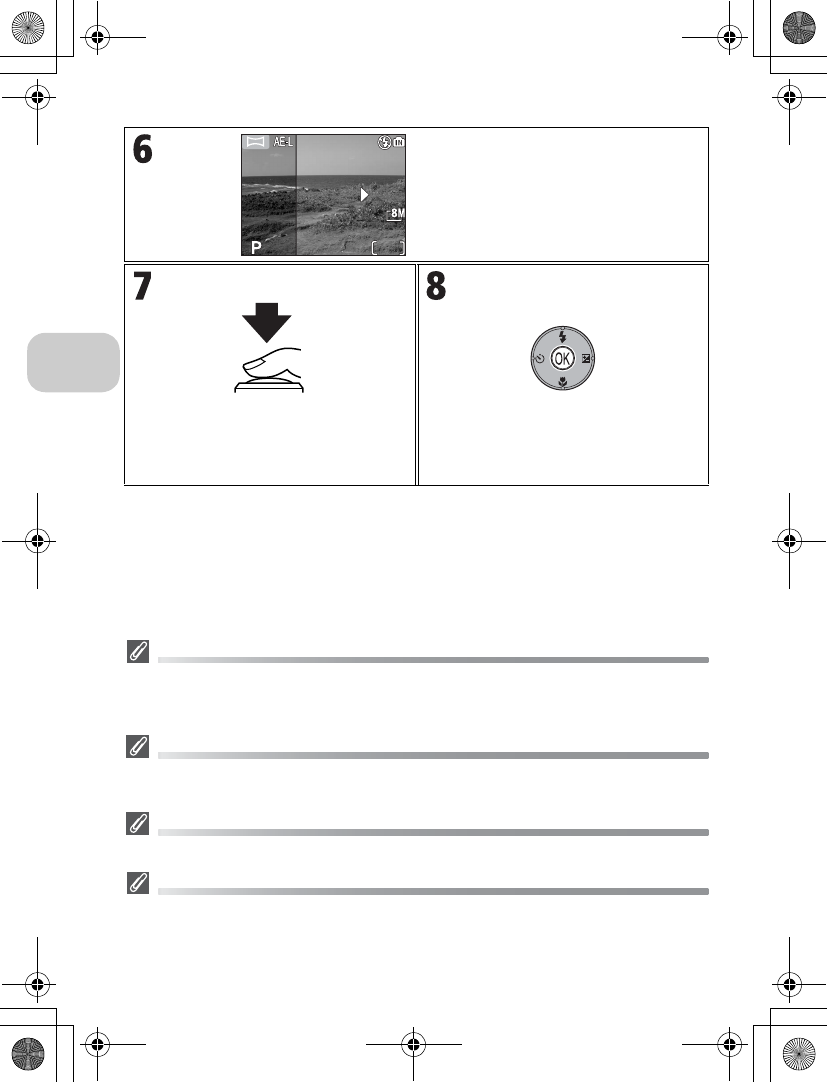
44
More on Photography
Panorama Assist
The pan direction, Flash mode, Self-timer mode, Focus mode, and Exposure compensation
cannot be changed after the first picture is taken. To change the pan direction, press the
m button to end shooting and repeat steps 1 to 3.
Full-Screen Playback
When you press the i button after starting shooting, Panorama assist mode is terminated
and the most recent picture will be displayed in the monitor.
Using a Tripod
Using a tripod makes it easier to compose overlapping shots.
Joining Panorama Pictures
Transfer the pictures taken with FPANORAMA ASSIST to your computer (c61) and use
the Panorama Maker function in PictureProject to join them into a single scene. For further
information, see the PictureProject Reference Manual (on CD).
Compose the next shot to overlap with
the previous picture.
Take next shot. Repeat steps 6 and 7 until
all shots in series have been taken.
End series.
•Shooting will also end if changing mode
using the mode dial or entering Standby
mode.
NORM
NORM
15
15
1/60
1/60
F2.7
F2.7
en_q3175.book Page 44 Thursday, June 16, 2005 10:54 AM
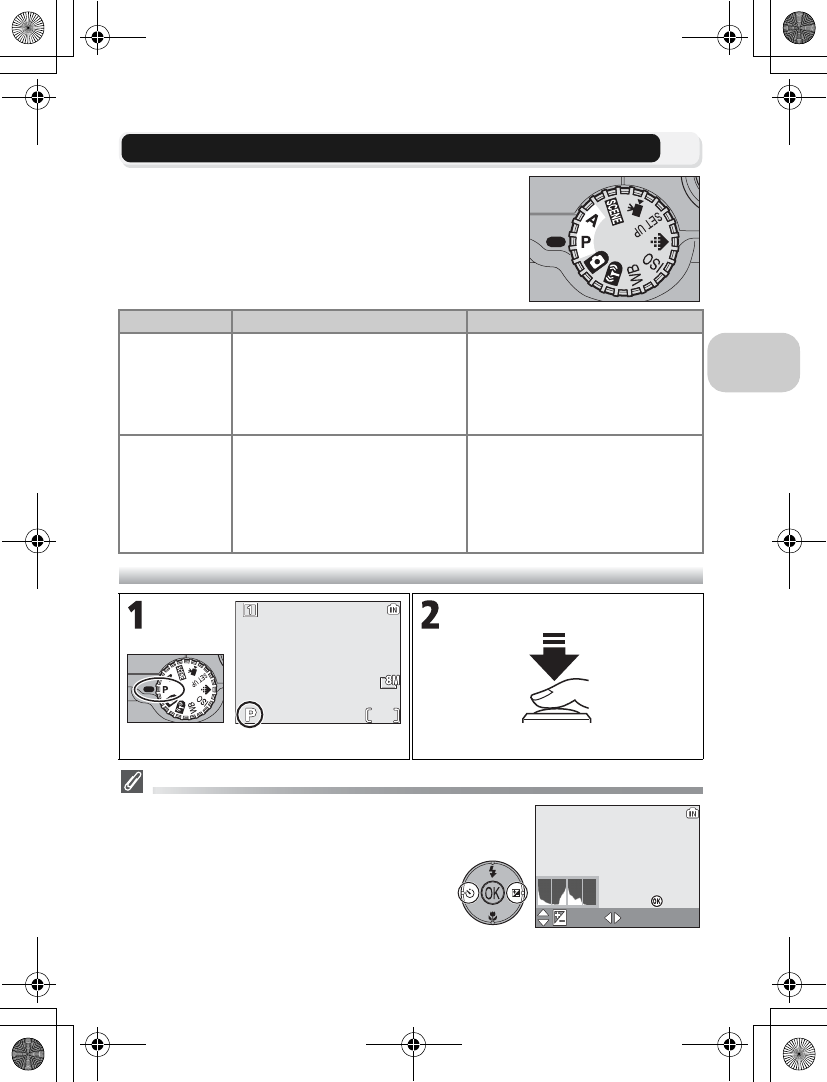
45
More on Photography
Controlling Exposure: Exposure Modes
In P and A modes, shutter speed and aperture can be
adjusted to suit the user’s creative intent.
P and A modes also give the user control over sensitivity
(ISO equivalency; c50), white balance (c52), and the
options in the Shooting menu (c86).
P: Programmed Auto
Flexible Program
In P mode, different combinations of shutter speed
and aperture can be selected by pressing the multi
selector right (“flexible program”). Press the multi
selector right or left to switch from one to the other.
While flexible program is in effect, shutter speed
and aperture are displayed yellow (otherwise, they
are displayed white), and an asterisk (“*”) appears
next to the exposure mode indicator in the shooting
display. Default values can be restored by turning
the camera off.
Mode How it works When to use it
P
Programmed
auto
Camera sets shutter speed and
aperture for optimal exposure.
“Flexible program” can be used to
select additional combinations of
shutter speed and aperture that
will produce the same exposure.
Recommended for most situa-
tions.
A
Aperture-
priority auto
User chooses aperture: camera
sets shutter speed for best
results.
Large apertures (small f/-numbers)
soften background details and let
more light into camera, increasing
range of flash. Small apertures
(large f/-numbers) increase depth
of field, bringing main subject and
background into focus.
Rotate the mode dial to P. Frame picture, focus, and shoot.
15
15
NORM
NORM
F2.7
F2.7
0
0
:
Exit
:
Exit
1/60
1/60
en_q3175.book Page 45 Thursday, June 16, 2005 10:54 AM
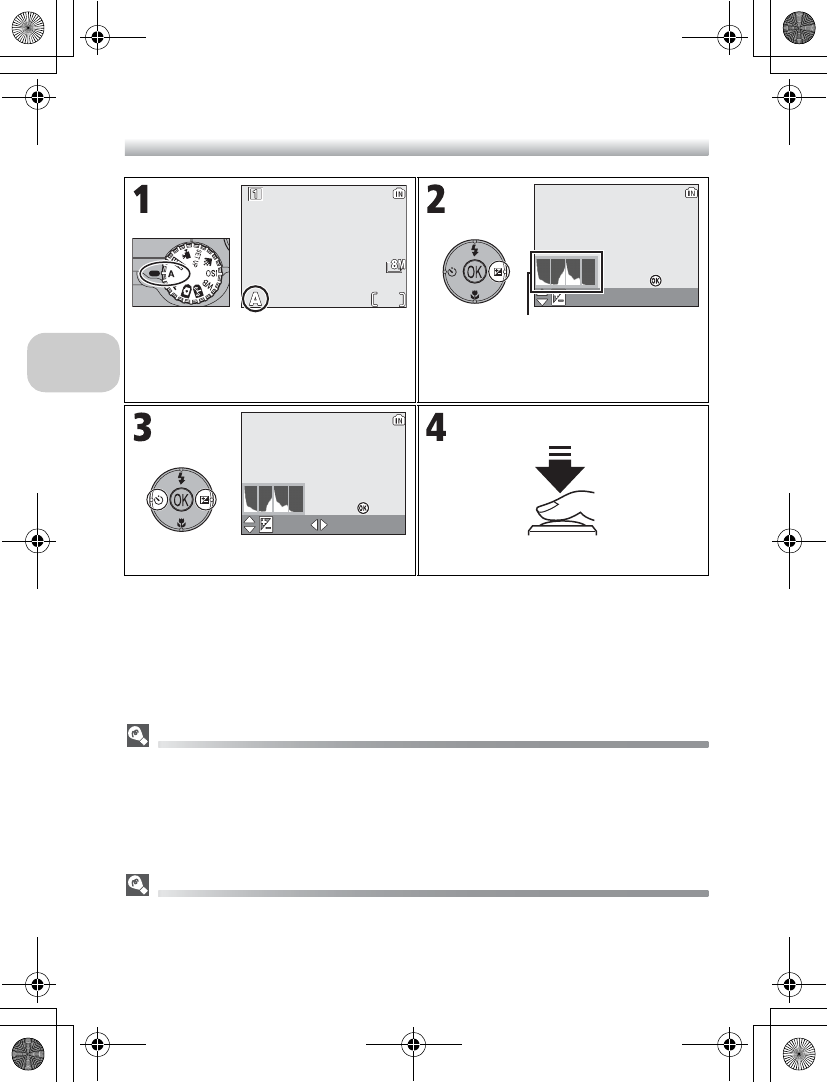
46
More on Photography
A: Aperture-Priority Auto
If the selected aperture would result in the picture being under- or over-exposed,
the aperture display in the monitor will flash when the shutter-release button is
pressed halfway. Choose another aperture and try again.
An aperture of f/XXX may not be available at some zoom positions. For smaller
apertures, try zooming the camera out.
Aperture and Zoom
The maximum and minimum values for aperture are determined by the camera lens and
zoom setting. Unless On is chosen for Fixed aperture (c100), aperture will change as
the camera is zoomed in or out. If the second-highest aperture setting is selected with the
camera zoomed all the way out and the camera is then zoomed in, the camera will vary
the f/-number to maintain aperture at the second-highest setting for the current zoom po-
sition.
Faster Shutter Speeds
Depending on the amount of light available, it may be possible to achieve shutter speeds as
high as 1/2,000 s by selecting an aperture of f/XXX (maximum zoom) or between f/XXX and
f/XXX (widest angle).
Rotate the mode dial to A. Display value for exposure compensation
(exposure compensation setting screen)
and histogram (distribution of tones).
Select aperture. Frame picture, focus, and shoot.
15
15
NORM
NORM
:
Exit
:
Exit
0
0
Histogram
F2.7
F2.7
0
0
:
Exit
:
Exit
en_q3175.book Page 46 Thursday, June 16, 2005 10:54 AM
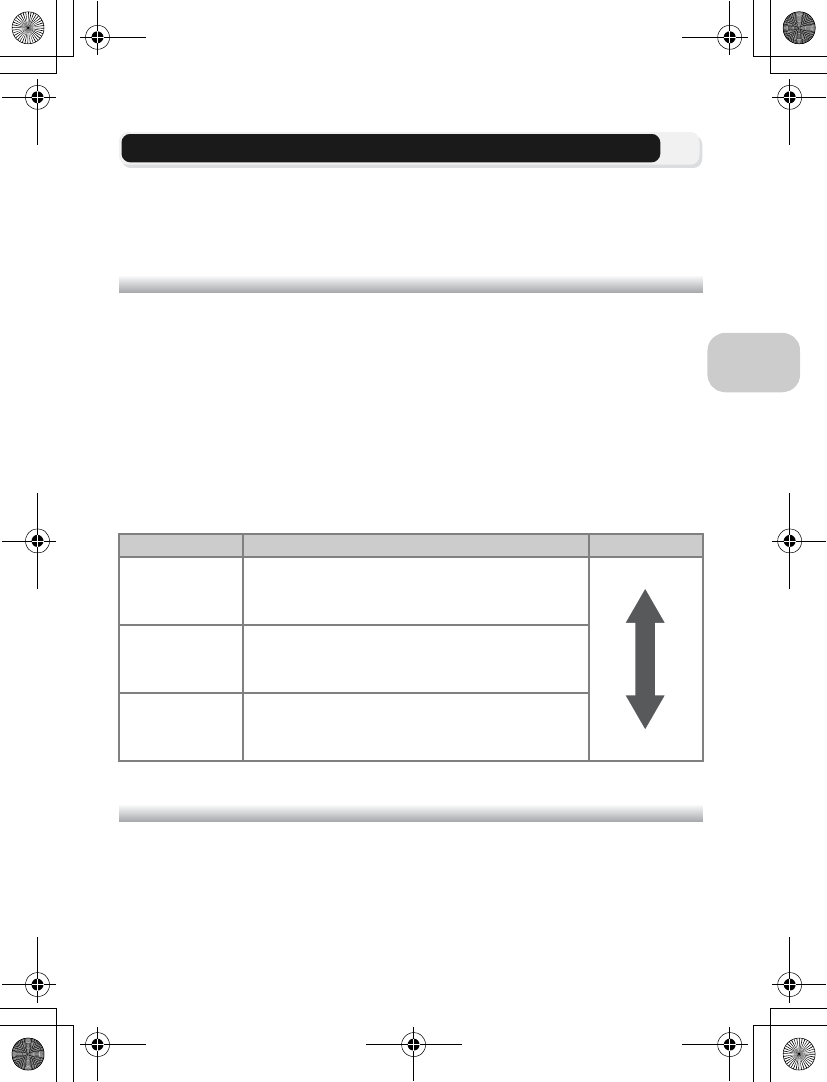
47
More on Photography
Z
Controlling File Size: Selecting Image Quality and Size
The size of the files, and with it the number of images that can be recorded on
the memory or the memory card, depends on the size and quality of the images.
Before shooting, choose an image quality and size according to how you plan to
use the picture.
Image Quality
The process of reducing the file size of a picture when storing it is called compres-
sion. In this camera, pictures are compressed and recorded as JPEG files.
The more a picture is compressed, the smaller the picture size becomes and the
larger the number of pictures that can be stored in memory or on a memory card.
However, the quality of the image is degraded and the reproducibility of the im-
age’s fine areas is reduced.
The less a picture is compressed, the larger the picture size becomes and the
smaller the number of pictures that can be stored in memory or on a memory
card. However, it maintains the presentation of the image’s fine areas and increas-
es the image quality.
Select from the following three options.
Image Size
Smaller images create smaller files suitable for transmission by e-mail or for use in
web pages.
When printed in larger sizes, however, small images will be rough and uneven in
appearance. The size of images when printed depends on the printer resolution:
the higher the resolution, the smaller the final print size.
Option Description
Compression
Y
FINE
Fine image quality, suitable for enlargements or
high quality prints. File size reduced to roughly
1/4 of its original size.
Z
NORMAL
(default setting)
Normal image quality, suited to most applica-
tions. File size reduced to roughly 1/8 of its origi-
nal size.
a
BASIC
Basic image quality, suitable for pictures that will
be distributed by e-mail or used in web pages. File
size reduced to roughly 1/16 of its original size.
Low
High
en_q3175.book Page 47 Thursday, June 16, 2005 10:54 AM
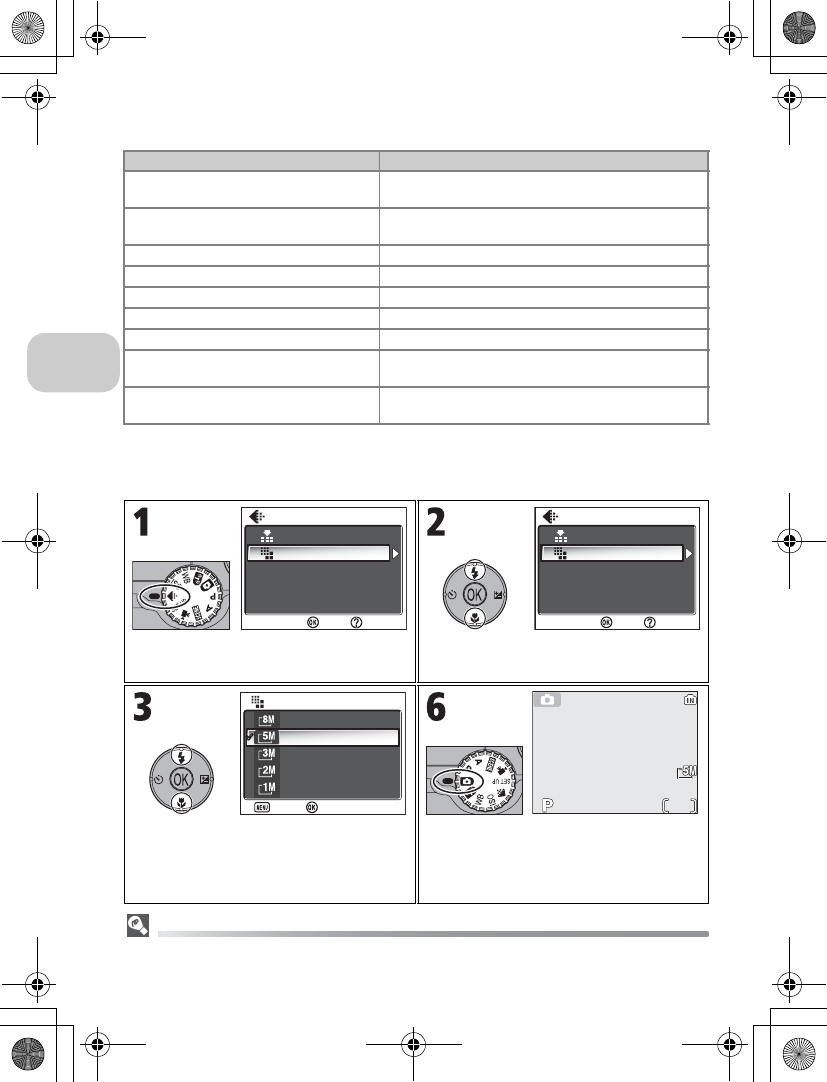
48
More on Photography
Select from the following options according to your shooting intent.
* All figures are approximate. Print sizes assume a printer resolution of approximately 300dpi. The
size of images when printed depends on the printer resolution: the higher the resolution, the
smaller the final print size.
To choose image quality or size:
The Shooting Menu
Image quality and size can also be set in the Shooting menu (c86).
Image size (pixels) Print size (cm)*
c 3264 × 2448
(default setting for P1) 28 × 21 (11" × 8")
d 2592 × 1944
(default setting for P2) 22 × 16 (8.6"× 6.5")
e 2048 × 1536 17 × 13 (6.7"× 5.1")
f 1600 × 1200 14 × 10 (5.3"× 4")
g 1280 × 960 11 × 8 (4" × 3")
h 1024 × 768 9 × 7 (3.4"× 2.6")
i 640 × 480 5 × 4 (2.1"× 1.6")
j 3264 × 2176
(for P1) 28 × 18 (11" × 7")
j 2592 × 1728
(for P2) 28 × 15 (11" × 5.8")
IMAGE MODE menu is displayed. Highlight Image quality or Image size
and press d.
Highlight option and press d. Rotate mode dial to X, b, P, A or
Y (when Shoot & Transfer is
selected.). Current image quality and size
displayed in monitor.
Image quality
Image size
Exit
IMAGE MODE
IMAGE MODE
Confirm
Confirm
Help
Help
Image quality
Image size
Exit
IMAGE MODE
IMAGE MODE
Confirm
Confirm
Help
Help
3264×2448
2592×1944
IMAGE SIZE 1/2
IMAGE SIZE 1/2
2048×1536
1600×1200
1280×960
Confirm
Exit
24
24
NORM
NORM
1/60
1/60
F2.7
F2.7
en_q3175.book Page 48 Thursday, June 16, 2005 10:54 AM